

INSTRUCTOR SOLUTIONS MANUAL
TIM BRITT
Jackson State Community College
P RECALCULUS
TWELFTH EDITION
Michael Sullivan
Chicago State University

Copyright © 2025, 2020, 2016 by Pearson Education, Inc. or its affiliates. All Rights Reserved. Manufactured in the United States of America. This publication is protected by copyright, and permission should be obtained from the publisher prior to any prohibited reproduction, storage in a retrieval system, or transmission in any form or by any means, electronic, mechanical, photocopying, recording, or otherwise. For information regarding permissions, request forms, and the appropriate contacts within the Pearson Education Global Rights and Permissions department, please visit www.pearsoned.com/permissions/
PEARSON and MYLAB are exclusive trademarks owned by Pearson Education, Inc. or its affiliates in the U.S. and/or other countries.
Unless otherwise indicated herein, any third-party trademarks, logos, or icons that may appear in this work are the property of their respective owners, and any references to third-party trademarks, logos, icons, or other trade dress are for demonstrative or descriptive purposes only. Such references are not intended to imply any sponsorship, endorsement, authorization, or promotion of Pearson’s products by the owners of such marks, or any relationship between the owner and Pearson Education, Inc., or its affiliates, authors, licensees, or distributors
Chapter 1 Graphs
Table of Contents
Chapter 2
Chapter 3
3.1
Chapter
4.1
Chapter 5 Exponential and Logarithmic Functions
5.1
5.2
5.3
5.4
5.5
5.6
5.7
5.8
5.9
Chapter 6 Trigonometric Functions
6.1
6.2
6.3
6.4
6.5
Chapter 7 Analytic Trigonometry
7.1
7.2
Chapter 8 Applications of Trigonometric Functions
8.1
Chapter 9 Polar Coordinates; Vectors
9.5
Chapter 10 Analytic Geometry
10.5
Chapter 11 Systems
Chapter 12 Sequences; Induction; the Binomial Theorem
Chapter 13 Counting and Probability
13.1
Chapter 14 A Preview of Calculus: The Limit, Derivative, and Integral of a
14.1
14.2
14.5
Appendix A
A.1
A.7
A.8
A.9 Interval
A.10
Appendix
B Graphing Utilities
B.1 The Viewing Rectangle ........................................................................................................ 1544
B.2 Using a Graphing Utility to Graph Equations ...................................................................... 1545
B.3 Using a Graphing Utility to Locate Intercepts and Check for Symmetry ............................ 1550
B.5 Square Screens ..................................................................................................................... 1552
Chapter 1 Graphs
Section 1.1
1. 0
2. 5388
3. 22 34255
4. 22 116012136003721612
Since the sum of the squares of two of the sides of the triangle equals the square of the third side, the triangle is a right triangle.
5. 1 2 bh
6. true
7. x-coordinate or abscissa; y-coordinate or ordinate
8. quadrants
9. midpoint
10. False; the distance between two points is never negative.
11. False; points that lie in Quadrant IV will have a positive x-coordinate and a negative y-coordinate. The point 1,4 lies in Quadrant II.
12. True; 1212 , 22 x xyy
13. b
14. a
15. (a) Quadrant II
(b) x-axis
(c) Quadrant III
(d) Quadrant I (e) y-axis
(f) Quadrant IV
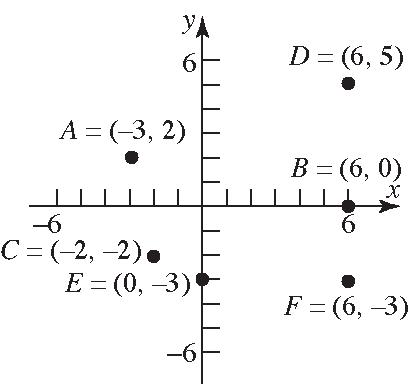
16. (a) Quadrant I
(b) Quadrant III
(c) Quadrant II
(d) Quadrant I
(e) y-axis
(f) x-axis
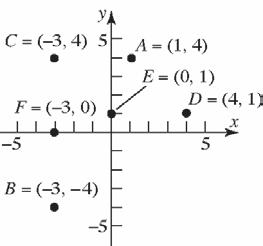
17. The points will be on a vertical line that is two units to the right of the y-axis.
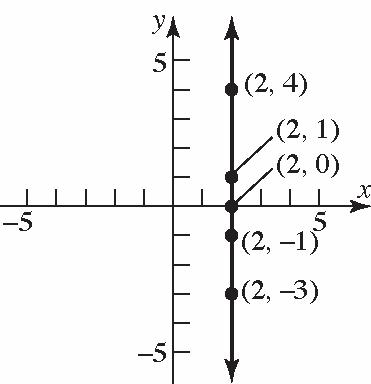
18. The points will be on a horizontal line that is three units above the x-axis.
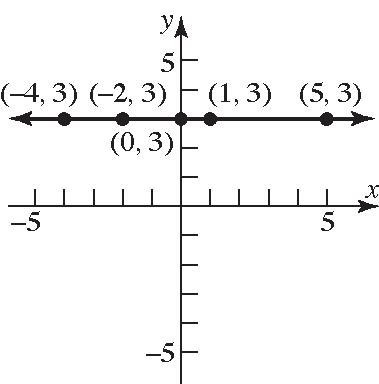
19. 22 12 22 (,)(20)(10) 21415
dPP
20. 22 12 22 (,)(20)(10) (2)1415
dPP
21. 22 12 22 (,)(21)(21) (3)19110
dPP
22. 2 2 12 22 (,)2(1)(21) 319110
23.
2 12 2 2 (,)(53)44 2846468217 dPP
24. 2 2 12 2 2 (,)2140 34916255
dPP
dPP
25. 2 2 12 22 (,)4(7)(03) 11(3)1219130
26. 22 12 22 (,)422(3) 2542529 dPP
dPP
27. 2 2 12 22 (,)(65)1(2) 131910
28. 22 12 22 (,)6(4)2(3) 10510025 12555 dPP
dPP
29. 22 12 22 (,)2.3(0.2)1.1(0.3) 2.50.86.250.64 6.892.62
30.
dPP
22 12 22 (,)0.31.21.12.3 (1.5)(1.2)2.251.44 3.691.92
31. 22 12 2222 (,)(0)(0) ()() dPPab abab
32. 22 12 22 222 (,)(0)(0) ()() 22 dPPaa aa aaaa
33. (2,5),(1,3),(1,0)ABC
2 2 22 2 2 22 2 2 22 (,)1(2)(35) 3(2)9413 (,)11(03) (2)(3)4913 (,)1(2)(05) 1(5)12526 dAB dBC dAC
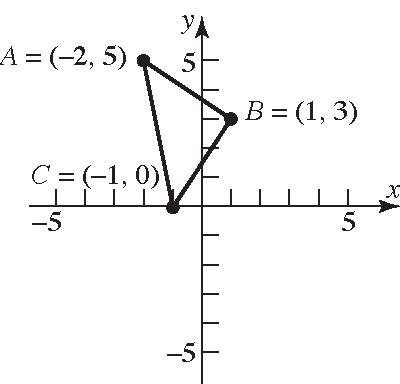
Verifying that ∆ ABC is a right triangle by the Pythagorean Theorem:
The area of a triangle is 1 2 A bh . In this problem,
1964200
(,)1012(113) (2)(14) 4196200 102 (,)10(2)(115) 12(16) 144256400 20 dAB dBC dAC
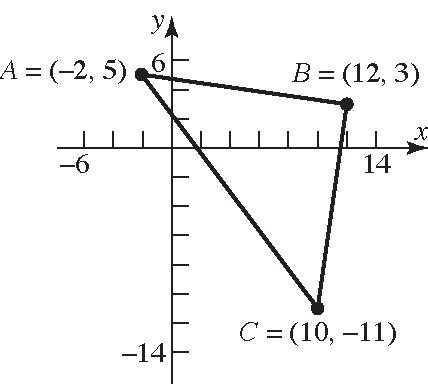
Verifying that ∆ ABC is a right triangle by the Pythagorean Theorem:
Section1.1: The Distance and Midpoint Formulas
222 22 2 (,)(,)(,) 10210220 200200400 400400 dABdBCdAC
The area of a triangle is 1 2 A bh . In this problem, 1 (,)(,)
35. (5,3),(6,0),(5,5)ABC
dAB dBC dAC
2 2 22 2 2 22 2 2 22 (,)6(5)(03) 11(3)1219 130 (,)56(50) (1)5125 26 (,)5(5)(53) 1021004 104 226
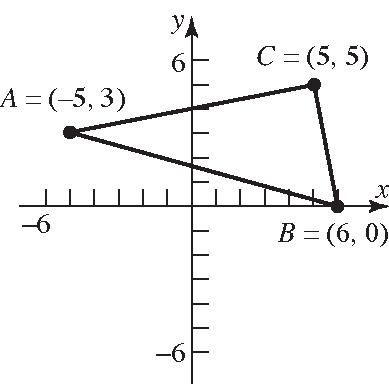
Verifying that ∆ ABC is a right triangle by the Pythagorean Theorem:
The area of a triangle is 1 2 A bh . In this problem,
1 (,)(,)
10426
dAB dBC dAC
(,)3(6)(53) 9(8)8164 145 (,)13(5(5)) (4)1016100 116229 (,)1(6)(53) 52254 29
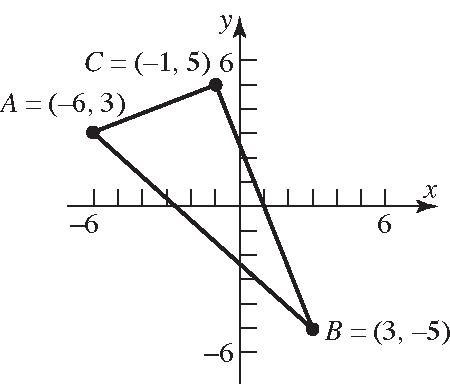
Verifying that ∆ ABC is a right triangle by the Pythagorean Theorem:
222 222 (,)(,)(,) 29229145 29429145 29116145 145145 dACdBCdAB The area of a triangle is 1 2 A bh . In this problem,
1 (,)(,) 2 1 29229 2 1 229 2 29 square units A dACdBC
37. (4,3),(0,3),(4,2)ABC
2 2 22 22 22 2 2 22 (,)(04)3(3) (4)0160 16 4 (,)402(3) 451625 41 (,)(44)2(3) 05025 25 5 dAB dBC dAC
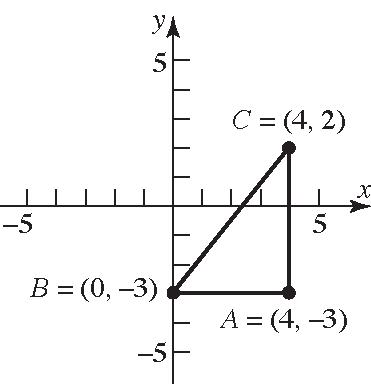
Verifying that ∆ ABC is a right triangle by the Pythagorean Theorem:
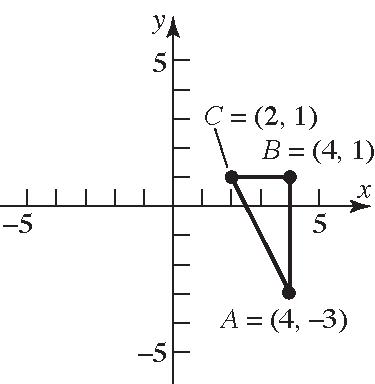
Verifying that ∆ ABC is a right triangle by the Pythagorean Theorem:
Section1.1: The Distance and Midpoint Formulas
22 (,)(,)(,) 4225 16420 2020 dABdBCdAC
The area of a triangle is 1 2 A bh . In this problem,
1 (,)(,) 2
39. The coordinates of the midpoint are: (,),1212 22 44 35 , 22 80 , 22 (4,0) x xyy xy
40. The coordinates of the midpoint are: (,),1212 22 2204 , 22 04 , 22 0,2 x xyy xy
41. The coordinates of the midpoint are: (,),1212 22 1840 , 22 74 , 22 7 ,2 2
x xyy xy
42. The coordinates of the midpoint are: (,),1212 22 2432 , 22 61 , 22 1 3, 2 x xyy xy
43. The coordinates of the midpoint are: (,),1212 22 7951 , 22 4 16 , 22 (8,2)
x xyy xy
44. The coordinates of the midpoint are: (,),1212 22 42 32 , 22 21 , 22 1 1, 2 x
45. The coordinates of the midpoint are: (,),1212 22 00 , 22 , 22 x xyy xy ab ab
46. The coordinates of the midpoint are: (,),1212 22 00 , 22 , 22 x xyy xy
47. The x coordinate would be 235 and the y coordinate would be 523 . Thus the new point would be 5,3
48. The new x coordinate would be 123 and the new y coordinate would be 6410 . Thus the new point would be 3,10
49. a. If we use a right triangle to solve the problem, we know the hypotenuse is 13 units in length. One of the legs of the triangle will be 2+3=5. Thus the other leg will be:
2 2 513 25169 144 12 b b b b
Thus the coordinates will have an y value of 11213 and 11211 . So the points are 3,11 and 3,13 .
b. Consider points of the form 3, y that are a distance of 13 units from the point 2,1 .
22 2121 22 22 2 2 3(2)1 51 2512 226 dxxyy y y yy yy
2 2 22 2 2 13226 13226 169226 02143 01113 yy yy yy yy yy
110 11 y y or 130 13 y y
Thus, the points 3,11 and 3,13 are a distance of 13 units from the point 2,1
50. a. If we use a right triangle to solve the problem, we know the hypotenuse is 17 units in length. One of the legs of the triangle will be 2+6=8. Thus the other leg will be:
Thus the coordinates will have an x value of 11514 and 11516 . So the points are 14,6 and 16,6 .
b. Consider points of the form ,6 x that are a distance of 17 units from the point 1,2
2 2 22 2 2 17265 17265 289265 02224 01416 xx xx xx xx xx
140 14 x x or 160 16 x x Thus, the points 14,6 and 16,6 are a distance of 13 units from the point 1,2
51. Points on the x-axis have a y-coordinate of 0. Thus, we consider points of the form ,0x that are a distance of 6 units from the point 4,3
22 2121 22 2 2 2 2 430 1683 1689 825 dxxyy x xx xx xx
2 2 22 2 2 2 6825 6825 36825 0811 (8)(8)4(1)(11) 2(1) 864448108 22 863 433 2 xx xx xx xx x
433 x or 433 x
Thus, the points 433,0 and 433,0 are on the x-axis and a distance of 6 units from the point 4,3 .
52. Points on the y-axis have an x-coordinate of 0. Thus, we consider points of the form 0, y that are a distance of 6 units from the point 4,3
22 2121 22 22 2 2 403 496 1696 625 dxxyy y yy yy yy
325 y or 325 y Thus, the points 0,325 and 0,325 are on the y-axis and a distance of 6 units from the point 4,3
53. a. To shift 3 units left and 4 units down, we subtract 3 from the x-coordinate and subtract 4 from the y-coordinate.
23,541,1
b. To shift left 2 units and up 8 units, we subtract 2 from the x-coordinate and add 8 to the y-coordinate.
22,580,13
54. Let the coordinates of point B be ,x y . Using the midpoint formula, we can write
18 2,3, 22 x y
This leads to two equations we can solve.
Point B has coordinates 5,2 .
55. 1212 ,,22 x xyy Mxy
111,(3,6) Pxy
and (,)(1,4) xy , so
Thus, 1 (3,6) P .
57. The midpoint of AB is:
The midpoint of AC is:
The midpoint of BC is:
, 22 5,2
2 2 22 (,)04(34) (4)(1)16117 dCD 2 2 22 (,)26(20) (4)2164 2025 dBE
22 22 (,)(20)(50) 25425 29 dAF
58. Let 12(0,0),(0,4),(,) PPPxy
22 12 22 1 22 22 22 2 22 22 ,(00)(40) 164 ,(0)(0) 4 16 ,(0)(4) (4)4 (4)16 dPP dPPxy xy xy dPPxy xy xy
Therefore, 2 2 22 4 816 816 2 yy yyy y y
Two triangles are possible. The third vertex is
23,2 or 23,2
59. 22 12 22 (,)(42)(11) (6)0 36 6 dPP
2 2 23 22 (,)4(4)(31) 0(4) 16 4 dPP
22 13 22 (,)(42)(31) (6)(4) 3616 52 213
Since 22 2 122313 (,)(,)(,) dPPdPPdPP , the triangle is a right triangle.
Section1.1: The Distance and Midpoint Formulas
60. 2 2 12 22 (,)6(1)(24) 7(2) 494
53 dPP 2 2 23 22 (,)46(52) (2)(7) 449
53 dPP 2 2 13 22 (,)4(1)(54) 5(9) 2581
106 dPP
Since 22 2 122313 (,)(,)(,) dPPdPPdPP , the triangle is a right triangle. Since 1223 ,, dPPdPP , the triangle is isosceles. Therefore, the triangle is an isosceles right triangle.
61. 22 12 22 (,)0(2)7(1) 2846468 217 dPP
2 2 23 22 (,)30(27) 3(5)925 34 dPP
22 13 22 (,)3(2)2(1) 53259 34 dPP
Since 2313 (,)(,) dPPdPP , the triangle is isosceles.
Since 22 2 132312 (,)(,)(,) dPPdPPdPP , the triangle is also a right triangle. Therefore, the triangle is an isosceles right triangle.
62. 22 12 22 (,)4702 (11)(2) 1214125 55 dPP
2 2 23 22 (,)4(4)(60) 866436
5 dPP
22 13 22 (,)4762 (3)4916
Since 22 2 132312 (,)(,)(,) dPPdPPdPP , the triangle is a right triangle.
63. Using the Pythagorean Theorem: 222 2 2 9090 81008100 16200 16200902127.28 feet d d d d
64. Using the Pythagorean Theorem: 222 22 6060 360036007200 720060284.85 feet d dd d
65. a. First: (90, 0), Second: (90, 90), Third: (0, 90) (0,0) (0,90) (90,0) (90,90) X Y
b. Using the distance formula: 22 22 (31090)(1590)
d
220(75)54025 52161232.43 feet
c. Using the distance formula: 22 22 (3000)(30090) 300210134100 30149366.20 feet
66. a. First: (60, 0), Second: (60, 60) Third: (0, 60) (0,0) (0,60) (60,0) (60,60) x y
b. Using the distance formula: 22 22 (18060)(2060) 120(40)16000 4010126.49 feet d
c. Using the distance formula: 22 22 (2200)(22060) 22016074000 20185272.03 feet
Section1.1: The Distance and Midpoint Formulas
67. The Focus heading east moves a distance 60t after t hours. The Tesla heading south moves a distance 40t after t hours. Their distance apart after t hours is:
68. 15 miles5280 ft1 hr 22 ft/sec 1 hr1 mile3600 sec
69. a. The shortest side is between 1 (2.6,1.5) P and 2 (2.7,1.7) P . The estimate for the desired intersection point is:
b. Using the distance formula: 22 22 (2.651.4)(1.61.3) (1.25)(0.3)
70. Let 1 (2018,232.89) P and 2 (2022,513.98) P . The midpoint is:
1212 ,,22 20182022232.89513.98 , 22 4040746.87 , 22 2020,373.44
The estimate for 2020 is $373.44 billion. The estimate net sales of Amazon.com in 2020 is $12.62 billion off from the reported value of $386.44 billion.
71. For 2014 we have the ordered pair 2014,5645 and for 2022 we have the ordered pair 2022,7951 . The midpoint is 2014202256457951 year, $,22 403613596 , 22 2018,6798
Using the midpoint, we estimate the average credit card debt in 2018 to be $6,798. This is underestimate of the actual value.
72. Let 1 0,0 P , 2 ,0 Pa , and 3
Since the lengths of the three sides are all equal, the triangle is an equilateral triangle. The midpoints of the saids are
Since the lengths of the sides of the triangle formed by the midpoints are all equal, the triangle is equilateral.
73. Let 1 0,0 P , 2 0, Ps , 3 ,0 Ps , and 4 , Pss be the vertices of the square.
(0, ) s (0, 0) (, 0) s (, )ss
The points 1P and 4P are endpoints of one diagonal and the points 2P and 3P are the endpoints of the other diagonal.
PP s sss M
14 00 ,, 2222
23 00 ,, 2222
PP s sss M
The midpoints of the diagonals are the same. Therefore, the diagonals of a square intersect at their midpoints.
74. Let ,2 Paa . Then
2222 2222 22 521424 521424 56265832 626832 26 3
Then (3,6) P .
75. Arrange the parallelogram on the coordinate plane so that the vertices are 1234 0,0,(,0),(,) and (,) PPaPabcPbc
Then the lengths of the sides are:
22 12 2 (,)000 dPPa aa
2 2 23 22 (,)()0 dPPabac bc y x
Section1.2: Graphs of Equations in Two Variables; Intercepts; Symmetry
dPPbabcc aa and 22 14 22 (,)00
dPPbc bc
13 and PP are the endpoints of one diagonal, and 24 and PP are the endpoints of the other diagonal. The lengths of the diagonals are
dPPabc aabbc and 2 2 24 222 (,)()0 2 dPPbac aabbc
2 2 13 222 (,)()00 2
2. 2 2 90 9 93 x x x
The solution set is 3,3 .
3. intercepts
4. 0 y
5. y-axis 6. 4 7. 3,4
8. True
9. False; the y-coordinate of a point at which the graph crosses or touches the x-axis is always 0.
The x-coordinate of such a point is an x-intercept.
Sum of the squares of the sides: 22222222 222 ()() 222
abcabc abc
Sum of the squares of the diagonals:
aabbcaabbc abc
22 222222 222 22 222
76. Answers will vary.
Section 1.2
1. 2317 236 33 6 x x x x
The solution set is 6
Copyright © 2025 Pearson Education, Inc. 2 2 34 2 (,)()
10. False; a graph can be symmetric with respect to both coordinate axes (in such cases it will also be symmetric with respect to the origin).
For example: 22 1 xy 11. d
The point (0, 0) is on the graph of the equation.
The points (0, 0) and (1, –1) are on the graph of the equation.
15. 22 9 yx 22 309
22 0(3)9 018
The point (0, 3) is on the graph of the equation.
16.
The
17. 22 4 xy
(0,2) and 2,2 are on the graph of the equation.
18. 2244xy
The
19. 2 yx
The intercepts are 2,0 and 0,2
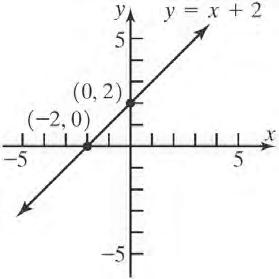
20. 6 yx x-intercept: y-intercept:
The intercepts are 6,0 and 0,6

21. 28yx x-intercept: y-intercept: 028 28 4 x
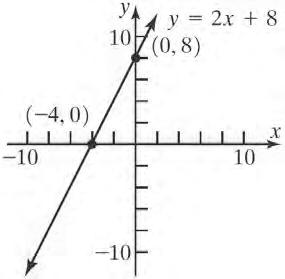
22. 39yx x-intercept: y-intercept: 039 39 3 x
The intercepts are 3,0 and
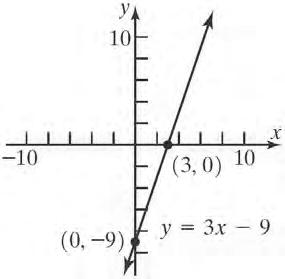

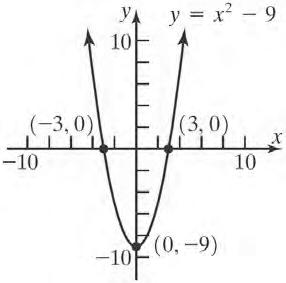

26. 2 1 yx
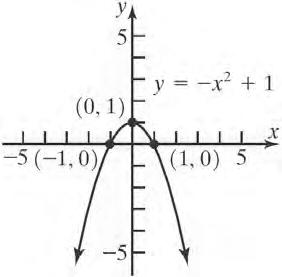
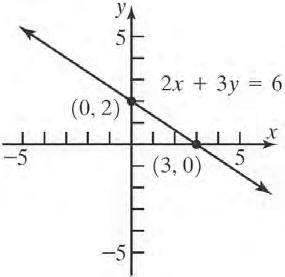
28. 5210 xy
x-intercepts: y-intercept:
52010 510 2 x x x
The intercepts are 2,0 and 0,5
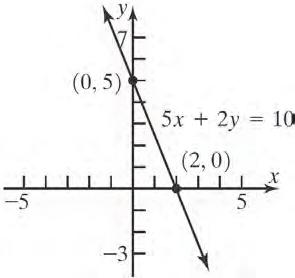
29. 2 9436 xy
x-intercepts: y-intercept:
2 2 2 94036 936 4 2 x x x x
intercepts
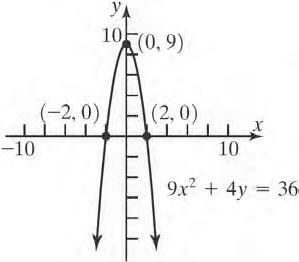
30. 2 44 xy
x-intercepts: y-intercept: 2 2 2 404 44 1 1 x x x x

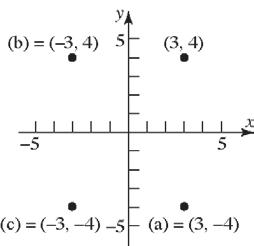
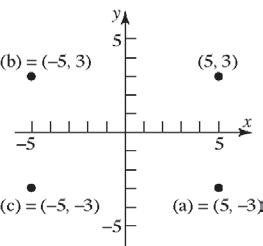
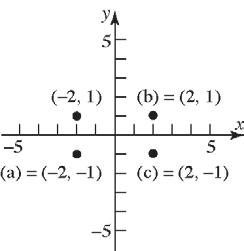
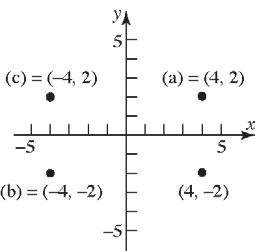
= (5, 2) (c) = (5, 2)
= (5, 2)
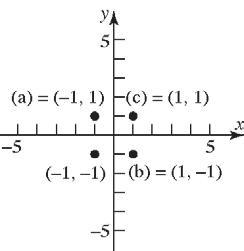
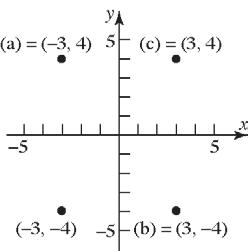

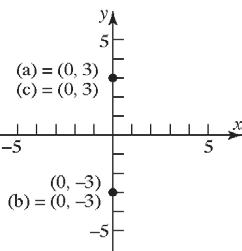
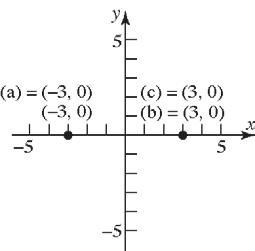
41. a. Intercepts: 1,0 and 1,0
b. Symmetric with respect to the x-axis, y-axis, and the origin.
42. a. Intercepts: 0,1
b. Not symmetric to the x-axis, the y-axis, nor the origin
43. a. Intercepts: 2 0 , , 0,1 , and 2 ,0
b. Symmetric with respect to the y-axis.
44. a. Intercepts: 2,0 , 0,3 , and 2,0
b. Symmetric with respect to the y-axis.
45. a. Intercepts: 0,0
b. Symmetric with respect to the x-axis.
46. a. Intercepts: 2,0, 0,2, 0,2, and 2,0
b. Symmetric with respect to the x-axis, y-axis, and the origin.
47. a. Intercepts: 2,0 , 0,0 , and 2,0
b. Symmetric with respect to the origin.
48. a. Intercepts: 4,0 , 0,0 , and 4,0
b. Symmetric with respect to the origin.
Graphs
49. a. x-intercepts: 2,1 , y-intercept 0
b. Not symmetric to x-axis, y-axis, or origin.
50. a. x-intercepts: 1,2 , y-intercept 0
b. Not symmetric to x-axis, y-axis, or origin.
51. a. Intercepts: none
b. Symmetric with respect to the origin.
52. a. Intercepts: none
b. Symmetric with respect to the x-axis.
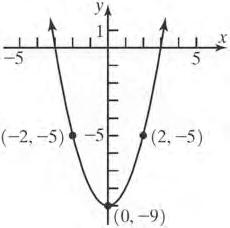
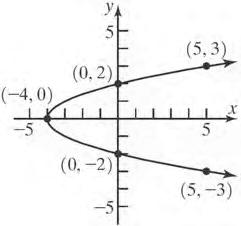
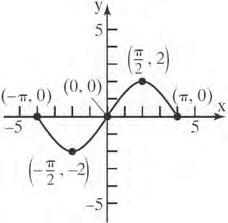
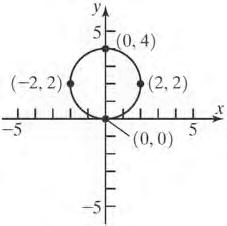
57. 2 16 yx x-intercepts: y-intercepts: 2 016 16 x x 2 2 016 16 4 y y y
The intercepts are 16,0 , 0,4 and 0,4 .
Test x-axis symmetry: Let yy
2 2 16 16 same yx yx
Test y-axis symmetry: Let x x 2 16 yx different
Test origin symmetry: Let x x and yy
2 2 16 16 different
yx yx
Therefore, the graph will have x-axis symmetry.
58. 2 9 yx
x-intercepts: y-intercepts: 2 (0)9 09 9 x x x 2 2 09 9 3 y y y
The intercepts are 9,0 , 0,3 and 0,3 .
Test x-axis symmetry: Let yy
2 2 9 9 same yx yx
Test y-axis symmetry: Let x x 2 9 yx different
Test origin symmetry: Let x x and yy
2 2 9 9 different yx yx
Therefore, the graph will have x-axis symmetry.
59. 3 y x
x-intercepts: y-intercepts: 3 0 0 x x 3 00 y
The only intercept is 0,0 .
Test x-axis symmetry: Let yy 3 different yx
Section1.2: Graphs of Equations in Two Variables; Intercepts; Symmetry
Test y-axis symmetry: Let x x 33 different yxx
Test origin symmetry: Let x x and yy 33 3 same y xx yx
Therefore, the graph will have origin symmetry.
60. 5 y x
x-intercepts: y-intercepts: 3 0 0 x x
The only intercept is 0,0
Test x-axis symmetry: Let yy 5 different yx
Test y-axis symmetry: Let x x 55 different yxx
Test origin symmetry: Let x x and yy
55 5 same y xx yx
Therefore, the is symmetric with respect to the origin.
61. 2 90 xy
x-intercepts: y-intercepts: 2 2 90 9 3 x x x
2 090 9 y y
The intercepts are 3,0 , 3,0 , and 0,9 .
Test x-axis symmetry: Let yy
2 90 different xy
Test y-axis symmetry: Let x x
2 2 90 90 same xy xy
Test origin symmetry: Let x x and yy
2 2 90 90 different xy xy
Therefore, the graph has y-axis symmetry.
62. 2 40 xy
The intercepts are 2,0 , 2,0 , and 0,4
Test x-axis symmetry: Let yy
2 2 40 40 different xy xy
Test y-axis symmetry: Let x x
2 2 40 40 same xy xy
Test origin symmetry: Let x x and yy
2 2 40 40 different xy xy
Therefore, the graph has y-axis symmetry.
63. 22 254100 xy
x-intercepts: y-intercepts: 2 2 2 2 2540100 25100 4 2
x x x x
The intercepts are 2,0 , 2,0, 0,5, and 0,5 .
Test x-axis symmetry: Let yy 2 2 22 254100 254100 same
xy xy
Test y-axis symmetry: Let x x 2 2 22 254100 254100 same xy xy
Test origin symmetry: Let x x and yy
22 22 254100 254100 same
xy xy
Therefore, the graph has x-axis, y-axis, and origin symmetry.
64. 22 44 xy x-intercepts: y-intercepts:
22 2 2 404 44 1 1 x x x x
2 2 2 404 4 2 y y y
The intercepts are 1,0 , 1,0 , 0,2 , and
0,2 .
Test x-axis symmetry: Let yy
2 2 22 44 44 same xy xy
Test y-axis symmetry: Let x x
2 2 22 44 44 same xy xy
Test origin symmetry: Let x x and yy
22 22 44 44 same xy xy
Therefore, the graph has x-axis, y-axis, and origin symmetry.
65. 3 64 yx x-intercepts: y-intercepts: 3 3 064 64 4
The intercepts are 4,0 and 0,64
Test x-axis symmetry: Let yy 3 64 different yx
Test y-axis symmetry: Let x x
yx yx
3 3 64 64 different
Test origin symmetry: Let x x and yy
yx yx
3 3 64 64 different
Therefore, the graph has no symmetry.
66. 4 1 yx
x-intercepts: y-intercepts: 4 4 01 1 1 x x x
4 01 1 y y
The intercepts are 1,0 , 1,0 , and 0,1
Test x-axis symmetry: Let yy 4 1 different yx
Test y-axis symmetry: Let x x
4 4 1 1 same yx yx
Test origin symmetry: Let x x and yy
4 4 1 1 different yx yx
Therefore, the graph has y-axis symmetry.
67. 2 28 y xx
x-intercepts: y-intercepts:
2 028 042 4 or 2
y y
xx xx x x 2 0208 8
The intercepts are 4,0 , 2,0 , and 0,8
Test x-axis symmetry: Let yy 2 28 different yxx
Test y-axis symmetry: Let x x 2 2 28 28 different
yxx yxx
Test origin symmetry: Let x x and yy 2 2 28 28 different
yxx yxx
Therefore, the graph has no symmetry.
68. 2 4 yx
x-intercepts: y-intercepts: 2 2 04 4 no real solution x x 2 04 4 y y
The only intercept is 0,4 .
Test x-axis symmetry: Let yy 2 4 different yx
Section1.2: Graphs of Equations in Two Variables; Intercepts; Symmetry
Test y-axis symmetry: Let x x
2 2 4 4 same yx yx
Test origin symmetry: Let x x and yy
2 2 4 4 different yx yx
Therefore, the graph has y-axis symmetry.
69. 2 4 16 x y x x-intercepts: y-intercepts: 2 4 0 16 40 0
x x x x
2 40 0 0 16 016
The only intercept is 0,0
Test x-axis symmetry: Let yy 2 4 different 16
x y x
Test y-axis symmetry: Let x x
2
x y x x y x x y x
2 2 2 4 16 4 16 4 same 16
Therefore, the graph has origin symmetry.
70. 2
The intercepts are 2,0 and 2,0 .
Test x-axis symmetry: Let yy 2 4 different 2 x y x
Test y-axis
Therefore, the graph has origin symmetry.
The only intercept is 0,0 .
x-axis
Let yy
Test y-axis symmetry: Let x x
Chapter1: Graphs
Test
Therefore, the graph has origin symmetry.
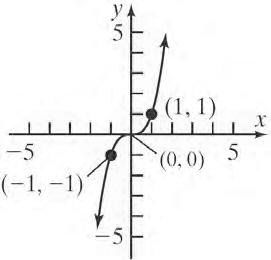
no real solution
There are no intercepts for the graph of this equation.
Test x-axis symmetry: Let yy
Test y-axis symmetry: Let
Therefore, the graph has origin symmetry.
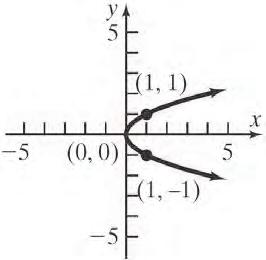
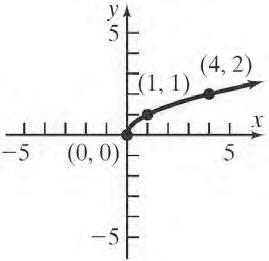
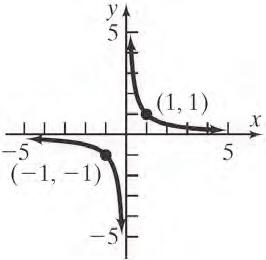
77. If the point ,4 a is on the graph of 2 3 y xx , then we have
2 2 43 034 041 aa aa aa
4 a a
or 10 1 a a
Thus, 4 a or 1 a
78. If the point ,5 a is on the graph of 2 6 y xx , then we have
2 2 56 065 051 aa aa aa
5 a a
or 10 1 a a
Thus, 5 a or 1 a
79. For a graph with origin symmetry, if the point , ab is on the graph, then so is the point , ab . Since the point 1,2 is on the graph of an equation with origin symmetry, the point 1,2 must also be on the graph.
80. For a graph with y-axis symmetry, if the point , ab is on the graph, then so is the point
, ab . Since 6 is an x-intercept in this case, the point 6,0 is on the graph of the equation. Due to the y-axis symmetry, the point 6,0 must also be on the graph. Therefore, 6 is another xintercept.
81. For a graph with origin symmetry, if the point , ab is on the graph, then so is the point , ab . Since 4 is an x-intercept in this case, the point 4,0 is on the graph of the equation. Due to the origin symmetry, the point 4,0 must also be on the graph. Therefore, 4 is another x-intercept.
82. For a graph with x-axis symmetry, if the point , ab is on the graph, then so is the point
, ab . Since 2 is a y-intercept in this case, the point 0,2 is on the graph of the equation. Due to the x-axis symmetry, the point 0,2 must also be on the graph. Therefore, 2 is another yintercept.
83. a. 2 2222 x yxxy
x-intercepts:
2 2222 2 22 4322 43 3 00 2 20 20 xxx xxx xxxx xx xx
3 0or20 02 xx xx
y-intercepts:
2 2222 2 22 42 42 22 000 0 10 yy yy yy yy yy
22 2 0or10 0 1 1 yy y y y
The intercepts are 0,0, 2,0, 0,1, and 0,1
b. Test x-axis symmetry: Let yy
2 2222 2 2222 same xyxxy xyxxy
Test y-axis symmetry: Let x x
2 2222 2 2222 different xyxxy xyxxy
Chapter1: Graphs
Test origin symmetry: Let x x and yy
Thus, the graph will have x-axis symmetry.
84. a. 2 16120225 yx y-intercepts:
2 2 2 161200225 16225 225 16 no real solution y y y
x-intercepts:
2 160120225 0120225 120225 22515 1208 x x x x
The only intercept is 15 ,0 8
b. Test x-axis symmetry: Let yy
2 2 16120225 16120225 same yx yx
Test y-axis symmetry: Let x x
2 2 16120225 16120225 different yx yx
Test origin symmetry: Let x x and yy
2 2 16120225 16120225 different yx yx
Thus, the graph has x-axis symmetry.
85. Let y = 0. 222222 422 422 222 222 22 (0)(0) () 0 ()0 0 or ()0 0 or ,
xax xax xax xxa xxa xxa xaa
Let x = 0. 222222 422 422 222 (0)(0) () 0 ()0 0
yay yay yay yya y
(Note that the solutions to 22 0 ya are not real)
So the intercepts are are (0,0), (a,0) and (-a,0).
Test x-axis symmetry: Replace y by -y 222222 222222 (())(()) ()() equivalent
xyaxy xyaxy
Test y-axis symmetry: replace x by -x 222222 222222 (())(()) ()() equivalent
xyaxy xyaxy
Test origin symmetry: replace x by -x and y by -y 222222 222222 (()())(()()) ()() equivalent
x yaxy xyaxy
The graph is symmetric by respect to the xaxis, the y-axis, and the origin.
86. Let y = 0. 222222 432222 2 (0)(0) 20 (()(()0 0 or or
xaxbx xaxaxbx xxabxab x xab xab
Let x = 0. 222222 422 2 (00)(0) 0 ()()0 0,,
yaby yby yybyb yybyb
So the intercepts are (0,0), (a-b,0), (a+b,0), (0,-b), (0, b).
Test x-axis symmetry: replace y by -y 2 22222 222222 () () ()() Equivalent xyaxbxy xyaxbxy
87. a.
Section1.2: Graphs of Equations in Two Variables; Intercepts; Symmetry
Test y-axis symmetry: replace x by -x 2
()() Not equivalent
Test origin symmetry: replace x by -x and y by -y
()() No equivalent
The graph is symmetric with respect to the x-axis only.



b. Since 2 x x for all x , the graphs of 2 and yxyx are the same.
c. For 2 yx , the domain of the variable x is 0 x ; for yx , the domain of the
variable x is all real numbers. Thus, 2 only for 0. xxx
d. For 2 yx , the range of the variable y is 0 y ; for yx , the range of the variable y is all real numbers. Also, 2 x x only if 0 x . Otherwise, 2 x x .
88. Answers will vary. A complete graph presents enough of the graph to the viewer so they can “see” the rest of the graph as an obvious continuation of what is shown.
89. Answers will vary. One example: y x
90. Answers will vary
91. Answers will vary
92. Answers will vary.
Case 1: Graph has x-axis and y-axis symmetry, show origin symmetry.
, on graph, on graph (from -axis symmetry) xyxy x
, on graph, on graph from -axis symmetry xy xy y
Since the point , x y is also on the graph, the graph has origin symmetry.
Case 2: Graph has x-axis and origin symmetry, show y-axis symmetry.
, on graph, on graph from -axis symmetry xy xy x
, on graph, on graph from origin symmetry xy xy
Since the point , x y is also on the graph, the graph has y-axis symmetry.
Case 3: Graph has y-axis and origin symmetry, show x-axis symmetry.
, on graph, on graph from -axis symmetry xy xy y
, on graph, on graph from origin symmetry xy xy
Since the point , x y is also on the graph, the graph has x-axis symmetry.
93. Answers may vary. The graph must contain the points 2,5 , 1,3 , and 0,2 . For the graph to be symmetric about the y-axis, the graph must also contain the points 2,5 and 1,3 (note that (0, 2) is on the y-axis).
For the graph to also be symmetric with respect to the x-axis, the graph must also contain the points 2,5 , 1,3 , 0,2 , 2,5 , and 1,3 . Recall that a graph with two of the symmetries (x-axis, y-axis, origin) will necessarily have the third. Therefore, if the original graph with y-axis symmetry also has xaxis symmetry, then it will also have origin symmetry.
Section 1.3
1. undefined; 0
2. 3; 2 x-intercept: 23(0)6 26 3 x x x
intercept: 2(0)36
3. True
4. False; the slope is 3 2
5. True;
? ? 2124
6. 12mm ; y-intercepts; 12 1 mm
b
d
13. a. 101 Slope 202
b. If x increases by 2 units, y will increase by 1 unit.
14. a. 101 Slope 202
b. If x increases by 2 units, y will decrease by 1 unit.
15. a. 121 Slope 1(2)3
b. If x increases by 3 units, y will decrease by 1 unit.
16. a. 211 Slope 2(1)3
b. If x increases by 3 units, y will increase by 1 unit.
17. 21 21 033 Slope 422 yy xx
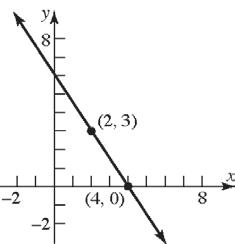
18. 21 21 422 Slope2 341 yy xx

19. 21 21 1321 Slope 2(2)42 yy xx
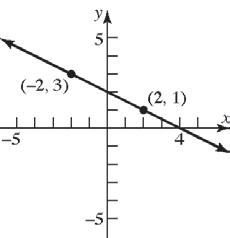
20. 21 21 312 Slope 2(1)3 yy xx

21. 21 21 1(1)0 Slope0 2(3)5 yy xx

22. 21 21 220 Slope0 549 yy xx
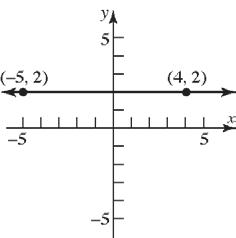
23. 21 21 224 Slope undefined. 1(1)0 yy xx
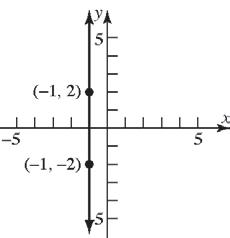
24. 21 21 202 Slope undefined. 220 yy xx

Chapter1: Graphs
1,2;3Pm
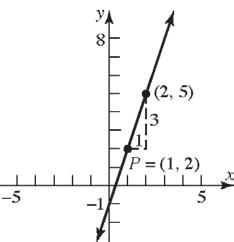
2,1;4Pm
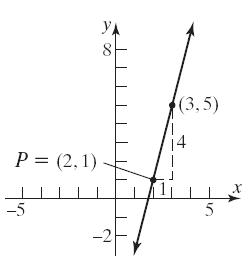
27. 3 2,4; 4 Pm 28. 2 1,3; 5 Pm
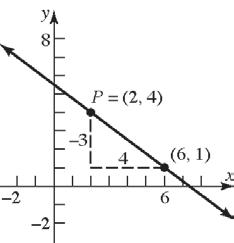
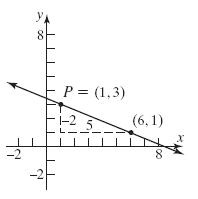
1,3;0Pm

2,4;0Pm
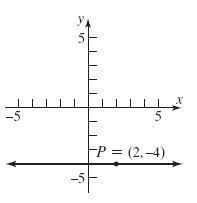
31. 0,3; slope undefined P
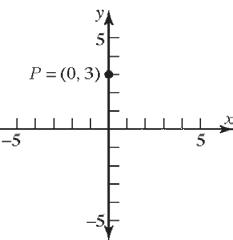
(note: the line is the y-axis)
32. 2,0; slope undefined P

33. 1,2;3Pm ; 23(1)yx
34. 2,1;4Pm ; 14(2)yx
35. 3 2,4; 4 Pm ; 3 4(2) 4 yx
36. 2 1,3; 5 Pm ; 2 3(1) 5 yx
37. 1,3;0Pm ; 30 y
38. 2,4;0Pm ; 40 y
39. 4 Slope4 1 ; point: 1,2
If x increases by 1 unit, then y increases by 4 units.
Answers will vary. Three possible points are:
112 and 246 2,6 213 and 6410 3,10 314 and 10414 4,14 xy xy xy
40. 2 Slope2 1 ; point: 2,3
If x increases by 1 unit, then y increases by 2 units.
Answers will vary. Three possible points are:
211 and 325 1,5 110 and 527 0,7 011 and 729 1,9 xy xy xy
41. 33 Slope 22 ; point: 2,4
If x increases by 2 units, then y decreases by 3 units.
Answers will vary. Three possible points are: 224 and 437 4,7 426 and 7310 6,10 628 and 10313 8,13 xy xy xy
42. 4 Slope 3 ; point: 3,2
If x increases by 3 units, then y increases by 4 units.
Answers will vary. Three possible points are:
330 and 246 0,6 033 and 6410 3,10 336 and 10414 6,14 xy xy xy
43. 2 Slope2 1 ; point: 2,3
If x increases by 1 unit, then y decreases by 2 units.
Answers will vary. Three possible points are:
211 and 325 1,5 110 and 527 0,7 011 and 729 1,9 xy xy xy
44. 1 Slope1 1 ; point: 4,1
If x increases by 1 unit, then y decreases by 1 unit.
Answers will vary. Three possible points are:
415 and 110 5,0 516 and 011 6,1 617 and 112 7,2 xy xy xy
Chapter1: Graphs
45. (0, 0) and (2, 1) are points on the line.
101
Slope 202
-intercept is 0; using : yymxb
1 0 2 2 02 1 20 or 2 yx yx xy x yyx
46. (0, 0) and (–2, 1) are points on the line.
1011
Slope 2022 -intercept is 0; using : yymxb
1 0 2 2 20 1 20 or 2 yx yx xy x yyx
47. (–1, 3) and (1, 1) are points on the line. 11 132 Slope1 1(1)2
Using ()yymxx
11(1) 11 2 2 or 2 yx yx yx xyyx
48. (–1, 1) and (2, 2) are points on the line. 11 211 Slope 2(1)3
Using ()yymxx
1 1(1) 3 1 1(1) 3 11 1 33 14 33 14 34 or 33 yx yx yx yx xyyx
49. 11(),2yymxxm 32(3) 326 23 23 or 23 yx yx yx xyyx
50. 11(),1yymxxm 21(1) 21 3 3 or 3 yx yx yx xyyx
51. 11 1 (), 2 yymxxm 1 2(1) 2 11 2 22 15 22 15 25 or 22 yx yx yx xyyx
52. 11(),1yymxxm 11((1)) 11 2 2 or 2 yx yx yx xyyx
53. Slope = 3; containing (–2, 3) 11() 33((2)) 336 39 39 or 39 yymxx yx yx yx xyyx
54. Slope = 2; containing the point (4, –3) 11() (3)2(4) 328 211 211 or 211 yymxx yx yx yx xyyx
55. Slope = 1 2 ; containing the point (3, 1) 11() 1 1(3) 2 13 1 22 11 22 11 21 or 22 yymxx yx yx yx xyyx
56. Slope = 2 3 ; containing (1, –1) 11() 2 (1)(1) 3 22 1 33 21 33 21 231 or 33 yymxx yx yx yx xyyx
57. Containing (1, 3) and (–1, 2) 2311 1122 m 11() 1 3(1) 2 11 3 22 15 22 15 25 or 22 yymxx yx yx yx xyyx
58. Containing the points (–3, 4) and (2, 5) 541 2(3)5 m
11() 1 5(2) 5 12 5 55 123 55 123 523 or 55 yymxx yx yx yx xyyx
59. Slope = –3; y-intercept =3 33 33 or 33 ymxb yx xyyx
60. Slope = –2; y-intercept = –2 2(2) 22 or 22 ymxb yx xyyx
61. x-intercept = –4; y-intercept = 4 Points are (–4, 0) and (0, 4) 404 1 0(4)4
m 14 4 4 or 4 ymxb yx yx xyyx
62. x-intercept = 2; y-intercept = –1 Points are (2,0) and (0,–1) 1011 0222
m 1 1 2 1 22 or 1 2 ymxb yx x yyx
63. Slope undefined; containing the point (2, 4) This is a vertical line.
2 No slope-intercept form. x
64. Slope undefined; containing the point (3, 8) This is a vertical line.
3 No slope-intercept form. x
65. Horizontal lines have slope 0 m and take the form yb . Therefore, the horizontal line passing through the point 3,2 is 2 y .
66. Vertical lines have an undefined slope and take the form x a . Therefore, the vertical line passing through the point 4,5 is 4 x
67. Parallel to 2 y x ; Slope = 2 Containing (–1, 2) 11() 22((1)) 22224 24 or 24 yymxx yx yxyx xyyx
68. Parallel to 3 y x ; Slope = –3; Containing the point (–1, 2) 11() 23((1)) 23331 31 or 31 yymxx yx yxyx xyyx
69. Parallel to 25xy ; 1 Slope; Containing the point 0,0 2 11() 11 0(0)22 1 20 or 2 yymxx yxyx xyyx
70. Parallel to 22 xy
; Slope = 2
Containing the point (0, 0) 11() 02(0) 2 20 or 2 yymxx yx yx x yyx
71. Parallel to 5 x ; Containing (4,2)
This is a vertical line.
4 No slope-intercept form. x
72. Parallel to 5 y ; Containing the point (4, 2) This is a horizontal line. Slope = 0 2 y
73. Perpendicular to 1 4; 2 yx Containing (1, –2)
Slope of perpendicular = –2 11() (2)2(1) 2222 20 or 2 yymxx yx yxyx xyyx
74. Perpendicular to 23yx ; Containing the point (1, –2) 1
Slope of perpendicular 2 11() 1 (2)(1) 2 1113 2 2222 13 23 or 22 yymxx yx yxyx xyyx
75. Perpendicular to 25xy ; Containing the point (0, 4) Slope of perpendicular = –2 24 24 or 24 ymxb yx xyyx
76. Perpendicular to 22 xy ; Containing the point (–3, 0) 1 Slope of perpendicular 2 11() 113 0((3))22 2 13 23 or 22 yymxx yxyx xyyx
77. Perpendicular to 8 x ; Containing (3, 4) Slope of perpendicular = 0 (horizontal line) 4 y
78. Perpendicular to 8 y ; Containing the point (3, 4)
Slope of perpendicular is undefined (vertical line). 3 x No slope-intercept form.
79. 23yx ; Slope = 2; y-intercept = 3
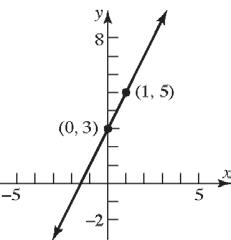
80. 34yx ; Slope = –3; y-intercept = 4
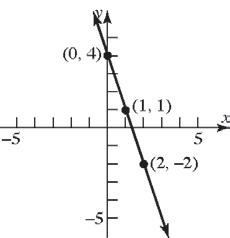
81. 1 1 2 yx ; 22yx Slope = 2; y-intercept = –2 82. 1 2 3 xy ; 1 2 3 yx 1 Slope 3 ; y-intercept = 2 83. 1 2 2 yx ; 1 Slope 2 ; y-intercept = 2 84. 1 2 2 yx ; Slope = 2; 1 -intercept 2 y
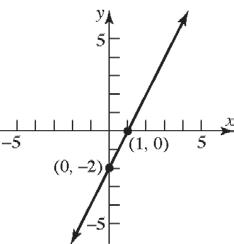
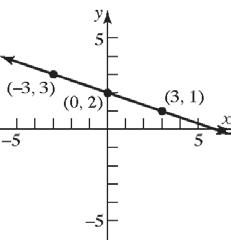
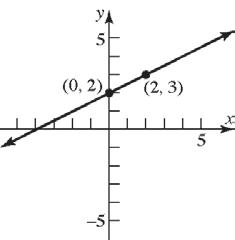


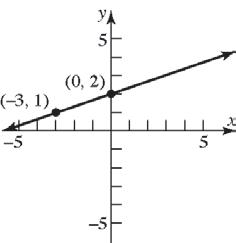


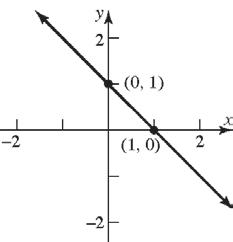
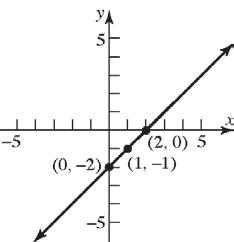
91. 4 x ; Slope is undefined y-intercept - none


92. 1 y ; Slope = 0; y-intercept = –1
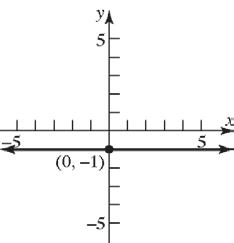
93. 5 y ; Slope = 0; y-intercept = 5
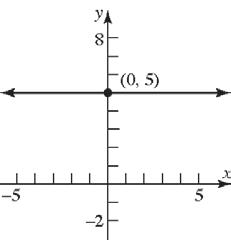
94. 2 x ; Slope is undefined y-intercept - none
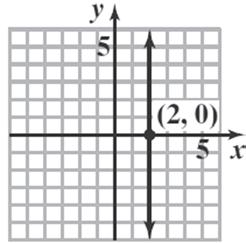
95. 0 yx ; yx
Slope = 1; y-intercept = 0
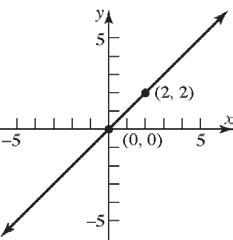
96. 0 xy ; yx
Slope = –1; y-intercept = 0
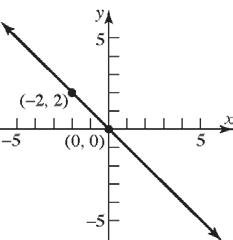
97. 230 yx ; 3 23 2 yxyx 3 Slope 2 ; y-intercept = 0

98. 320 xy ; 3 23 2 yxyx 3 Slope 2 ; y-intercept = 0 99. a. x-intercept: 2306
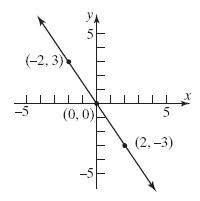
The point 3,0 is on the graph.
The
100. a. x-intercept:
The point 2,0 is on the graph. y-intercept: 3026
The point 0,3 is on the graph. b.
101. a. x-intercept:
45040
The point 10,0 is on the graph. y-intercept: 40540 540 8 y y y
The point 0,8 is on the graph.
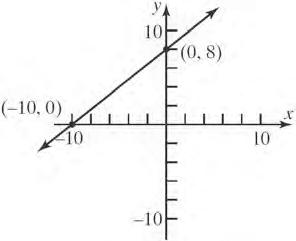
102. a. x-intercept: 64024 624 4 x x x
The point 4,0 is on the graph.
y-intercept: 60424 424 6 y y y
The point 0,6 is on the graph.

103. a. x-intercept: 72021 721 3 x x x
The point 3,0 is on the graph.
y-intercept: 70221 221 21 2 y y y
The point 21 0, 2 is on the graph.
b.
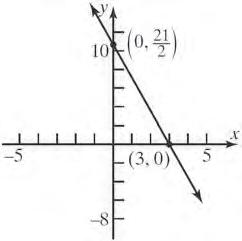
104. a. x-intercept: 53018 518 18 5 x x x
The point 18 ,0 5 is on the graph.
y-intercept: 50318 318 6 y y y
The point 0,6 is on the graph. b.

105. a. x-intercept: 11 01 23 1 1 2 2 x x x
The point 2,0 is on the graph.
y-intercept: 11 01 23 1 1 3 3 y y y
The point 0,3 is on the graph.

106. a. x-intercept: 2 04 3 4 x x
The point 4,0 is on the graph.
y-intercept: 2 04 3 2 4 3 6 y y y
The point 0,6 is on the graph.

107. a. x-intercept: 0.20.501 0.21 5 x x x
The point 5,0 is on the graph.
y-intercept: 0.200.51 0.51 2 y y y
The point 0,2 is on the graph.
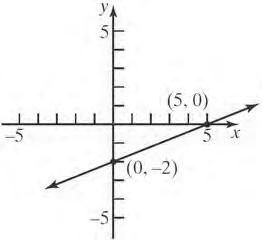
108. a. x-intercept: 0.30.401.2 0.31.2 4 x x x
The point 4,0 is on the graph. y-intercept: 0.300.41.2
The point 0,3 is on the graph.
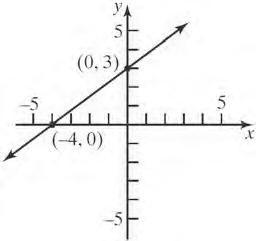
109. The equation of the x-axis is 0 y . (The slope is 0 and the y-intercept is 0.)
110. The equation of the y-axis is 0 x . (The slope is undefined.)
111. The slopes are the same but the y-intercepts are different. Therefore, the two lines are parallel.
112. The slopes are opposite-reciprocals. That is, their product is 1 . Therefore, the lines are perpendicular.
113. The slopes are different and their product does not equal 1 . Therefore, the lines are neither parallel nor perpendicular.
114. The slopes are different and their product does not equal 1 (in fact, the signs are the same so the product is positive). Therefore, the lines are neither parallel nor perpendicular.
115. Intercepts: 0,2 and 2,0 . Thus, slope = 1. 2 or 2 yxxy
116. Intercepts: 0,1 and 1,0 . Thus, slope = –1. 1 or 1 yxxy
117. Intercepts: 3,0 and 0,1 . Thus, slope = 1 3 1 1 or 33 3 yxxy
118. Intercepts: 0,1 and 2,0 . Thus, slope = 1 2 1 1 or 22 2 yxxy 119. 1 2,5 P , 2 1,3 P : 1 5322 2133 m 2 1,3 P , 3 1,0 P :
Since 12 1 mm , the line segments 12PP and 23PP are perpendicular. Thus, the points 1P , 2P , and 3P are vertices of a right triangle.
120. 1 1,1 P , 2 4,1 P , 3 2,2 P
13 21 3 21 m
Each pair of opposite sides are parallel (same slope) and adjacent sides are not perpendicular. Therefore, the vertices are for a parallelogram.
121. 1 1,0 P , 2 2,3 P , 3 1,2 P ,
4 4,1 P
12 303 1 213 m
; 24 13 1 42 m ;
34 12 3 1 413 m ; 13 20 1 11 m
Opposite sides are parallel (same slope) and adjacent sides are perpendicular (product of slopes is 1 ). Therefore, the vertices are for a rectangle.
22 12 10301910 d 22 23 41239110 d
22 34 34121910 d 22 14 30109110 d
Opposite sides are parallel (same slope) and adjacent sides are perpendicular (product of slopes is 1 ). In addition, the length of all four sides is the same. Therefore, the vertices are for a square.
123. Let x = number of miles driven, and let C = cost in dollars.
Total cost = (cost per mile)(number of miles) + fixed cost 0.6039Cx
When x = 110, 0.6011039$105.00 C
When x = 230, 0.6023039$177.00 C
124. Let x = number of pairs of jeans manufactured, and let C = cost in dollars.
Total cost = (cost per pair)(number of pairs) + fixed cost 201200Cx
When x = 400, 204001200$9200 C .
When x = 740, 207401200$16,000 C
125. Let x = number of miles driven annually, and let C = cost in dollars.
Total cost = (approx cost per mile)(number of miles) + fixed cost 0.286578Cx
126. Let x = profit in dollars, and let S = salary in dollars.
Weekly salary = (% share of profit)(profit) + weekly pay 0.05525Sx
127. a. 0.1317Cx ; 01000 x b.
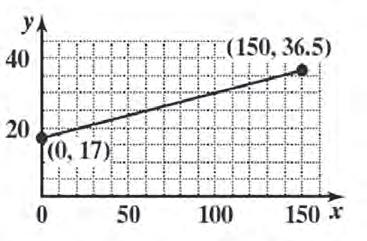
c. For 50 miles, 0.135017$23.50 C
d. For 120 miles, 0.1312017$32.60 C
e. For every 1-mile in distance traveled, the cost will increase 13 cents.
128. a. 600.25 Cx b.
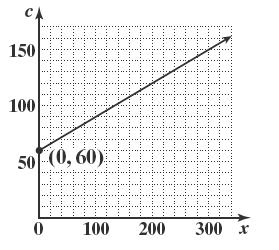
c. For 20 minutes, 600.2520$65.00 C
d. For 60 minutes, 600.2560$75.00 C
e. For every 1-minute increase in international calls the cost will increase by $0.25 (that is, 25 cents).
129. (,)(0,32);(,)(100,212) CF CF 212321809 slope 10001005 9 32(0) 5 9 32() 5 5 (32) 9 FC FC CF
If 70 F , then 55 99(7032)(38) 21.1 C C
130. a. º273KC
b. 5 º(º32) 9 CF 5 (32)273 9 5160 º273 99 52297 º 99 KF KF KF
131. a. The y-intercept is (0, 30), so b = 30. Since the ramp drops 2 inches for every 25 inches of run, the slope is 22 2525 m . Thus, the equation is 2 30 25 yx .
b. Let y = 0. 2 030 25 2 30 25 25225 30 2252 375 x x
The x-intercept is (375, 0). This means that the ramp meets the floor 375 inches (or 31.25 feet) from the base of the platform.
c. No. From part (b), the run is 31.25 feet which exceeds the required maximum of 30 feet.
d. First, design requirements state that the maximum slope is a drop of 1 inch for each 12 inches of run. This means 1 12 m
Second, the run is restricted to be no more than 30 feet = 360 inches. For a rise of 30 inches, this means the minimum slope is 301 36012 . That is, 1 12 m . Thus, the only possible slope is 1 12 m . The diagram indicates that the slope is negative. Therefore, the only slope that can be used to obtain the 30-inch rise and still meet design requirements is 1 12 m . In words, for every 12 inches of run, the ramp must drop exactly 1 inch.
132. a. Let x represent the percent of internet ad spending. Let y represent the percent of print ad spending. Then the points (0.19, 0.26) and (0.35, 0.16) are on the line. Thus, 162610 0.625 351916
m . Using the point-slope formula we have 260.625(19) 260.62511.875 0.62537.875
yx yx yx
b. x-intercept: 00.62537.875 37.8750.625
60.6 x x x
y-intercept: 0.625(0)37.875 37.875 y
The intercepts are (60.6, 0) and (0, 37.875).
c y-intercept: When Internet ads account for 0% of U.S. advertisement spending, print ads account for 37.875% of the spending. x-intercept: When Internet ads account for 60.6% of U.S. advertisement spending, print ads account for 0% of the spending.
d. Let x = 39.2. 0.625(39.2)37.87513.4% y
133. a. Let x = number of boxes to be sold, and A = money, in dollars, spent on advertising. We have the points 11 (,)(100,000,40,000); xA
22 (,)(200,000,60,000) xA
60,00040,000 slope 200,000100,000 20,0001 100,0005 1 40,000100,000 5 1 40,00020,000 5 1 20,000 5 Ax Ax Ax
b. If x = 300,000, then
c. Each additional box sold requires an additional $0.20 in advertising.
134. 2 x yC
Graph the lines: 24 20 22 xy xy xy
All the lines have the same slope, 2. The lines are parallel.
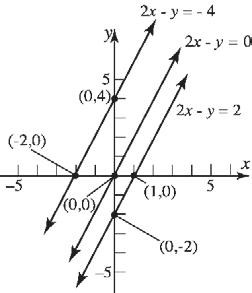
135. Put each linear equation in slope/intercept form. 25
If the slope of yax equals the slope of either of the other two lines, then no triangle is formed.
So, 11 22 aa and 22 33
aa
Also if all three lines intersect at a single point,
xx x x
then no triangle is formed. So, we find where 1524 and 2233 yxyx intersect. 1524 2233 77 66 1 15 22(1)2
The two lines intersect at (1, 2). If yax also contains the point (1, 2), then 212 aa
The three numbers are 12 ,, and -2. 23
136. The slope of the line containing , ab and , ba is 1 ab ba
The slope of the line yx is 1.
The two lines are perpendicular. The midpoint of (,) and (,)abba is , 22 abba M
Since the x and y coordinates of M are equal, M lies on the line yx
Note: 22 abba
137. The three midpoints are 000 0 ,,0,,, 2222222
aaabcabc and 00 ,, 2222
bcbc
1 1 from (0,0) to , 22 0 2 ; 0 2 0(0)
c yx ab c yx ab 2 from (a, 0) to , 22
bc Line cc c m bba ba a c yxa ba c yxa ba 3 from ,0 to (,) 2 02 2 2 2 0 22 2
cc x xa abba ba xxa ab baab xa ab a xa ab ab x
a Linebc cc m a ba b ca yx ba ca yx ba Find where line 1 and line 2 intersect: () 2 2 2 3 ; 3
Substitute into line 1:
cabc y ab
abc
So, line 1 and line 2 intersect at 33,.
Show that line 3 contains the point , 33
abc : 22 2 232263
cabacbac y ba ba So the three lines intersect at 33,. abc
138. Refer to Figure 47. Assume 12 1 mm . Then
2 22 12 2 12 22 1122 22 12 22 12 (,)(11)() () 2 2(1) 2
dABmm mm mmmm mm mm
Now, 2 222 11 2 222 22 (,)(10)(0)1 (,)(10)(0)1 dOBmm dOA mm , So
dOBdOAmm mmdAB
22 22 12 2 22 12 (,)(,)11 2(,)
By the converse of the Pythagorean Theorem, AOB is a right triangle with right angle at vertex O. Thus lines OA and OB are perpendicular.
139. (b), (c), (e) and (g)
The line has positive slope and positive y-intercept.
140. (a), (c), and (g)
The line has negative slope and positive y-intercept.
141. (c)
The equation 2 xy has slope 1 and yintercept (0,2). The equation 1 xy has slope 1 and y-intercept (0,1). Thus, the lines are parallel with positive slopes. One line has a positive y-intercept and the other with a negative y-intercept.
142. (d)
The equation 22yx has slope 2 and yintercept (0,2). The equation 21xy has slope 1 2 and y-intercept 1 0,. 2 The lines are perpendicular since 1 21 2
. One line has a positive y-intercept and the other with a negative y-intercept.
143 – 145. Answers will vary.
146. No, the equation of a vertical line cannot be written in slope-intercept form because the slope is undefined.
147. No, a line does not need to have both an xintercept and a y-intercept. Vertical and horizontal lines have only one intercept (unless they are a coordinate axis). Every line must have at least one intercept.
148. Two lines with equal slopes and equal y-intercepts are coinciding lines (i.e. the same).
149. Two lines that have the same x-intercept and yintercept (assuming the x-intercept is not 0) are the same line since a line is uniquely defined by two distinct points.
150. No. Two lines with the same slope and different xintercepts are distinct parallel lines and have no points in common.
Assume Line 1 has equation 1ymxb and Line 2 has equation 2ymxb ,
Line 1 has x-intercept 1b m and y-intercept 1b .
Line 2 has x-intercept 2b m and y-intercept 2b
Assume also that Line 1 and Line 2 have unequal x-intercepts.
If the lines have the same y-intercept, then 12bb .
But 12 bb mm Line 1 and Line 2 have the same x-intercept, which contradicts the original assumption that the lines have unequal x-intercepts. Therefore, Line 1 and Line 2 cannot have the same y-intercept.
151. Yes. Two distinct lines with the same y-intercept, but different slopes, can have the same x-intercept if the x-intercept is 0 x
Assume Line 1 has equation 1 ymxb and Line 2 has equation 2 ymxb ,
Line 1 has x-intercept 1 b m and y-intercept b
Line 2 has x-intercept 2 b m and y-intercept b
Assume also that Line 1 and Line 2 have unequal slopes, that is 12mm .
If the lines have the same x-intercept, then 12 bb mm
12 21 21 0 bb mm mbmb mbmb
2112 1212 But 0 0 0 or 0 mbmbbmm b mmmm
Since we are assuming that 12mm , the only way that the two lines can have the same x-intercept is if 0. b
152. Answers will vary.
153. 21 21 4263 42 13 yy m xx
It appears that the student incorrectly found the slope by switching the direction of one of the subtractions.
Section 1.4
1. add; 2 1 2 1025
2. 2 29 29 23 23 x x x x
5 or 1 xx The solution set is {1,5}.
3. False. For example, 22 2280xyxy is not a circle. It has no real solutions.
4. radius
5. True; 2 93rr
6. False; the center of the circle
22 3213xy is 3,2
7. d
8. a
9. Center = (2, 1)
Radiusdistance from (0,1) to (2,1) (20)(11)42
22
Equation: 22 (2)(1)4 xy
10. Center = (1, 2) 22
Radiusdistance from (1,0) to (1,2) (11)(20)42
Equation: 22 (1)(2)4 xy
11. Center = midpoint of (1, 2) and (4, 2)
1422 5 222,,2
Radiusdistance from ,2 to (4,2) 593 4(22)242
Equation: 2 2 59 (2) 24xy
12. Center = midpoint of (0, 1) and (2, 3)
0213 ,1,2 22
Radiusdistance from 1,2 to (2,3) 21(32)2
2 2
Equation: 2 2 1(2)2xy
13. ()()222 x hykr 222 22 (0)(0)2 4 xy xy
General form: 22 40 xy
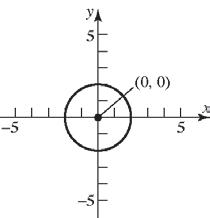
14. ()()222 x hykr 222 22 (0)(0)3 9 xy xy
General form: 22 90 xy
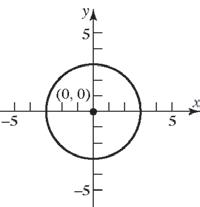
15. ()()222 x hykr 222 22 (0)(2)2 (2)4 xy xy
General form: 22 22 444 40 xyy xyy
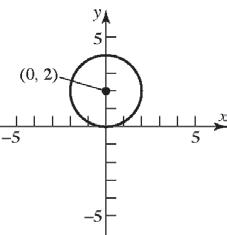
16. ()()222 x hykr 222 22 (1)(0)3 (1)9 xy xy
General form: 22 22 219 280 xxy xyx
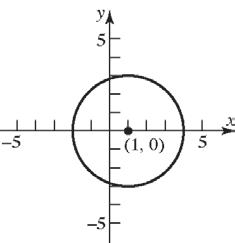
17. ()()222 x hykr 222 22 (4)((3))5 (4)(3)25 xy xy
General form: 22 22 8166925 860 xxyy xyxy
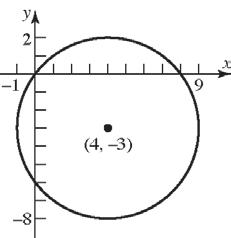
18. ()()222 x hykr 222 22 (2)((3))4 (2)(3)16 xy xy
General form: 22 22 446916 4630 xxyy xyxy

19. ()()222 x hykr 222 22 (2)(1)4 (2)(1)16 xy xy
General form: 22 22 442116 42110 xxyy xyxy
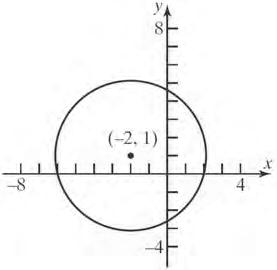
20. ()()222 x hykr
222 22 (5)((2))7 (5)(2)49 xy xy
General form: 22 22 10254449 104200 xxyy xyxy
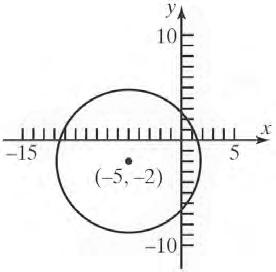
21. ()()222 x hykr 22 2 2 2 11 (0) 22 11 24 xy xy
General form: 22 22 11 44 0 xxy xyx
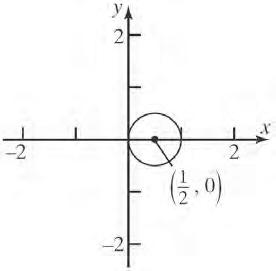
22. ()()222 x hykr
2 2 2 2 2 11 0 22 11 24 xy xy
General form: 22 22 11 44 0 xyy xyy
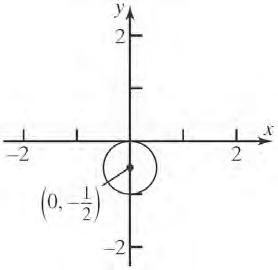
23. ()()222 x hykr
2 22 22 (5)((1))13 (5)(1)13
xy xy
General form: 22 22 10252113 102130
xxyy xyxy

24. ()()222 x hykr
2 22 22 (3)(2)25 (3)(2)20 xy xy
General form: 22 22 694420 6470 xxyy xyxy
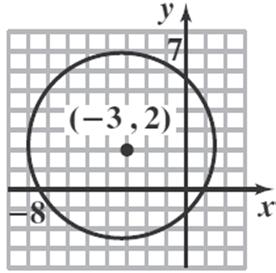
25. 22 4 xy 222 2 xy a. Center: (0,0); Radius2
b.

c. x-intercepts: 2 2 2 04 4 42 x x x
y-intercepts:
The intercepts are
26. 22(1)1xy 222 (1)1xy
a. Center:(0,1); Radius1
b.
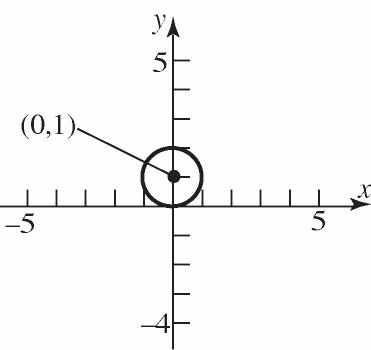
c. x-intercepts:
2 or 0 yy The intercepts are 0,0 and 0,2.
27. 2 2 2328 xy 2 2 34xy
a. Center: (3, 0); Radius 2
b.
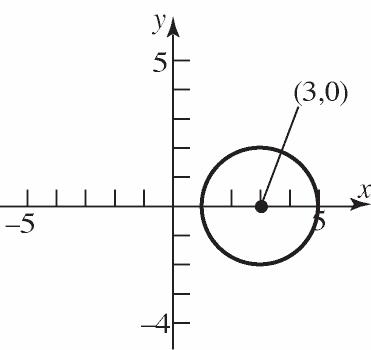
c. x-intercepts:
28. 22 31316 xy
22 112xy
a. Center: (–1,1); Radius = 2 b.
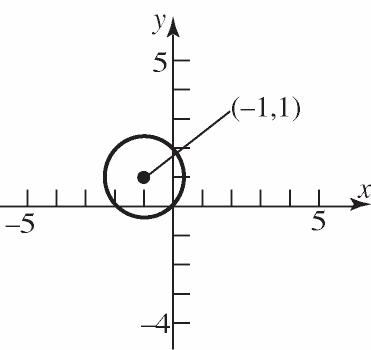
c. x-intercepts:
a. Center: (1, 2); Radius = 3
b.
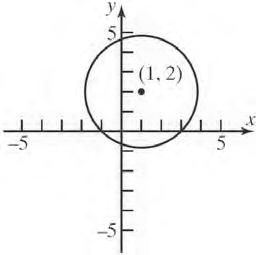
c. x-intercepts:
y-intercepts:
The intercepts are 15,0,15,0, 0,222, and 0,222. 30. 22 42200xyxy 22 22 222 4220 (44)(21)2041 (2)(1)5 xxyy xxyy xy
a. Center: (–2,–1); Radius = 5 b.

c. x-intercepts: 222 2 2 (2)(01)5 (2)125 (2)24 224 226 226 x x x x x x
y-intercepts: 222 2 2 (02)(1)5 4(1)25 (1)21 121 121 y y y y y
The intercepts are 226,0, 226,0, 0,121, and 0,121.
31. 22 22 22 222 4410 441 (44)(44)144 (2)(2)3 xyxy xxyy xxyy xy
a. Center: (–2, 2); Radius = 3
b. y
c. x-intercepts: 222 2 2 (2)(02)3 (2)49 (2)5 25 25 x x x x x
y-intercepts: 222 2 2 (02)(2)3 4(2)9 (2)5 25 25 y y y y y
The intercepts are 25,0, 25,0,
0,25, and 0,25.
32. 22 22 22 222 6290 629 (69)(21)991 (3)(1)1 xyxy xxyy xxyy xy
a. Center: (3, –1); Radius = 1
b.
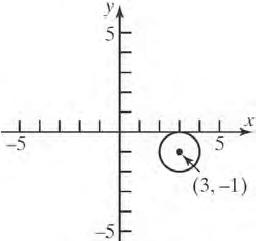
c. x-intercepts: 222 2 2 (3)(01)1 (3)11 30 30 3 x x x x x
y-intercepts: 222 2 2 (03)(1)1 9(1)1 18 y y y No real solution. The intercept only intercept is 3,0 . 33. 22 210xyxy 22 22 22 2 21 11 44(21)11 11 (1) 22 xxyy xxyy xy
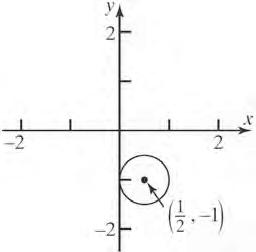
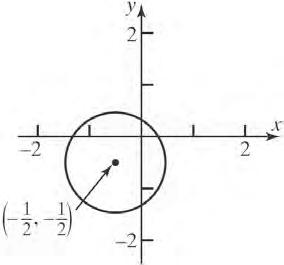
a. Center: (3,–2); Radius = 5 b.
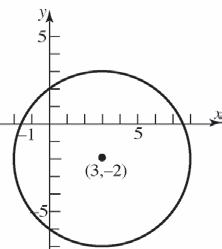
c. x-intercepts: 222 2 2 (3)(02)5 3425 321 321 321 x x x x x
y-intercepts: 222 2 2 (03)(2)5 9225 216 24 24 y y y y y 2 or 6 yy
The intercepts are 321,0, 321,0, 0,6, and 0,2.
36. a. 22 22870 xyx 22 22 22 22 2 22 2827 7 4 2 7 (44)4 2 1 (2) 2 2 (2) 2 xxy xxy xxy xy xy
Center: (–2, 0); Radius = 2 2
b.
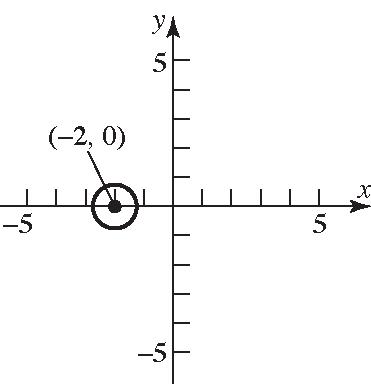
c. x-intercepts:
y-intercepts: 2 22 2 2 022 44 0 0 y y y y The intercepts are 4,0 and

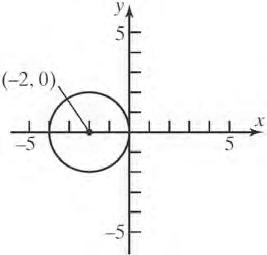
39. Center at (0, 0); containing point (–2, 3).
22 20304913 r
Equation: 2 22 22 (0)(0)13 13 xy xy
40. Center at (1, 0); containing point (–3, 2).
22 31201642025 r
Equation: 2 22 22 (1)(0)20 (1)20 xy xy
41. Endpoints of a diameter are (1, 4) and (–3, 2).
The center is at the midpoint of that diameter:
Center: 1(3)42,1,3 22
Radius: 22 (1(1))(43)415 r
Equation: 2 22 22 ((1))(3)5 (1)(3)5 xy xy
42. Endpoints of a diameter are (4, 3) and (0, 1).
The center is at the midpoint of that diameter:
Center: 4031 ,2,2 22
Radius: 22 (42)(32)415 r
Equation: 2 22 22 (2)(2)5 (2)(2)5 xy xy
43. 2 162 8
Cr r r
2 22 22 (2)((4))8 (2)(4)64
xy xy
45. (c); Center: 1; Radius = 2
46. (d) ; Center: 3,3 ; Radius = 3
47. (b) ; Center: 1,2 ; Radius = 2
48. (a) ; Center: 3,3 ; Radius = 3
49. The centers of the circles are: (4,-2) and (-1,5). The slope is 5(2)77 1455
m . Use the slope and one point to find the equation of the line.
7 (2)(4) 5 728 2 55 510728 7518
yx yx yx xy
50. Find the centers of the two circles: 22 22 22 4640 (44)(69)449 (2)(3)9 xyxy xxyy xy
Center: 2,3 22 22 22 6490 (69)(44)994 (3)(2)4 xyxy xxyy xy
Center: 3,2
Find the slope of the line containing the centers: 2(3)1 325 m
44. 2 2 49 7
A r r r
2 22 22 ((5))(6)7 (5)(6)49
xy xy
Find the equation of the line containing the centers: 1 3(2) 5 5152 513 5130 yx yx xy xy
51. Consider the following diagram:
(2,2)
Therefore, the path of the center of the circle has the equation 2 y
52. Consider the following diagram:
(7,7)
Therefore the path of the center of the circle has the equation 7 x .
53. Let the upper-right corner of the square be the point ,x y . The circle and the square are both centered about the origin. Because of symmetry, we have that x y at the upper-right corner of the square. Therefore, we get
The length of one side of the square is 2 x . Thus, the area is
square units.
54. The area of the shaded region is the area of the circle, less the area of the square. Let the upperright corner of the square be the point ,x y . The circle and the square are both centered about
the origin. Because of symmetry, we have that x y at the upper-right corner of the square. Therefore, we get
The length of one side of the square is 2 x . Thus, the area of the square is 2 23272 square units. From the equation of the circle, we have 6 r . The area of the circle is
square units. Therefore, the area of the shaded region is 3672 A
square units.
55. The diameter of the Ferris wheel was 250 feet, so the radius was 125 feet. The maximum height was 264 feet, so the center was at a height of 264125139 feet above the ground. Since the center of the wheel is on the y-axis, it is the point (0, 139). Thus, an equation for the wheel is:
22 2 2 2 0139125 13915,625
56. The diameter of the wheel is 520 feet, so the radius is 260 feet. The maximum height is 550 feet, so the center of the wheel is at a height of 550260290 feet above the ground. Since the center of the wheel is on the y-axis, it is the point (0, 290). Thus, an equation for the wheel is:
22 2 2 2 0290260 29067,600
57.
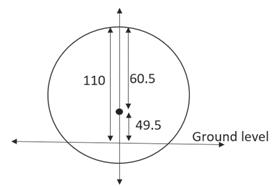
Refer to figure. Since the radius of the building is 60.5 m and the height of the building is 110 m,
then the center of the building is 49.5 m above the ground, so the y-coordinate of the center is 49.5. The equation of the circle is given by 222(49.5)60.53660.25 xy
58. Complete the square to find the equation of the circle representing the formula for the building. 22 222 781521184315213364 (39)58
xyy xy
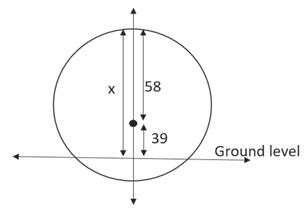
Refer to figure. The y coordinate of the center is 39. The radius is 58. Thus the height of the building is 58 + 39 = 97 m.
59. Center at (2, 3); tangent to the x-axis.
3 r
Equation: 222 22 (2)(3)3 (2)(3)9 xy xy
60. Center at (–3, 1); tangent to the y-axis.
3 r
Equation: 222 22 (3)(1)3 (3)(1)9 xy xy
61. Center at (–1, 3); tangent to the line y = 2. This means that the circle contains the point (–1, 2), so the radius is r = 1.
Equation: 222 22 (1)(3)(1) (1)(3)1 xy xy
62. Center at (4, –2); tangent to the line x = 1. This means that the circle contains the point (1, –2), so the radius is r = 3.
Equation: 222 22 (4)(2)(3) (4)(2)9 xy xy
63. a. Substitute 222 into : y mxbxyr
This equation has one solution if and only if the discriminant is zero.
b. From part (a) we know 22 22 (1)2 0 mxbmxbr . Using the quadratic formula, since the discriminant is zero, we get: 22 22 2 2 2 222222 2 2(1) bmbmbmrmr x b mb b r mr ymb b mrmrbr b bbb
The point of tangency is 22 ,.
c. The slope of the tangent line is m
The slope of the line joining the point of tangency and the center (0,0) is: 2 2 2 2 0 1 0 r b rb bm mr mr b
The two lines are perpendicular.
64. Let (,) hk be the center of the circle. 240 24 1 2 2 xy yx yx
The slope of the tangent line is 1 2 . The slope from (,) hk to (0, 2) is –2.
2 2 0 22 k h kh
The other tangent line is 27yx , and it has slope 2.
The slope from (,) hk to (3, –1) is 1 2 . 11 32 223 21 12 k h kh kh hk
Solve the two equations in and hk : 22(12) 224 30 0 kk kk k k
12(0)1 h
The center of the circle is (1, 0).
65. The slope of the line containing the center (0,0) and 1,22 is 220 22 10 .Then the slope of the tangent line is 12 4 22
So the equation of the tangent line is: 2 221 4 22 22 44 48222 2492
yx yx yx xy
66. 22 4640xyxy 22 22 (44)(69)449 (2)(3)9 xxyy xy
Center: (2, –3)
The slope of the line containing the center and 3,223 is 223(3)22 22 321
Then the slope of the tangent line is: 12 4 22
So, the equation of the tangent line is 2 223(3) 4 232 223 44 48212232 2411212
yx yx yx xy
67. The
Therefore, the equation of the tangent line
The slope of the line between the center
dede xyxyxyf dede xyxyxyf xxyy xydef
69. (b), (c), (e) and (g)
We need ,0hk and 0,0 on the graph.
70. (b), (e) and (g)
We need 0 h , 0 k , and hr
71. Answers will vary.
72. The student has the correct radius, but the signs of the coordinates of the center are incorrect. The student needs to write the equation in the standard form
22 2 x hykr .
22 2 2 2 3216 324 xy xy
Thus, ,3,2hk and 4 r .
Chapter 1 Review Exercises
1. 12 0,0 and 4,2 PP
a. 2212,4020 1642025 dPP
b. The coordinates of the midpoint are:
(,),1212 22 040242 ,,2,1 2222 xxyy xy
c. 2021 slope 4042 y x
d. For each run of 2, there is a rise of 1.
2. 12 1,1 and 2,3 PP
a.
2 2 12,2131 916255
b. The coordinates of the midpoint are:
(,),1212 22 12 13 , 22 121 ,,1 222
c.
d. For each run of 3, there is a rise of 4. 3.
12 4,4 and 4,8 PP a.
b. The coordinates of the midpoint are:
(,),1212 22 444884 ,,4,2 2222
c. 84 12 slope,undefined 440 y x
d. An undefined slope means the points lie on a vertical line. There is no change in x 4. 2 4 yx
5. x-intercepts: 4,0, 2 ; y-intercepts: 2,0,2 Intercepts: (4,0), (0,0),(2,0),(0,2),(0,2)
6. 2 23 x y
x-intercepts: y-intercepts: 2 23(0) 20 0 x x x 2 2 2(0)3 0 0 y y y
The only intercept is (0,0).
Test x-axis symmetry: Let yy 2 2 23() 23 same xy xy
Test y-axis symmetry: Let x x 2 2 2()3 23 different xy xy
Test origin symmetry: Let x x and yy . 2 2 2()3() 23 different xy xy
Therefore, the graph will have x-axis symmetry.
7. 22+4=16xy
Chapter1: Graphs
x-intercepts: y-intercepts:
2 2 2 +40=16 16 4 x x x
The intercepts are (4,0),(4,0),(0,2), and (0,2).
Test x-axis symmetry: Let yy
2 2 22 4=16 4=16 same xy xy
Test y-axis symmetry: Let x x
2 2 22 4=16 4=16 same xy xy
Test origin symmetry: Let x x and yy .
22 22 4=16 +4=16 same xy xy
Therefore, the graph will have x-axis, y-axis, and origin symmetry.
8. 42+2+1yxx
x-intercepts: y-intercepts:
42 22 2 2 0+2+1 011 10 1 xx xx x x
no real solutions
The only intercept is (0, 1).
42 (0)+2(0)+1 1 y
Test x-axis symmetry: Let yy 42 42 21 21 different yxx yxx
Test y-axis symmetry: Let x x
42 42 21 21 same yxx yxx
Test origin symmetry: Let x x and yy .
42 42 42 21 21 21 different yxx yxx yxx
Therefore, the graph will have y-axis symmetry. 9. 3 y xx
x-intercepts: y-intercepts:
3 2 0 01 011 xx xx xxx
3 (0)0 0 y 0,1,1xxx
The intercepts are (1,0), (0,0), and (1,0).
Test x-axis symmetry: Let yy 3 3 different yxx yxx
Test y-axis symmetry: Let x x 3 3 ()() different yxx yxx
Test origin symmetry: Let x x and yy 3 3 3 ()() same yxx yxx yxx
Therefore, the graph will have origin symmetry.
10. 22 20xxyy
x-intercepts: 22 2 (0)2(0)0 0 (1)0 xx xx xx 0,1xx
y-intercepts: 22 2 (0)020 20 (2)0 yy yy yy 0,2yy
The intercepts are (1,0), (0,0), and (0,2).
Test x-axis symmetry: Let yy 22 22 ()2()0 20 different xxyy xxyy
Test y-axis symmetry: Let x x 22 22 ()()20 20 different xxyy xxyy
Test origin symmetry: Let x x and yy 22 22 ()()()2()0 20 different xxyy xxyy
The graph has none of the indicated symmetries.
11.
12.
13.
222 2 2 2 22 ()() 234 2316 x hykr xy xy
222 22 2 22 ()() 121 121 x hykr xy xy
2 2 2 22 14 12 xy xy
Radius
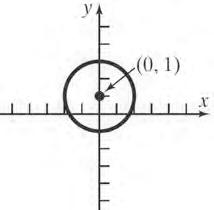
y-intercepts: 2 2 2 014 (1)4 12 12 y y y y
3 or 1 yy
The intercepts are 3,0, 3,0, 0,1, and
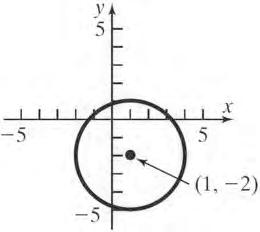
Center: (1, –2) Radius = 5

x-intercepts:
y-intercepts:
The intercepts are
16. Slope = –2; containing (3,–1)
17. vertical; containing (–3,4)
Vertical lines have equations of the form x = a, where a is the x-intercept. Now, a vertical line containing the point (–3, 4) must have an x-intercept of –3, so the equation of the line is 3. x The equation does not have a slopeintercept form.
18. y-intercept = –2; containing (5,–3) Points are (5,–3) and (0,–2) 2(3)11 0555 m
19. Containing the points (3,–4) and (2, 1) 1(4)5 5 231
11 (4)53 4515 511 or 511 yymxx yx yx yxxy
20. Parallel to 234 xy 234 324 324 33 24 33 xy yx yx yx
2 Slope; containing (–5,3) 3
11 2 3(5) 3 2 35 3 210 3 33 219 or 2319 33 yymxx yx yx yx yxxy
21. Perpendicular to 2 xy 2 2 xy yx
The slope of this line is 1 , so the slope of a line perpendicular to it is 1. Slope = 1; containing (4,–3) 11() (3)1(4) 4 3 7 or 7 yymxx yx yx yxxy
22. 4520 5420 4 4 5 xy yx yx
slope = 4 5 ; y-intercept = 4
x-intercept: Let y = 0. 45(0)20 420 5 x x x
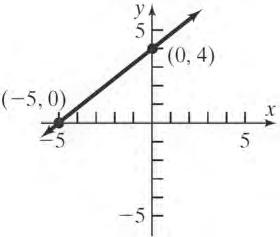
23. 111 236 111 326 31 22 xy yx yx
slope = 3 2 ; 1 -intercept 2 y x-intercept: Let y = 0. 111 (0) 236 11 26 1 3 x x x
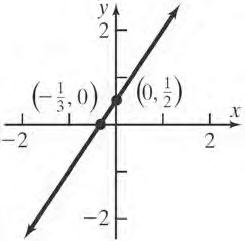
24. 2312 xy x-intercept: y-intercept: 23(0)12 212 6 x x x
The intercepts are 6,0 and 0,4
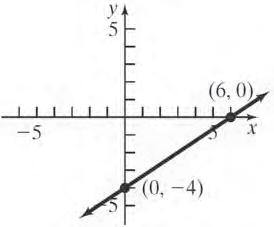
25. 11 2 23xy x-intercept: y-intercept: 11 (0)2 23 1 2 2 4 x x x
11(0)2 23 1 2 3 6 y y y
The intercepts are 4,0 and 0,6 .

26. 3 y x
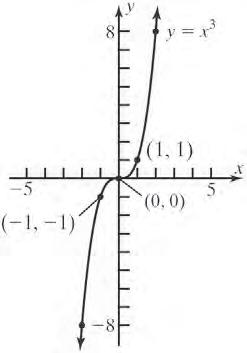
27. y x

28. slope = 2 3 , containing the point (1,2)
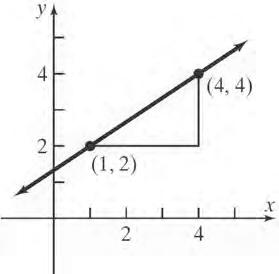
29. Find the distance between each pair of points. 22 , 22 , 22 , (13)(14)4913 (21)(31)9413 (23)(34)25126
AB BC AC d d d
Since AB = BC, triangle ABC is isosceles.
30. Given the points (2,0),(4,4),AB and (8,5). C
a. Find the distance between each pair of points.
22 22 22 ,(4(2))(40) 416 2025 ,(8(4))(54) 1441 145 ,(8(2))(50) 10025 12555 dAB dBC dAC
222 222 ,,, 20125145 20125145 145145 dABdACdBC
The Pythagorean Theorem is satisfied, so this is a right triangle.
b. Find the slopes:
404 2 4(2)2 541 8412 5051 82102 AB BC AC m m m
Since 1 21 2 mmABAC , the sides AB and AC are perpendicular and the triangle is a right triangle.
31. Endpoints of the diameter are (–3, 2) and (5,–6). The center is at the midpoint of the diameter:
Center:
26 35 ,1,2 22
Radius: 22 (1(3))(22) 1616 3242
Equation:
2 22 22 1242 1232
32. 15 slope of 1 62 15 slope of 1 82 AB AC
Therefore, the points lie on a line.
Chapter 1 Test
1.
2. The coordinates of the midpoint are:
b. If x increases by 3 units, y will decrease by 2 units.
4. 2 9 yx 5. 2 y x
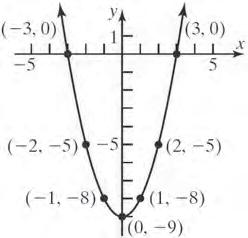
6. 2 9 xy
2 (0)9 9 y y
The intercepts are 3,0, 3,0, and 0,9.
Test x-axis symmetry: Let yy
2 2 9 9 different xy xy
Test y-axis symmetry: Let x x 2 2 9 9 same xy xy
Test origin symmetry: Let x x and yy
2 2 9 9 different xy xy
Therefore, the graph will have y-axis symmetry.
7. Slope = 2 ; containing (3,4) 11() (4)2(3) 426 22 yymxx yx yx yx
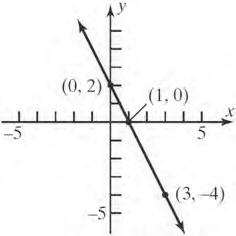
8. ()()222 x hykr
22 2 22 4(3)5 4325 xy xy
General form: 22 22 22 4325 8166925 860 xy xxyy xyxy
9. 22 22 22 222 4240 424 (44)(21)441 (2)(1)3 xyxy xxyy xxyy xy
Center: (–2, 1); Radius = 3
Chapter1: Graphs
Perpendicular line Any
Section 2.1
1. 1,3
2.
Chapter 2
Functions and Their Graphs
16. explicitly
17. a. Domain: {0,22,40,70,100} in C⁰ Range: {1.031, 1.121, 1.229, 1.305, 1.411} in kg/m3 b.

3. We must not allow the denominator to be 0. 404xx ; Domain: 4 xx .
4. 325 22 1 x x x
Solution set: |1xx or ,1
5. 52
6. radicals
7. independent; dependent
8. a
9. c
10. False; g 0
11. False; every function is a relation, but not every relation is a function. For example, the relation 22 1 xy is not a function.
12. verbally, numerically, graphically, algebraically
13. False; if the domain is not specified, we assume it is the largest set of real numbers for which the value of f is a real number.
14. False; if x is in the domain of a function f, we say that f is defined at x, or f(x) exists.
15. difference quotient
c. {(0, 1.411), (22, 1.305), (40, 1.229), (70, 1.121), (100, 1.031)}
18. a. Domain: {1.80, 1.78, 1.77}
Range: {87.1, 86.9, 92.0, 84.1, 86.4} b.
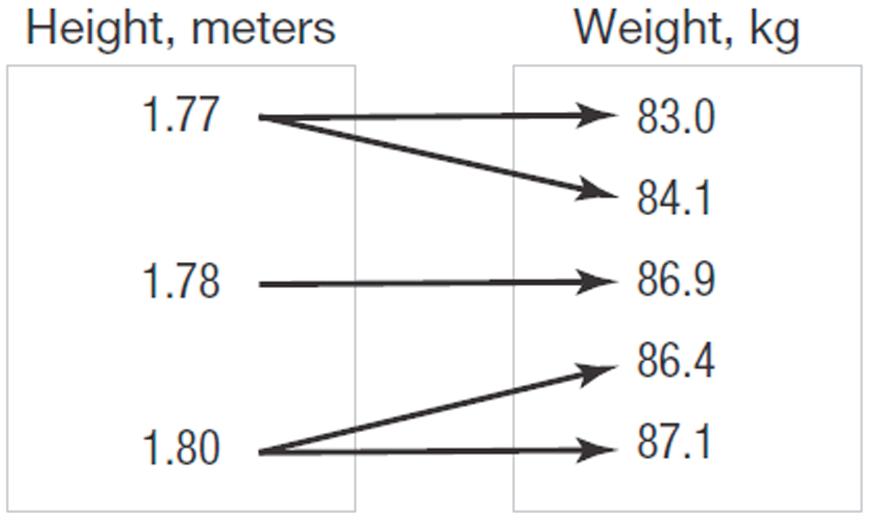
c. {(1.80, 87.1), (1.78, 86.9), (1.77, 83.0), (1.77, 84.1), (1.80, 86.4)}
19. Domain: {Elvis, Colleen, Kaleigh, Marissa}
Range: {Jan. 8, Mar. 15, Sept. 17}
Function
20. Domain: {Bob, John, Chuck}
Range: {Beth, Diane, Linda, Marcia} Not a function
21. Domain: {20, 30, 40}
Range: {200, 300, 350, 425} Not a function
22. Domain: {Less than 9th grade, 9th-12th grade, High School Graduate, Some College, College Graduate}
Range: {$18,120, $23,251, $36,055, $45,810, $67,165}
Function
23. Domain: {-3, 2, 4}
Range: {6, 9, 10} Not a function
24. Domain: {–2, –1, 3, 4}
Range: {3, 5, 7, 12} Function
25. Domain: {1, 2, 3, 4} Range: {3} Function
26. Domain: {0, 1, 2, 3}
Range: {–2, 3, 7} Function
27. Domain: {-4, 0, 3}
Range: {1, 3, 5, 6} Not a function
28. Domain: {-4, -3, -2, -1}
Range: {0, 1, 2, 3, 4} Not a function
29. Domain: {–1, 0, 2, 4}
Range: {-1, 3, 8} Function
30. Domain: {–2, –1, 0, 1}
Range: {3, 4, 16} Function
31. Graph 2 234yxx . The graph passes the Vertical-Line Test. Thus, the equation represents a function.
32. Graph 3 y x . The graph passes the VerticalLine Test. Thus, the equation represents a function.
33. Graph 1 y x . The graph passes the VerticalLine Test. Thus, the equation represents a function.
34. Graph y x . The graph passes the VerticalLine Test. Thus, the equation represents a function.
35. 22 8 x y
Solve for 2 :8 yyx For 0,22xy . Thus, 0,22 and 0,22 are on the graph. This is not a function, since a distinct x-value corresponds to two different y-values.
36. 12 y x For 0,1xy . Thus, (0, 1) and (0, –1) are on the graph. This is not a function, since a distinct xvalue corresponds to two different y-values.
37. 2 x y
Solve for : y yx For 1,1xy . Thus, (1, 1) and (1, –1) are on the graph. This is not a function, since a distinct x-value corresponds to two different y-values.
38. 2 1 xy
Solve for :1 y yx For 0,1xy . Thus, (0, 1) and (0, –1) are on the graph. This is not a function, since a distinct xvalue corresponds to two different y-values.
39. Graph 3 y x . The graph passes the VerticalLine Test. Thus, the equation represents a function.
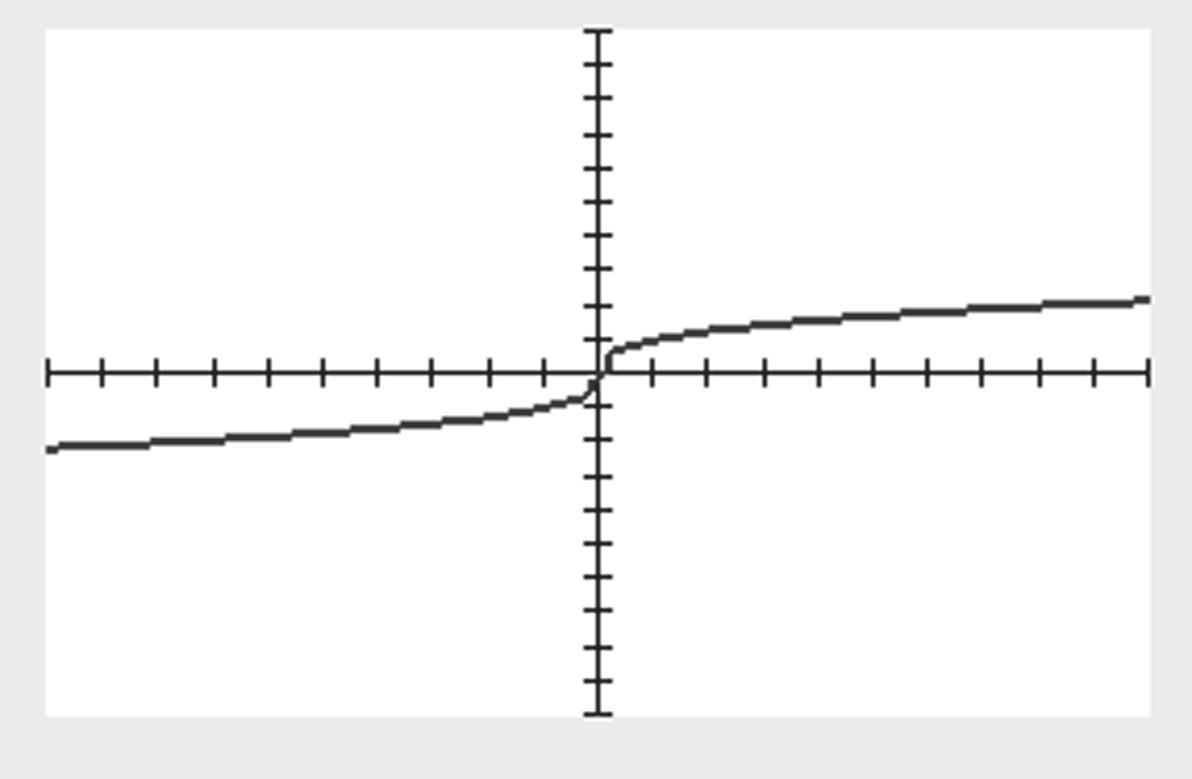
40. Graph 31 2 x y x . The graph passes the Vertical-Line Test. Thus, the equation represents a function.
41. 23 y x
Solve for y: 23 or (23) yxyx
For 1,5 or 5xyy . Thus, 1,5 and 1,5 are on the graph. This is not a function, since a distinct x-value corresponds to two different y-values.
42. 2241xy
Solve for y: 22 22 2 2 2 41 41 1 4 1 2 xy yx x y x y
For 1 2, 2 xy . Thus, 1 2, 2 and 1 2, 2 are on the graph. This is not a function, since a distinct x-value corresponds to two different y-values.
43. 2 324fxxx
a. 2 0302044 f
b. 2 1312143241 f
c. 2 1312143243 f
d. 2 2 324324fxxxxx
e. 22 324324fxxxxx
f. 2 2 2 2 131214 321224 363224 381 fxxx xxx xxx xx
g. 2 2 2322241244 fxxxxx
h. 2 22 22 324 32224 363224 fxhxhxh xxhhxh xxhhxh
44. 2 21 f xxx
a. 2 020011 f
b. 2 121112 f
c. 2 121114 f
d. 2 2 2121 f xxxxx
e. 22 2121 f xxxxx
f. 2 2 2 2 12111 22111 242 232 fxxx xxx xxx xx
g. 2 2 22221821 f xxxxx h. 2 22 22 2()1 221 2421 fxhxhxh x xhhxh xxhhxh
45. 2 1 x fx x a. 2 00 00 1 01 f
b. 2 11 1 2 11 f
c. 2 111 1 112 11 f
d.
22 1 1 x x fx x x
e. 2211 x x fx xx
47.
e.
f.
g.
2 2 1 1 44 x x
2211 44 xx fx
2 2 21 41 2 2424 x x fx
4 fxx
a.
b.
c. 114145 f
d. 44fxxx
e. 44fxxx
f. 114fxx
g. 22424fxxx
h. 4 fxhxh
48. 2 f xxx
a. 2 00000 f
b. 2 1112 f
c. 2 1111100 f
d. 2 2 f xxxxx
e. 22 f xxxxx
f. 2 2 2 111 211 32 fxxx x xx xx
g. 2 2 22242 f xxxxx
h. 2 22 2 fxhxhxh x xhhxh
49. 21 35 x fx x
a. 201 011 0 305055 f
b.
211 2133 1 3153522 f
211 2111 1 3153588
21 2121 353535 x xx fx xxx
e. 2121 3535 x x fx xx
22 11 111 123 fx xx
22
2 1 1 2 fxh xh
51. ()54fxx
Domain: is any real number xx
52. 2 ()2fxx
Domain: is any real number xx
53. 2 1 () 28 x fx x
Domain: is any real number xx
54. 2 2 () 1 x fx x
Domain: is any real number xx
55. 2 () 16 x gx x 2 2 160 164 x x x
Domain: 4,4xxx
56. 2 2 () 4 x hx x 2 2 40 42 x x x
Domain: 2,2xxx
57. 3 2 () x Fx x x 3 2 2 0 (1)0 0,1 xx xx xx
Domain: 0 xx
58. 3 4 () 4 x Gx x x 3 2 2 40 (4)0 0,4 0,2 xx xx xx xx
Domain: 2,0,2xxxx
59. ()312hxx 3120 312 4 x x x
Domain: 4 xx
Chapter 2: Functions and Their Graphs
60. ()1 Gxx 10 1 1 x x x
Domain: 1 xx
61. () 231 x px x 2310 231 231 or 231 24 22 2 1
x x xx xx xx
Domain: 2,1xxx
62. 1 () 314 x px x 3140 314 314 or 314 33 35 5 1 3
x x xx xx xx
Domain: 5 1, 3 xxx
63. () 4 x fx x
40 4 x x
Domain: 4 xx
64. 2 () x x qx 20 2 2 x x x
Domain: 2 xx
65. 4 () 321 t Pt t
40 4 t t Also 3210 t 3210 321 7 t t t
Domain: 4,7ttt
66. 3 () 2 z hz z 30 3 z z Also 20 2 z z
Domain: 3,2zzz
67. 3 ()54 fxx
Domain: is any real number xx
68. 3 22 ()7 g tttt
Domain: is any real number tt .
69. 5 2 1 () 514 t Mt tt 2 5140 (2)(7)0 20 or 70 2 7
tt tt tt tt
Domain: 2,7ttx
70. 5 2 () 298 p Np p 2 2 2980 2(49)0 2(7)(7)0 70 or 70 7 7
p p pp pp pp
Domain: 7,7ppx
71. ()34()23 f xxgxx a. ()()342351 f gxxxx
Domain: is any real number xx .
b. ()()(34)(23) 3423 7 fgxxx xx x
Domain: is any real number xx .
c. 2 2 ()()(34)(23) 69812 612 fgxxx xxx xx
Domain: is any real number xx .
d. 34 () 23 fx x gx
3 23023 2 xxx
Domain: 3 2 xx
e. ()(3)5(3)115116 fg
f. ()(4)4711 fg
g. 2 ()(2)6(2)2122421210 fg
h. 3(1)4 347 (1)7 2(1)3231 f g
72. ()21()32 fxxgxx
a. ()()213251 f gxxxx
Domain: is any real number xx
b. ()()(21)(32) 2132 3 fgxxx xx x
Domain: is any real number xx
c. 2 2 ()()(21)(32) 6432 62 fgxxx xxx xx
Domain: is any real number xx .
d. 21 () 32 fx x gx
Domain: 2 3 xx
e. ()(3)5(3)115114 fg
f. ()(4)431 fg
g. 2 ()(2)6(2)22 6(4)22 242220 fg
h. 2(1)1 213 (1)3 3(1)2321 f g
73. 2 ()1()2 f xxgxx
a. 22 ()()1221 f gxxxxx
Domain: is any real number xx
b. 2 2 2 ()()(1)(2) 12 21 f gxxx xx xx
Domain: is any real number xx
c. ()()(1)(2)22232 f gxxxxx
Domain: is any real number xx
d. 2 1 () 2 f x x g x
Domain: 0 xx
e. 2 ()(3)2(3)31 2(9)31 183120 fg
f. 2 ()(4)2(4)41 2(16)41 324129 fg
g. ()(2)2(2)2(2)32 2(8)2(4) 1688 fg
h. 2 1100 (1)0 2(1)2 2(1) f g
74. 23 ()23()41 fxxgxx
Chapter 2: Functions and Their Graphs
a. 23 32 ()()2341 424 fgxxx xx
Domain: is any real number xx .
b. 23 23 32 ()()2341 2341 422 fgxxx xx xx
c. 23 532 ()()2341 81223 fgxxx xxx
d.
Domain: 3 2 2 xx
e. 32 ()(3)4(3)2(3)4 4(27)2(9)4 108184130
f. 32 ()(4)4(4)2(4)2 4(64)2(16)2 256322222
g. 532 ()(2)8(2)12(2)2(2)3 8(32)12(8)2(4)3 2569683363
h. 2 3 2(1)32(1)3 235 (1)1 4(1)1415 4(1)1
g
()()35 fxxgxx
a. ()()35 f gxxx
Domain: 0 xx
b. ()()(35)35 fgxxxxx
Domain: 0 xx
c. ()()(35)35 f gxxxxxx
Domain: 0 xx
d. () 35 f x x gx 0 and 350 5 35 3 xx xx
Domain: 5 0 and 3 xxx
e. ()(3)33(3)5 39534 fg
f. ()(4)43(4)5 21255 fg
g. ()(2)3(2)252 62522 fg
h. 1111 (1) 3(1)53522 f g
76. ()() f xxgxx
a. ()() f gxxx
Domain: is any real number xx
b. ()() f gxxx
Domain: is any real number xx .
c. ()() f gxxxxx
Domain: is any real number xx
d. () x f x g x
Domain: 0 xx
e. ()(3)33336 fg
f. ()(4)44440 fg
g. ()(2)22224 fg
h. 1 1 (1)1 11 f g
77. 11 ()1() fxgx x x
a. 112 ()()11 fgx x xx
Domain: 0 xx
b. 11 ()()11 fgx xx
Domain: 0 xx .
c. 2 1111 ()()1 fgx xxx x
Domain: 0 xx
d.
Domain: 0 xx .
e. 25 ()(3)1 33 fg
f. ()(4)1 fg
g. 2 11113 ()(2) 2244 (2) fg
h. (1)112 f g
78. ()1()4 f xxgxx
a. ()()14 f gxxx 10 and 40 1 and 4 4 xx xx x
Domain: 14xx
b. ()()14 f gxxx 10 and 40 1 and 4 4 xx xx x
Domain: 14xx .
c. 2 ()()14 54 fgxxx xx 10 and 40 1 and 4 4 xx xx x
Domain: 14xx
d. 11 () 4 4 fxx x g x x 10 and 40 1 and 4 4 xx xx x
Domain: 14xx
e. ()(3)3143 2121 fg
f. ()(4)4144 30303 fg
g. 2 ()(2)(2)5(2)4 41042 fg h. 110 (1)00 413 f g
79. 234 ()()3232 x x fxgx xx
a. 234 ()() 3232 23463 3232 xx fgx xx xxx xx 2 3 320 32 x xx
Domain: 2 3 xx .
Chapter 2: Functions and Their Graphs
b. 234 ()() 3232 23423 3232 xx fgx xx xxx
c.
d.
320 2 32 3 x xx
e. 6(3)3 18321 ()(3)3 3(3)2927 fg
f. 2(4)3835 1 ()(4) 3(4)2122102 fg
g.
2 2 22 8(2)12(2) ()(2) 3(2)2 8(4)243224567 162 624 fg
h. 2(1)3 235 (1) 4(1)44
g
80. 2 ()1() fxxgx x
a. 2 ()()1 fgxx x 10 and 0 1 xx x
Domain: 1,and 0 xxx
b. 2 ()()1 fgxx x 10 and 0 1 xx x
Domain: 1,and 0 xxx
c. 221 ()()1 x fgxx xx
10 and 0 1 xx x
Domain: 1,and 0 xxx
d. 11 () 2 2 fxxx x g x
10 and 0 1 xx x
Domain: 1,and 0 xxx .
e. ()(3)31422228 3333 fg
f. 21 ()(4)41542 fg
g. 22123 ()(2)3 22 fg
h. 1112 (1) 22 f g
81. 1 ()31()()6 2 fxxfgxx 1 631() 2 7 5() 2 7 ()5 2 x xgx xgx gxx
82. 2 11 ()() fxxfx xg x x
2 2 2 1 1 () 1 1 () 1 1 1(1)1 11 x x gx xx x x x gx x xx xx xxx
83. ()43fxx
()()4()3(43) 44343 4 4 fxhfxxhx hh xhx h h h
84. ()31 f xx ()()3()1(31) 33131 3 3 fxhfxxhx hh xhx h h h
85. 2 ()4fxx
22 222 2 ()() ()4(4) 244 2 2 fxhfx h xhx h xxhhx h xhh h x h
86. 2 ()32fxx 22 222 2 ()() 3()2(32) 363232 63 63 fxhfx h xhx h xxhhx h xhh h x h
87. 2 ()4fxxx 22 222 2 ()() ()()4(4) 244 2 21 fxhfx h xhxhxx h xxhhxhxx h xhhh h xh
88. 2 326fxxx
2 2 222 2222 326326 32226326 36323632 632 fxhfx h xhxhxx h xxhhxhxx h x xhhhxxhhh hh xh
Chapter 2: Functions and Their Graphs
89. 5 () 43
94.
xhx h x hxxhx h x hx xhx hxhx xxhhx hxhx xhh hxhx xh xhx xh xhx 98. 1 2 fx x ()() 11 22 22 22 2222 2222 2(2) (2)2(2)2 22 (2)2(2)2 (2)2(2)2 1 (2)2(2)2
22 2222 22 22 22 222 2 22 22 4()4 4()44()4 4()4 4()(4) 4()4 4(2)(4) 11 2 11 2 4()4 (2) 4()4
fxhfx h xhx h xxh hxxh xxhxxh hxxhxxh xxh hxxhxhx xxh hxxhxhx h hxxhxhx xxhxhx
99. 2 2 1123 028 0(4)(2) 40 or 20 4 or 2 xx xx xx xx xx
The solution set is: 2,4
100. 753 1664 735 1646 5712 61616 55 616 563 1658 x x x x x
The solution set is: 3 8
101. 32 ()245 and (2)5 fxxAxxf 32 (2)2(2)(2)4(2)5 516485 5419 144 147 42 fA A A A A
102. 2 ()34 and (1)12 fxxBxf : 2 (1)3(1)(1)4 1234 5 fB B B
103. 38 () and (0)2 2 x fxf xA 3(0)8 (0) 2(0) 8 2 28 4 f A A A A
104. 21 () and (2) 342 xB fxf x 2(2) (2) 3(2)4 14 210 54 1 B f B B B
105. Let x represent the length of the rectangle. Then, 2 x represents the width of the rectangle since the length is twice the width. The function for the area is: 2 2 1 () 222 xx A xxx
106. Let x represent the length of one of the two equal sides. The function for the area is: 2 11 () 22 A xxxx
107. Let x represent the number of hours worked. The function for the gross salary is: ()16 Gxx
108. Let x represent the number of items sold. The function for the gross salary is: ()10100Gxx
1.75 seconds Hx x x x x
0 Hx 2 2 2 0204.9 204.9 4.0816 2.02 seconds x x x x
2 12013120137 meters H
2 2 1.120131.120131.21 2015.734.27 meters 1.220131.220131.44 2018.721.28 meters
b. 2 2 2 15 152013 513 0.3846 0.62 seconds Hx x x x x
2 2 2 10 102013 1013 0.7692 0.88 seconds Hx x x x x
115.
TxVPxVxPx
117. a.
232 232 32 ()()() 1.22200.05265500 1.22200.05265500 0.050.8155500 PxRxCx xxxxx xxxxx xxx
b. 32 (15)0.05(15)0.8(15)155(15)500 168.751802325500 $1836.25 P
c. When 15 hundred smartphones are sold, the profit is $1836.25.
118. a. P is the dependent variable; a is the independent variable
b. 2 (20)0.027(20)6.530(20)363.804 10.8130.6363.804
244.004
In 2015 there are 244.004 million people who are 20 years of age or older.
c. 2 (0)0.027(0)6.530(0)363.804 363.804
In 2015 there are 363.804 million people.
119. a. 2 2 2 ()0.05 2.20.050.4v15 0.05 ()2.2;0.4v15 ()()() 2.615 Bvv vv v Rvv DvRvBv v
b. 2 (60)0.05(60)2.6(60)15 18015615 321
c. The car will need 321 feet to stop once the impediment is observed.
120. a. 2 hxx 222 hababab hahb 2 hxx has the property.
b. 2 g xx 2 22 2 g ababaabb Since
2222 2 aabbabgagb , 2 () g xx does not have the property.
Section 2.1: Functions
c. 52Fxx
52552Fababab Since 5525252 ababFaFb , 52Fxx does not have the property.
d. 1 Gx x
111 GabGaGb abab 1 Gx x does not have the property.
Chapter 2: Functions and Their Graphs
124. No. The domain of f is is any real number xx , but the domain of g is 1 xx
125. 3 3 ( ) x x yourage
126. Answers will vary.
127. 22 (12)16 xy
x-intercept (y=0): 22 2 (12)016 (12)16 (12)4 124 16,8 x x x x xx
(16,0),(8,0) y-intercept (x=0): 22 22 2 (012)16 (12)16 16144128 y y y
There are no real solutions so there are no yintercepts.
Symmetry: 22 22 (12)()16 (12)16 xy xy
This shows x-axis symmetry.
128. 2 2 38 3(1)81 yxx y
There is no solution so (-1,-5) is NOT a solution.
2 2 38 3(4)84 481632 yxx y So (4,32) is a solution.
2 2 38 3(9)89 24324219171 yxx y
So (9,171) is NOT a solution.
129. Let x represent the amount of the 7% fat hamburger added.
% fattot. amt.amt. of fat 20%120.2012
7%0.07 15%120.1512 xx x x
0.20120.070.1512 2.40.071.80.15
0.6.08
7.5 x x x x x x
7.5 lbs. of the 7% fat hamburger must be added, producing 19.5 lbs. of the 15% fat hamburger.
130 32 32 32 2 2 9218 29180 (2)(918)0 (2)9(2)0 (9)(2)0 (3)(3)(2)0 xxx xxx xxx xxx xx xxx
(3)0 or (3)0 or (2)0 3,3,2 xxx xxx
The solution set is: 3,3,2
131. (1) 1 abxacd aacdbx acdbx dbx a c
132. 2 2 0.4(0.6) 10 9 rkd k k Thus, 2 2 10 (1.5) 9 2.5 kg r m
xy yx yx
133. 31012 10312 36 105
The slope of the line is 3 10 . The slope of a perpendicular line would be 10 3
134. 2 22 22 22 222 2222 2 22 (47)3(35)8 (47) 1221(2440) (47) 12212440124021 (47)(47) 124021 (47)
135. Add the powers of x to obtain a degree of 7.
Section 2.2
1. 22416xy x-intercepts:
2. False; 22 222 02 0 xy y
The point
2,0 is on the graph.
Section 2.2: The Graph of a Function
3. vertical 4. 53 f
5. 2 4 fxax
6. False. The graph must pass the Vertical-Line Test in order to be the graph of a function.
7. False; e.g. 1 y x .
8. True
9. c
10. a
11. a. (0)3 since (0,3) is on the graph. f (6)3 since (6,3) is on the graph. f
b. (6)0 since (6,0) is on the graph. f (11)1 since (11,1) is on the graph. f
c. (3) is positive since (3)3.7. ff
d. (4) is negative since (4)1. ff
e. ()0 when 3,6, and 10. fxxxx
f. ()0 when 36, and 1011.fxxx
g. The domain of f is 611xx or 6,11
h. The range of f is 34yy or 3,4 .
i. The x-intercepts are 3 , 6, and 10.
j. The y-intercept is 3.
k. The line 1 2 y intersects the graph 3 times.
l. The line 5 x intersects the graph 1 time.
m. ()3 when 0 and 4. fxxx
n. ()2 when 5 and 8. fxxx
12. a. (0)0 since (0,0) is on the graph. f (6)0 since (6,0) is on the graph. f
Chapter 2: Functions and Their Graphs
b. (2)2 since (2,2) is on the graph. f (2)1 since (2,1) is on the graph. f
c. (3) is negative since (3)1. ff
d. (1) is positive since (1)1.0. ff
e. ()0 when 0,4, and 6. fxxxx
f. ()0 when 04.fxx
g. The domain of f is 46xx or 4,6
h. The range of f is 23yy or 2,3
i. The x-intercepts are 0, 4, and 6.
j. The y-intercept is 0.
k. The line 1 y intersects the graph 2 times.
l. The line 1 x intersects the graph 1 time.
m. ()3 when 5. fxx
n. ()2 when 2. fxx
13. Not a function since vertical lines will intersect the graph in more than one point.
a. Domain: 1 or 1 xxx ; Range: is any real number yy
b. Intercepts: (1,0),(1,0)
c. Symmetry about the x-axis, y-axis and the origin
14. Function
a. Domain: is any real number xx ; Range: 0 yy
b. Intercepts: (0,1)
c. None
15. Function
a. Domain: xx ; Range: 11yy
b. Intercepts: ,0, ,0, (0,1) 22
c. Symmetry about y-axis.
16. Function
a. Domain: xx ; Range: 11yy
b. Intercepts: ,0, ,0, (0,0)
c. Symmetry about the origin.
17. Not a function since vertical lines will intersect the graph in more than one point.
a. Domain: 0 xx ; Range: is any real number yy
b. Intercepts: (0,0)
c. Symmetry about the x-axis
18. Not a function since vertical lines will intersect the graph in more than one point.
a. Domain: 22xx ; Range: 22yy
b. Intercepts: (2,0)(2,0)(0,2)(0,2)
c. Symmetry about the x-axis, y-axis and the origin
19. Function
a. Domain: 03xx ; Range: <2 yy
b. Intercepts: (1, 0)
c. None
20. Function
a. Domain: 04xx ; Range: 03yy
b. Intercepts: (0, 0)
c. None
21. Function
a. Domain: is any real number xx ; Range: 2 yy
b. Intercepts: (–3, 0), (3, 0), (0,2)
c. Symmetry about y-axis.
22. Function
a. Domain: 3 xx ;
Range: 0 yy
b. Intercepts: (–3, 0), (2,0), (0,2)
c. None
23. Function
a. Domain: is any real number xx ;
Range: 3 yy
b. Intercepts: (1, 0), (3,0), (0,9)
c. None
24. Function
a. Domain: is any real number xx ;
Range: 5 yy
b. Intercepts: (–1, 0), (2,0), (0,4)
c. None
25. 2 ()32 fxxx
a. 2 (1)31122 f
The point 1,2 is on the graph of f.
b. 2 (2)32228 f
The point 2,8 is on the graph of f
c. Solve for x : 2 2 1 3 232 03 0310, xx xx xxxx (0, –2) and 1 3 ,2 are on the graph of f
d. The domain of f is is any real number xx .
e. x-intercepts:
2 =0320 2 3210,1 3 fxxx xxxx
f. y-intercept: 2 0=30022 f
Section 2.2: The Graph of a Function
26. 2 ()35 f xxx
a. 2 (1)315182 f
The point 1,2 is not on the graph of f.
b. 2 (2)3252=22 f
The point 2,22 is on the graph of f
c. Solve for x : 22 1 3 2353520 3120,2 xxxx xxxx (2, –2) and 1 3 ,2 on the graph of f .
d. The domain of f is is any real number xx
e. x-intercepts:
2 5 3 =0350 3500, fxxx xxxx
f. y-intercept: 2 030500 f
27. 2 () 6 x fx x
a. 325 (3)14 363 f
The point 3,14 is not on the graph of f.
b. 426 (4)3 462 f
The point 4,3 is on the graph of f
c. Solve for x : 2 2 6 2122 14 x x xx x (14, 2) is a point on the graph of f
d. The domain of f is 6 xx
e. x-intercepts: 2 =00 6 202
x fx x x x
Chapter 2: Functions and Their Graphs
f. y-intercept: 021 0 063 f
28. 2 2 () 4 x fx x
a. 2 123 (1) 145 f
The point 3 1, 5
is on the graph of f.
b. 2 0221 (0) 0442 f
The point 1 0, 2
is on the graph of f
c. Solve for x : 2 2 2 12 424 24 02 1 2100 or 2 x xx x xx xxxx
111 0, and , 222
are on the graph of f
d. The domain of f is 4 xx .
e. x-intercepts:
2 2 2 =0020 4 x fxx x
This is impossible, so there are no xintercepts.
f. y-intercept:
2 0221 0 0442
f 29. 4 2 12 () 1 x fx x
a. 4 2 12(1)12 (1)6 2 (1)1 f
The point (–1,1) is on the graph of f
b. 4 2 12(3)972486 (3) 105 (3)1 f
The point 486 3, 5 is on the graph of f
c. Solve for x :
x x x x xx xx 2 13 310 3 3
xx 33 ,1,,1 33
are on the graph of f
d. The domain of f is is any real number xx
e. x-intercept: 4 2 4 12 =00 1 1200 x fx x xx
f. y-intercept:
4 2 120 0 00 01 01 f
30. 2 () 2 x fx x a. 1 2 112 2 13 23 2 22 f
The point 12 , 23 is on the graph of f
b. 2(4)8 (4)4 422 f
The point 4,4 is on the graph of f.
c. Solve for x : 2 2 122 2 x x x x x (–2,1) is a point on the graph of f .
d. The domain of f is 2 xx
e. x-intercept: 2 =0020 2 0 x fxx x x
f. y-intercept: 0 00 02 f
31. a. ()(2)(2)(2)213 fgfg
b. ()(4)(4)(4)1(3)2 fgfg
c. ()(6)(6)(6)011 fgfg
d. ()(6)(6)(6)101 gfgf
e. ()(2)(2)(2)2(1)2 fgfg
f. (4) 11 (4) (4)33 ff gg
b.
The ball needs to be thrown with an initial velocity of 30 feet per second.
which simplifies to
c. Using the velocity from part (b),
The ball will be 15.56 feet above the floor when it has traveled 9 feet in front of the foul line.
d. Select several values for x and use these to find the corresponding values for h. Use the results to form ordered pairs ,x h . Plot the points and connect with a smooth curve.
Thus, some points on the graph are
5,13.2 , and 15,10 . The complete graph is given below.
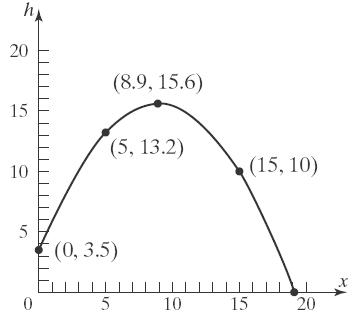
2 2 4412 12126 28 6336 18 784 9.9 feet
c. From part (a) we know the point 8,10.4 is on the graph and from part (b) we know the point 12,9.9 is on the graph. We could evaluate the function at several more values of x (e.g. 0 x , 15 x , and 20 x ) to obtain additional points.
Some additional points are 0,6, 15,8.4 and 20,3.6 . The complete graph is given

d.
2 2 4415 151568.4 feet 28 h
No; when the ball is 15 feet in front of the foul line, it will be below the hoop. Therefore it cannot go through the hoop.
In order for the ball to pass through the hoop, we need to have 1510 h
The ball must be shot with an initial velocity of 30 feet per second in order to go through the hoop.
34. 2 ()41A xxx
a. Domain of 2 ()41A xxx ; we know that x must be greater than or equal to zero, since x represents a length. We also need 2 10 x , since this expression occurs under a square root. In fact, to avoid Area = 0, we require 2 0 and 10xx
2 Solve: 10 110
Case1: 10 and 10 1 and 1 (i.e. 11)
Case2: 10 and 10 x xx xx xx x xx
1 and 1 (which is impossible) xx
Therefore the domain of A is 01xx
b. Graphing 2 ()41A xxx

c. When 0.7 x feet, the cross-sectional area is maximized at approximately 1.9996 square feet. Therefore, the length of the base of the beam should be 1.4 feet in order to maximize the cross-sectional area.
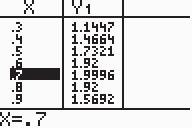
35. 2 2 32 () 130 x hxx
a. 2 2 32(100) (100)100 130 320,000 10081.07 feet 16,900 h
b. 2 2 32(300) (300)300 130 2,880,000 300129.59 feet 16,900 h
c. 2 2 32(500) (500)500 130 8,000,000 50026.63 feet 16,900 h
The ball is about 26.63 feet high after it has traveled 500 feet.
d.
e.
Therefore, the golf ball travels 528.13 feet.

f. Use INTERSECT on the graphs of


The ball reaches a height of 90 feet twice. The first time is when the ball has traveled approximately 115.07 feet, and the second time is when the ball has traveled about 413.05 feet.
Section 2.2: The Graph of a Function
g. The ball travels approximately 275 feet before it reaches its maximum height of approximately 131.8 feet.
h. The ball travels approximately 264 feet before it reaches its maximum height of approximately 132.03 feet.
On Pike's Peak, Amy will weigh about 119.84 pounds.
b. Graphing: 5 0 120 119.5
c. Create a TABLE:
The weight W will vary from 120 pounds to about 119.7 pounds.
d. By refining the table, Amy will weigh 119.95 lbs at a height of about 0.83 miles
(4382 feet).
e. Yes, 4382 feet is reasonable.
37. 36000 ()100 10 x Cx x
a. 48036000 (480)100 10480
$223 60036000 (600)100 10600 $220 C C
b. |0xx
c. Graphing:
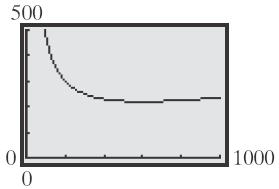
d. TblStart0; Tbl50
e. The cost per passenger is minimized to about $220 when the ground speed is roughly 600 miles per hour.
38. a. 05000 C
This represents the fixed overhead costs. That is, the company will incur costs of $5000 per day even if no computers are manufactured.
b. 1019,000 C
It costs the company $19,000 to produce 10 computers in a day.
c. 5051,000 C
It costs the company $51,000 to produce 50 computers in a day.
d. The domain is |080 qq . This indicates that production capacity is limited to 80 computers in a day.
e. The graph is curved down and rises slowly at first. As production increases, the graph rises more quickly and changes to being curved up.
f. The inflection point is where the graph changes from being curved down to being curved up.
39. a. 0$50 C
It costs $50 if you use 0 gigabytes.
b. 5$50 C
It costs $50 if you use 5 gigabytes.
c. 15$150 C
It costs $90 if you use 15 gigabytes.
d. The domain is g|030 g . This indicates that there are at most 30 gigabytes in a month.
e. The graph is flat at first and then rises in a straight line.
40. (2)5(2)4 gf
Since 2 (2)(2)4(2) 12 f c c we have 2 12 45 3 12 9 3 1227 15 (3)3431512
41. 2 (5)525 ((5))(25)2524 so, 252
42. Answers will vary. From a graph, the domain can be found by visually locating the x-values for which the graph is defined. The range can be found in a similar fashion by visually locating the y-values for which the function is defined. If an equation is given, the domain can be found by locating any restricted values and removing them from the set of real numbers. The range can be found by using known properties of the graph of the equation, or estimated by means of a table of values.
43. The graph of a function can have any number of x-intercepts. The graph of a function can have at most one y-intercept (otherwise the graph would fail the Vertical-Line Test).
44. Yes, the graph of a single point is the graph of a function since it would pass the Vertical-Line Test. The equation of such a function would be something like the following: 2 fx , where 7 x
45. (a) III; (b) IV; (c) I; (d) V; (e) II
46. (a) II; (b) V; (c) IV; (d) III; (e) I
47.
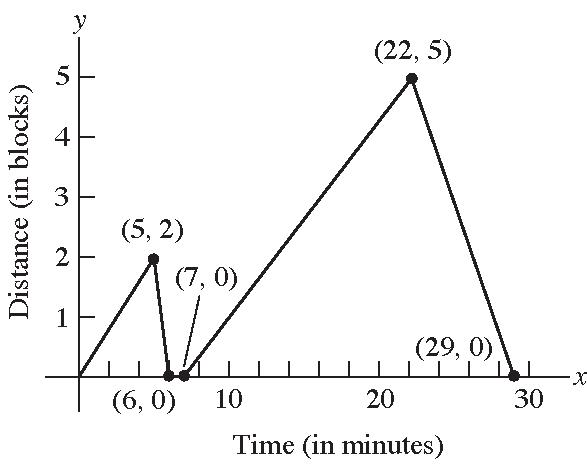
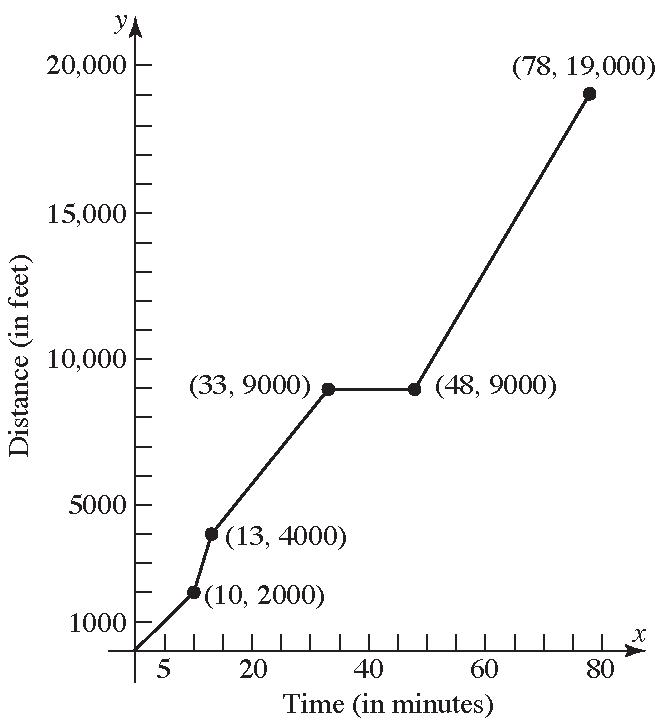
49. a. 2 hours elapsed; Sobia was between 0 and 3 miles from home.
b. 0.5 hours elapsed; Sobia was 3 miles from home.
c. 0.3 hours elapsed; Sobia was between 0 and 3 miles from home.
d. 0.2 hours elapsed; Sobia was at home.
e. 0.9 hours elapsed; Sobia was between 0 and 2.8 miles from home.
f. 0.3 hours elapsed; Sobia was 2.8 miles from home.
g. 1.1 hours elapsed; Sobia was between 0 and 2.8 miles from home.
h. The farthest distance Sobia is from home is 3 miles.
i. Sobia returned home 2 times.
50. a. Michael travels fastest between 7 and 7.4 minutes. That is, 7,7.4
b. Michael's speed is zero between 4.2 and 6 minutes. That is, 4.2,6 .
c. Between 0 and 2 minutes, Michael's speed increased from 0 to 30 miles/hour.
d. Between 4.2 and 6 minutes, Michael was stopped (i.e, his speed was 0 miles/hour).
e. Between 7 and 7.4 minutes, Michael was traveling at a steady rate of 50 miles/hour.
f. Michael's speed is constant between 2 and 4 minutes, between 4.2 and 6 minutes, between 7 and 7.4 minutes, and between 7.6 and 8 minutes. That is, on the intervals (2, 4), (4.2, 6), (7, 7.4), and (7.6, 8).
Chapter 2: Functions and Their Graphs
51. Answers (graphs) will vary. Points of the form (5, y) and of the form (x, 0) cannot be on the graph of the function.
52. The only such function is 0 fx because it is the only function for which f xfx . Any other such graph would fail the Vertical-Line Test.
53. Answers may vary.
55. 22 22 (13)(0(6)) (2)(6) 43640210
57. Since the function contains a cube root then the domain is:
,
58. 2 1 (12)36 2
59.
66 6 6 61 6 66 xx x x x x xx
60. The car traveling north travels a distance or 25t and the car traveling west travels a distance of 35t where t is the time of travel. Using the Pythagorean we have: 222 22 2 2 40(35)(25) 16001225625 16001850
0.8649 0.93 hours
tt tt t t t Converting to minutes we have 0.93(60)55.8 minutes
61. 347 33 1
x x x and 5213 28 4
x x x
The solution set is 4,1 .
62. 2 2 2 (572)(810) 572810 51512
xxx xxx xx
63. 3,10
Section 2.3
1. 25 x 2. 835 slope1 5 32 y x
3. x-axis: yy 2 2 2 51 51 51 different yx yx yx
y-axis: x x
2 2 51 51 same yx yx
origin: x x and yy
2 2 2 51 51 51 different yx yx yx
The equation has symmetry with respect to the y-axis only.
Section 2.3: Properties of Functions
19. Yes. The local maximum at 2 is 10. x
20. No. There is a local minimum at 5 x ; the local minimum is 0.
21. f has local maxima at 2 and 2 xx . The local maxima are 6 and 10, respectively.
4.
11 253 253 y ymxx yx yx
5. 2 9 yx
x-intercepts:
2 2 09 93 x xx
y-intercept:
2 099 y
The intercepts are 3,0 , 3,0 , and 0,9 .
6. increasing
7. even; odd
8. True
9. True
10. False; odd functions are symmetric with respect to the origin. Even functions are symmetric with respect to the y-axis.
11. c
12. d
13. Yes
14. No, it is increasing.
15. No
16. Yes
17. f is increasing on the intervals
8,2,0,2,5,7
18. f is decreasing on the intervals:
10,8,2,0,2,5
22. f has local minima at 8,0 and 5 xxx . The local minima are –4, 0, and 0, respectively.
23. f has absolute minimum of 4 at x = –8.
24. f has absolute maximum of 10 at x = 2.
25. a. Intercepts: (–2, 0), (2, 0), and (0, 3).
b. Domain: 44xx or 4,4 ; Range: 03yy or 0,3 .
c. Increasing: [–2, 0] and [2, 4]; Decreasing: [–4, –2] and [0, 2].
d. Since the graph is symmetric with respect to the y-axis, the function is even.
26. a. Intercepts: (–1, 0), (1, 0), and (0, 2).
b. Domain: 33xx or 3,3 ; Range: 03yy or 0,3
c. Increasing: [–1, 0] and [1, 3]; Decreasing: [–3, –1] and [0, 1].
d. Since the graph is symmetric with respect to the y-axis, the function is even.
27. a. Intercepts: (0, 1).
b. Domain: is any real number xx ; Range: 0 yy or 0,
c. Increasing: (,) ; Decreasing: never.
d. Since the graph is not symmetric with respect to the y-axis or the origin, the function is neither even nor odd.
28. a. Intercepts: (1, 0).
b. Domain: 0 xx or 0, ; Range: is any real number yy
c. Increasing: [0,) ; Decreasing: never.
d. Since the graph is not symmetric with respect to the y-axis or the origin, the function is neither even nor odd.
29. a. Intercepts: (,0),(,0), and (0,0)
b. Domain: xx or , ;
Range: 11yy or 1,1 .
c. Increasing: , 22
; Decreasing: , and , 22
.
d. Since the graph is symmetric with respect to the origin, the function is odd.
30. a. Intercepts: ,0,,0, and (0,1) 22
b. Domain: xx or , ; Range: 11yy or 1,1
c. Increasing: ,0 ; Decreasing: 0,
d. Since the graph is symmetric with respect to the y-axis, the function is even.
31. a. Intercepts: 151 ,0,,0, and 0, 322
b. Domain: 33xx or 3,3 ; Range: 12yy or 1,2
c. Increasing: 2,3 ; Decreasing: 1,1 ; Constant: 3,1 and 1,2
d. Since the graph is not symmetric with respect to the y-axis or the origin, the function is neither even nor odd.
32. a. Intercepts: 2.3,0,3,0, and 0,1 .
b. Domain: 33xx or 3,3 ; Range: 22yy or 2,2
c. Increasing: 3,2 and 0,2 ; Decreasing: 2,3 ; Constant: 2,0 .
d. Since the graph is not symmetric with respect to the y-axis or the origin, the function is neither even nor odd.
33. a. f has a local maximum value of 3 at 0. x
b. f has a local minimum value of 0 at both 2 and 2. xx
34. a. f has a local maximum value of 2 at 0. x
b. f has a local minimum value of 0 at both 1 and 1. xx
35. a. f has a local maximum value of 1 at 2 x
b. f has a local minimum value of –1 at 2 x
36. a. f has a local maximum value of 1 at 0. x b. f has a local minimum value of –1 both at x and x
37. 3 ()4 f xx
()4()433 f xxxfx Therefore, f is odd.
38. 42 ()2 f xxx ()2()()24242 f xxxxxfx Therefore, f is even.
39. 2 ()10 g xx ()10()1022 g xxxgx Therefore, g is even.
40. 3 ()35hxx 33 ()3()535 hxxx h is neither even nor odd.
41. 3 ()4 F xx
33 ()44 F xxxFx Therefore, F is odd.
42. () Gxx () Gxx G is neither even nor odd.
43. () f xxx () f xxxxx f is neither even nor odd.
44. 3 2 ()21fxx
3 22 3 ()2()121 f xxxfx
Therefore, f is even.
45. 2 1 () 8 gx x
22 11 () ()88 g xgx xx
Therefore, g is even.
46. 2 () 1 x hx x
22 () ()11 xx hxhx xx
Therefore, h is odd.
47. 3 2 () 39 x hx x
3 3 22 () () 3()939 x x hxhx xx
Therefore, h is odd.
48. 2 () x Fx x
2 2() () x x F xFx xx
Therefore, F is odd.
49. f has an absolute maximum of 4 at 1. x
f has an absolute minimum of 1 at 5. x
f has an local maximum value of 3 at 3. x
f has an local minimum value of 2 at 2. x
50. f has an absolute maximum of 4 at 4. x
f has an absolute minimum of 0 at 5. x
f has an local maximum value of 4 at 4. x
f has an local minimum value of 1 at 1. x
51. f has an absolute minimum of 1 at 1. x
f has an absolute maximum of 4 at x = 3.
f has an local minimum value of 1 at 1. x
f has an local maximum value of 4 at x = 3.
52. f has an absolute minimum of 1 at 0. x
f has no absolute maximum.
f has no local minimum.
f has no local maximum.
53. f has an absolute minimum of 0 at 0. x
f has no absolute maximum.
f has an local minimum value of 0 at 0. x
f has an local minimum value of 2 at 3. x
f has an local maximum value of 3 at 2. x
54. f has an absolute maximum of 4 at 2. x
f has no absolute minimum.
f has an local maximum value of 4 at 2. x
f has an local minimum value of 2 at 0. x
55. f has no absolute maximum or minimum.
f has no local maximum or minimum.
56. f has no absolute maximum or minimum.
f has no local maximum or minimum.
57. 3 32fxxx on the interval 2,2 Use MAXIMUM and MINIMUM on the graph of 3 1 32yxx .
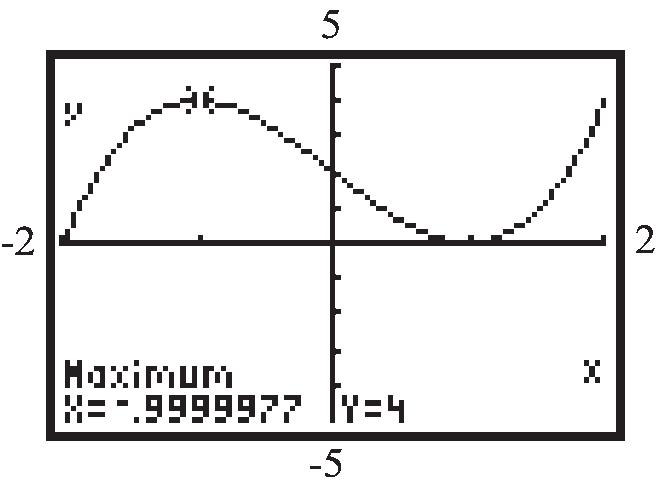

local maximum: (1)4 f
local minimum: (1)0 f
f is increasing on: 2,1 and 1,2 ;
f is decreasing on: 1,1
58. 3235fxxx on the interval 1,3
Use MAXIMUM and MINIMUM on the graph of 32 1 35yxx .
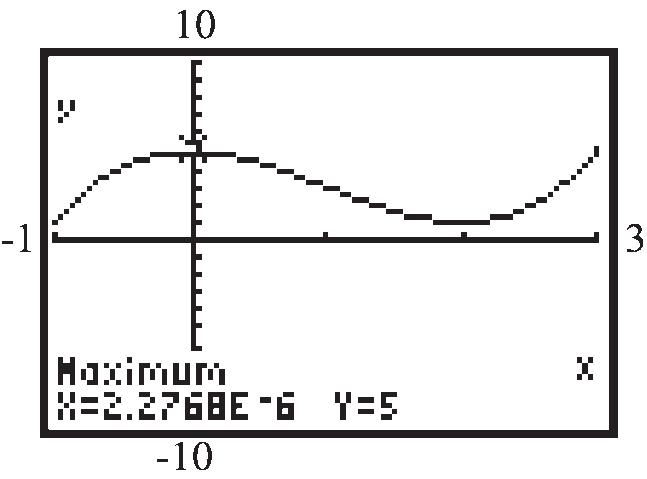
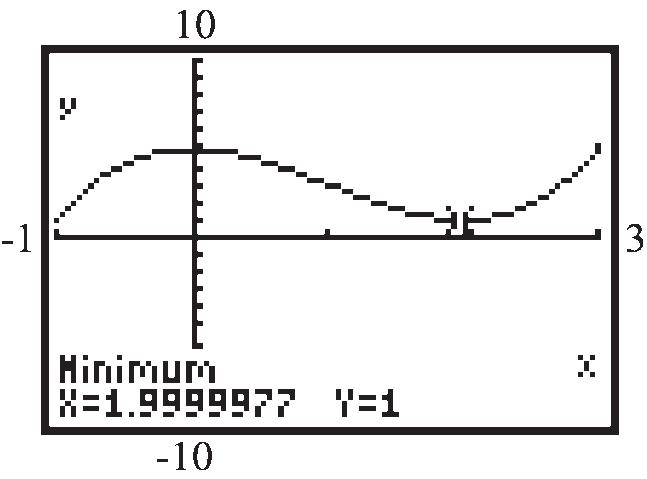
local maximum: (0)5 f local minimum: (2)1 f
f is increasing on:
1,0 and 2,3 ; f is decreasing on:
0,2
59. 53 f xxx on the interval 2,2
Use MAXIMUM and MINIMUM on the graph of 53 1y xx .
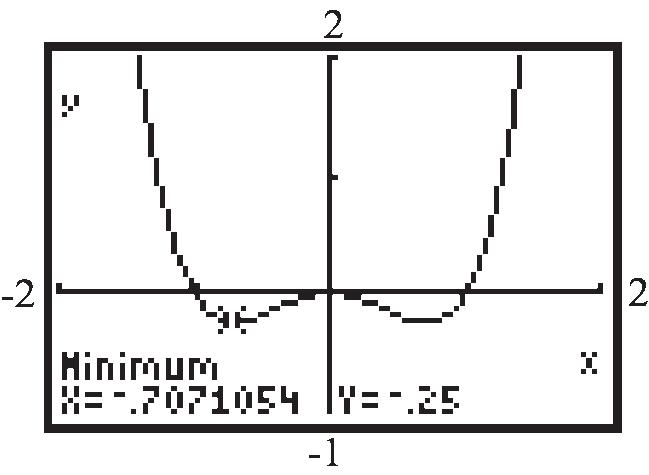
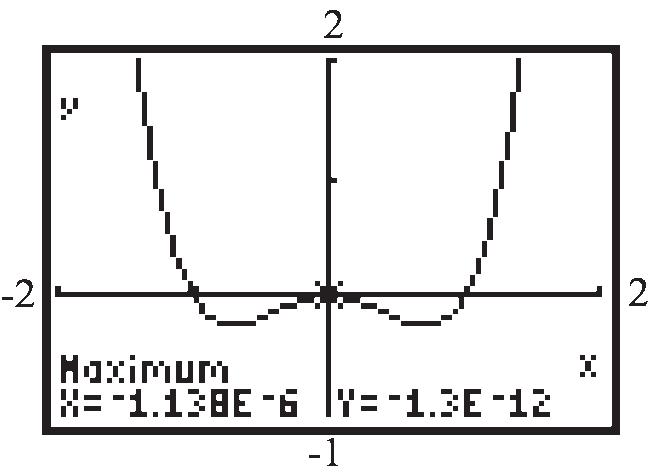

local maximum: (0)0 f local minimum: (0.71)0.25 f ; (0.71)0.25 f f is increasing on: 0.71,0 and 0.71,2 ; f is decreasing on: 2,0.71 and 0,0.71

0.5 0.5
61. 32 0.20.646 f xxxx on the interval 6,4
Use MAXIMUM and MINIMUM on the graph of 32 1 0.20.646yxxx .

0.5 0.5
local maximum: (0.77)0.19 f local minimum: (0.77)0.19 f f is increasing on:
2,0.77 and 0.77,2 ; f is decreasing on: 0.77,0.77
60. 42 f xxx on the interval 2,2
Use MAXIMUM and MINIMUM on the graph of 42 1y xx .
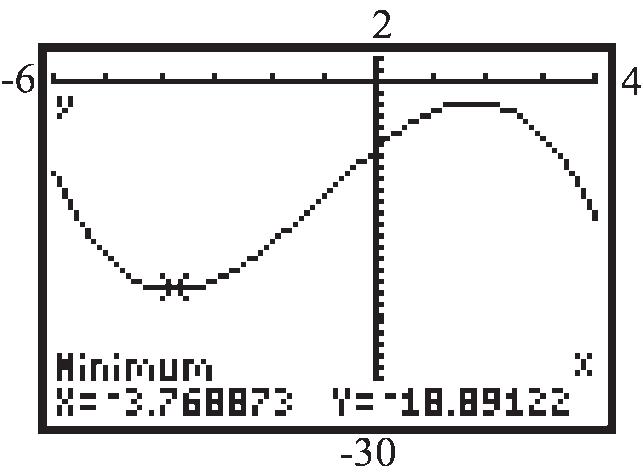
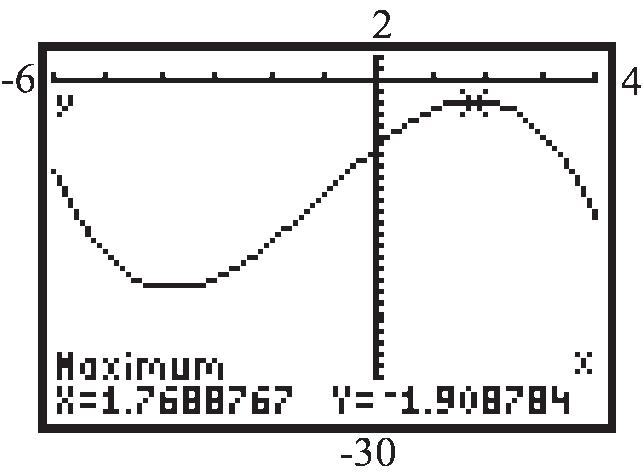
local maximum: (1.77)1.91 f local minimum: (3.77)18.89 f f is increasing on: 3.77,1.77 ; f is decreasing on: 6,3.77 and 1.77,4
62. 32 0.40.632fxxxx on the interval 4,5
Use MAXIMUM and MINIMUM on the graph of 32 1 0.40.632yxxx
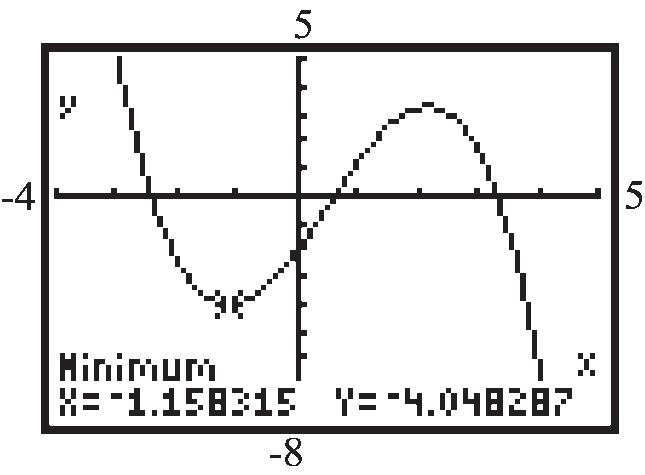
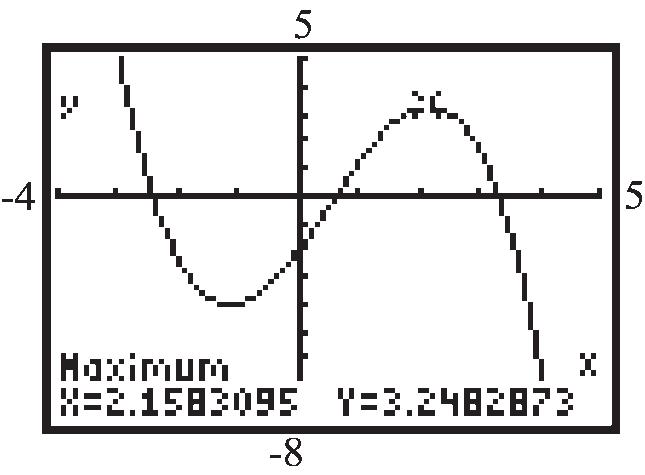
local maximum: (2.16)3.25 f local minimum: (1.16)4.05 f f is increasing on: 1.16,2.16 ; f is decreasing on: 4,1.16 and 2.16,5
63. 432 0.250.30.93fxxxx on the interval 3,2
Use MAXIMUM and MINIMUM on the graph of 432 1 0.250.30.93yxxx .
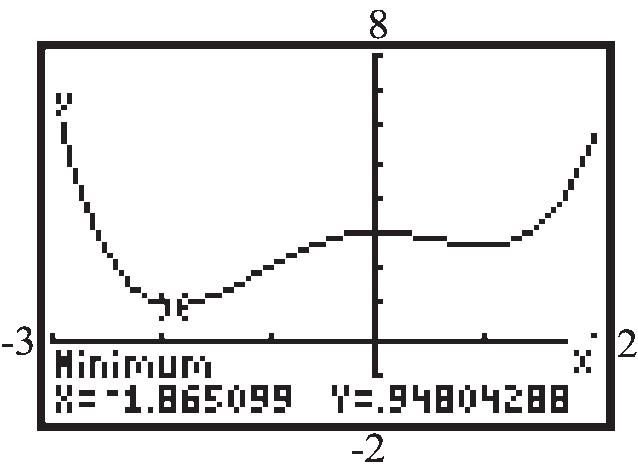
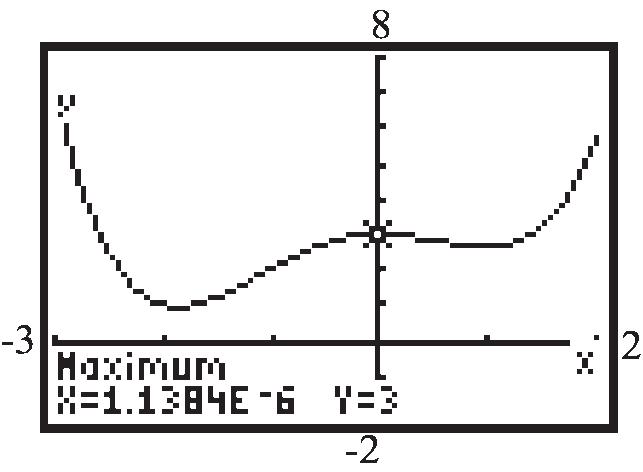
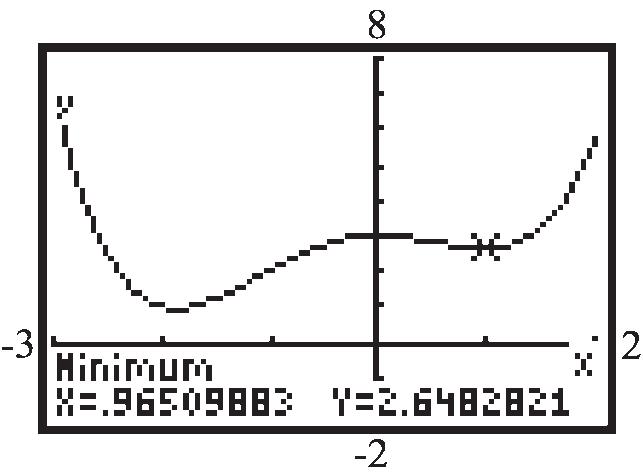
64. 432 0.40.50.82fxxxx on the interval 3,2
Use MAXIMUM and MINIMUM on the graph of 432 1 0.40.50.82yxxx .

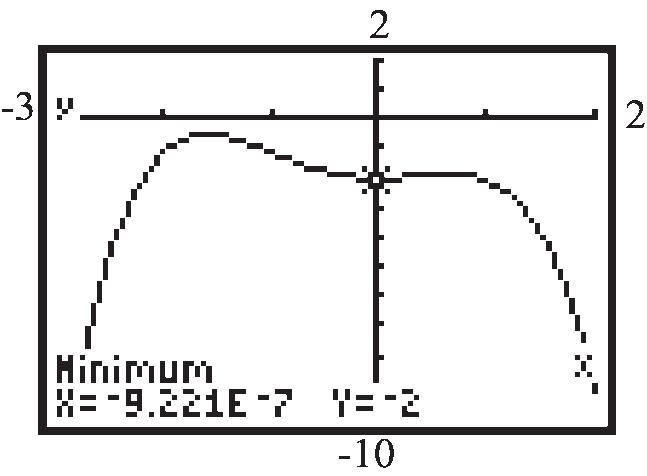

local maxima: (1.57)0.52 f , (0.64)1.87 f
local minimum: 0,2 (0)2 f f is increasing on: 3,1.57 and 0,0.64 ; f is decreasing on:
and 0.64,2
local maximum: (0)3 f local minimum: (1.87)0.95 f , (0.97)2.65 f f is increasing on: 1.87,0 and 0.97,2 ; f is decreasing on: 3,1.87 and 0,0.97
65. 2 ()24fxx
a. Average rate of change of f from 0 x to 2 x
22 224204 20 202 44 8 4 22
2: Functions and Their Graphs
b. Average rate of change of f from x = 1 to x = 3:
c. Average rate of change of f from x = 1 to x = 4:
b.
b.
c.
1 to x = 3:
a. Average rate of change of h from 1 x to 1
b. Average rate of change of h from 0 x to 2 x
a.
69.
c. Average rate of change of h from 2 x to 5 x :
52fxx
a. Average rate of change of f from 1 to 3:
Thus, the average rate of change of f from 1 to 3 is 5.
b. From (a), the slope of the secant line joining
1,1 f and
3,3 f is 5. We use the point-slope form to find the equation of the secant line:
70. 41 f xx
a. Average rate of change of f from 2 to 5:
Therefore, the average rate of change of f from 2 to 5 is 4 .
b. From (a), the slope of the secant line joining
2,2 f and 5,5 f is 4 . We use the point-slope form to find the equation of the secant line:
71. 2 2 gxx
a. Average rate of change of g from 2 to 1:
12 123 1 3 1212
Therefore, the average rate of change of g from 2 to 1 is 1
b. From (a), the slope of the secant line joining 2,2 g and 1,1 g is 1 .We use the point-slope form to find the equation of the secant line:
72. 2 1 gxx
a. Average rate of change of g from 1 to 2:
21 523 1 3 2121 gg y x
Therefore, the average rate of change of g from 1 to 2 is 1.
b. From (a), the slope of the secant line joining 1,1 g and 2,2 g is 1. We use the point-slope form to find the equation of the secant line: 1sec1 211 21 3 yymxx yx yx yx
73. 2 2 hxxx
a. Average rate of change of h from 2 to 4: 42 808 4 42422 hh y x
Therefore, the average rate of change of h from 2 to 4 is 4.
b. From (a), the slope of the secant line joining 2,2 h and 4,4 h is 4. We use the point-slope form to find the equation of the secant line: 1sec1 042 48 yymxx yx yx
74. 2 2 hxxx
a. Average rate of change from 0 to 3:
Therefore, the average rate of change of h from 0 to 3 is 5 .
b. From (a), the slope of the secant line joining 0,(0) h and 3,(3) h is 5 . We use the point-slope form to find the equation of the secant line:
75. a.
3 27 g xxx
Since
g xgx , the function is odd.
b. Since g x is odd then it is symmetric about the origin so there exist a local maximum at 3 x .
3 3(3)27(3)278154
So there is a local minimum value of 16 at 2 x . 77. 4289Fxxx
a.
42 4 89 89
Fxxx xx Fx
Since F xFx , the function is even.
b. Since the function is even, its graph has y-axis symmetry. The second local maximum value is 25 and occurs at 2 x
c. Because the graph has y-axis symmetry, the area under the graph between 0 x and 3 x bounded below by the x-axis is the same as the area under the graph between 3 x and 0 x bounded below the x-axis. Thus, the area is 50.4 square units.
78. 4232144Gxxx a.
42 42 32144 32144 Gxxx xx Gx
Since GxGx , the function is even.
b. Since the function is even, its graph has y-axis symmetry. The second local maximum is in quadrant II and is 400 and occurs at 4 x .
c. Because the graph has y-axis symmetry, the area under the graph between 0 x and 6 x bounded below by the x-axis is the same as the area under the graph between 6 x and 0 x bounded below the x-axis. Thus, the area is 1612.8 square units.
Since f xfx , the function is odd.
b. Since f x is odd then it is symmetric about the origin so there exist a local maximum at 3 x
79.
a. 2 1 2500 0.321251yxx x

b. Use MINIMUM. Rounding to the nearest whole number, the average cost is minimized when approximately 10 lawnmowers are produced per hour.

c. The minimum average cost is approximately $239 per mower. 80.
Graph the function on a graphing utility and use the Maximum option from the CALC menu.

The concentration will be highest after about 2.16 hours.
b. Enter the function in Y1 and 0.5 in Y2. Graph the two equations in the same window and use the Intersect option from the CALC menu.


After taking the medication, the woman can feed her child within the first 0.71 hours (about 42 minutes) or after 4.47 hours (about 4hours 28 minutes) have elapsed.
On average, the population is increasing at a rate of 0.036 gram per hour from 0 to 2.5 hours.
On average, the population is increasing at a rate of 0.1 gram per hour from 4.5 to 6 hours.
c. The average rate of change is increasing as time passes. This indicates that the population is increasing at an increasing rate.
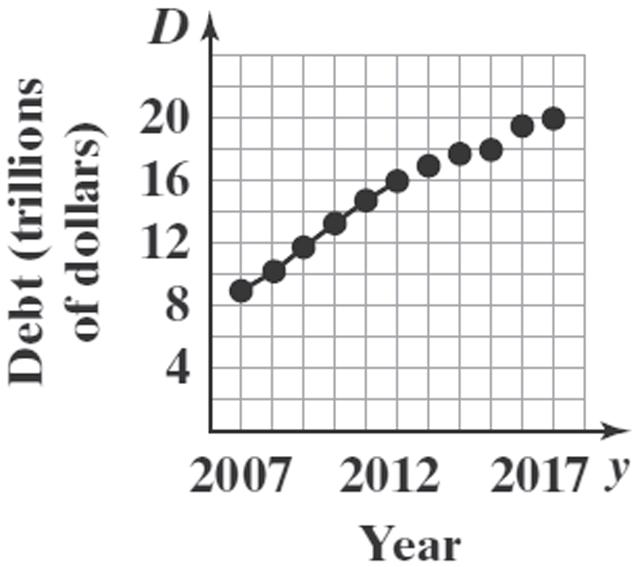
c.

20142012
rate of change 20142012
d.
dollars/yr
20162014 avg. rate of change 20132011
e.
20182016
rate of change 20162014
f. The average rate of change is increasing.
g.
h. Quarantine from Covid19 most likely had a effect on spending habits. 83.
a. Average rate of change of f from 0 x to 1
:
22 10 101 1 1011 ff
b. Average rate of change of f from 0 x to 0.5 x :
c. Average rate of change of f from 0 x to 0.1 x :
d. Average rate of change of f from 0 x to 0.01 x :
2 0.0100.0102 0.0100.01 0.0001 0.01 0.01 ff
e. Average rate of change of f from 0 x to 0.001 x :
2 0.00100.00102 0.00100.001 0.000001 0.001 0.001 ff
f. Graphing the secant lines:
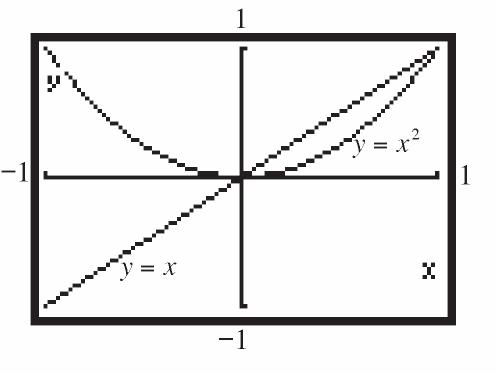
20212019 avg. rate of change 20212019 917710507
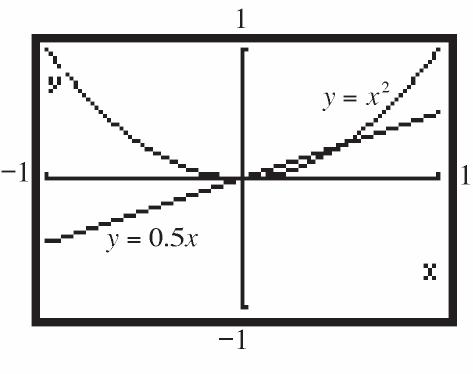
Section 2.3: Properties of Functions
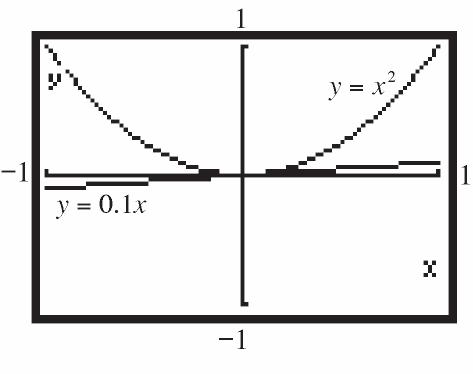
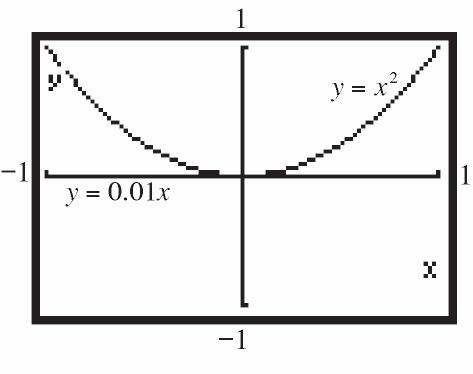
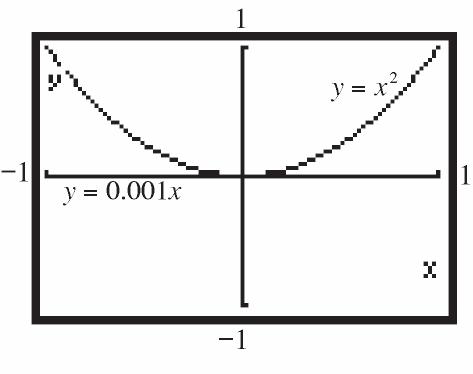
g. The secant lines are beginning to look more and more like the tangent line to the graph of f at the point where 0 x
h. The slopes of the secant lines are getting smaller and smaller. They seem to be approaching the number zero.
a.
b.
c.
d.
e.
f. Graphing the secant lines:
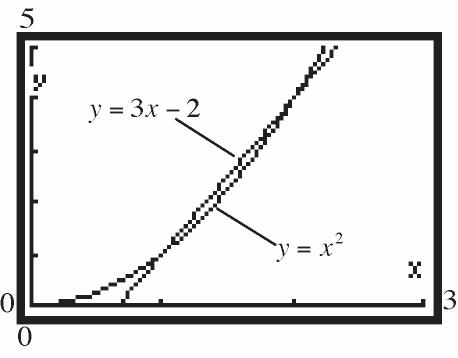
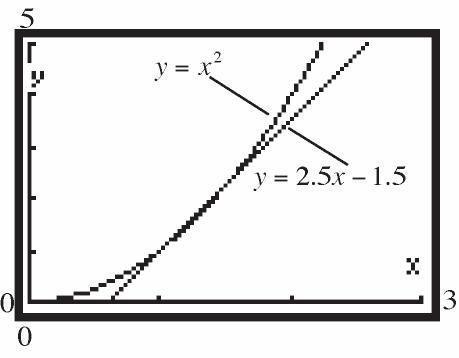
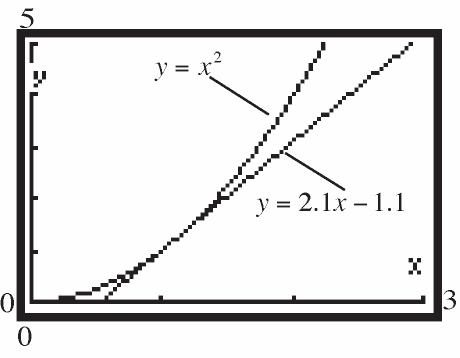
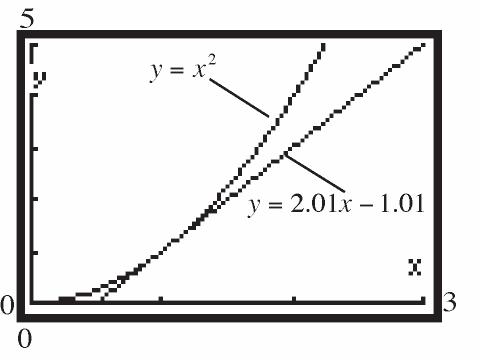
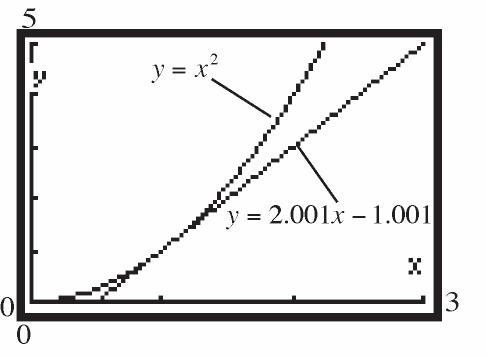
Chapter 2: Functions and Their Graphs
g. The secant lines are beginning to look more and more like the tangent line to the graph of f at the point where 1 x
h. The slopes of the secant lines are getting smaller and smaller. They seem to be approaching the number 2.
85. ()25 f xx
a.
b. When 1 x :
sec 0.52hm
sec 0.12hm
sec 0.012hm
sec as 0, 2 hm
c. Using the point
1,11,7 f and slope, 2 m , we get the secant line:
d. Graphing:
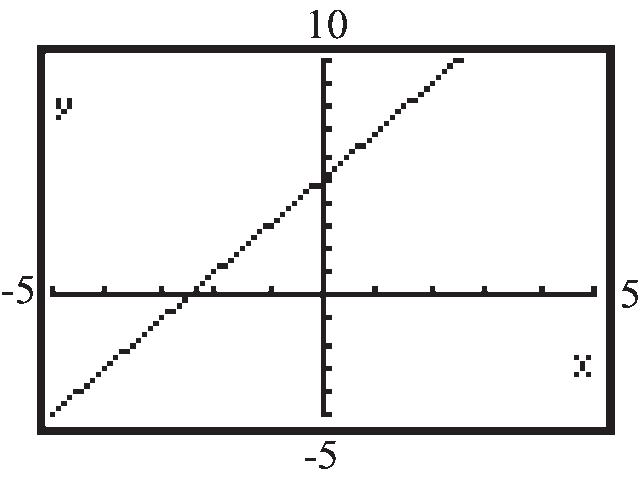
The graph and the secant line coincide.
86. ()32fxx
a. sec ()()
3()2(32) 3 3 fxhfx m h xhx h hh
b. When x = 1,
sec 0.53hm sec 0.13hm sec 0.013hm sec as 0, 3 hm
c. Using point 1,11,1 f and slope = 3 , we get the secant line:
131 133 32 yx yx yx
d. Graphing:
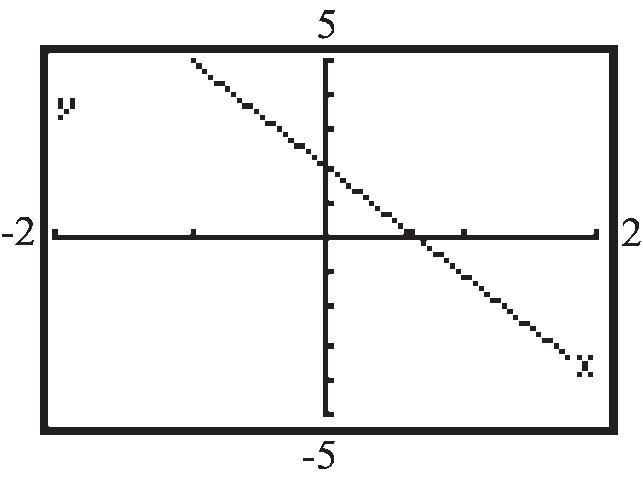
The graph and the secant line coincide.
87. 2 ()2 f xxx
a. sec 22 222 2 ()() ()2()(2) 2222 22 22 fxhfx m h xhxhxx h x xhhxhxx h xhhh h x h
b. When x = 1, sec 0.5210.524.5hm sec 0.1210.124.1hm sec 0.01210.0124.01hm sec as 0, 21024 hm
c. Using point 1,11,3 f and slope = 4.01, we get the secant line: 34.011 34.014.01 4.011.01 yx yx yx
d. Graphing:

88. 2 ()2 f xxx
a.
b. When x =
sec as 0, 412015 hm
c. Using point 1,11,3
and slope = 5.02, we get the secant line:
d. Graphing:
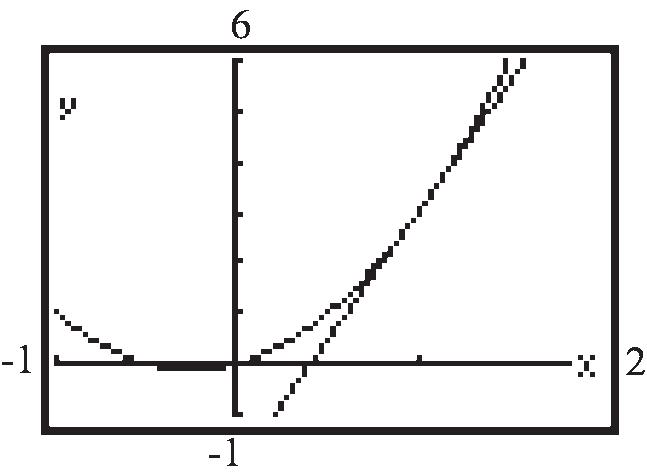
b. When x = 1, sec 0.54120.532hm sec 0.14120.131.2hm sec 0.014120.0131.02hm sec as 0, 412031 hm
c. Using point 1,11,0 f and slope = 1.02, we get the secant line: 01.021 1.021.02 yx yx
d. Graphing:

90. 2 ()32 fxxx
a. sec ()() f xhfx m h 222 222 2 2 2 (2)33232 233232 3232 23 23 xxhhxhxx h xxhhxhxx h xhxhxx h xhhh h xh
b. When x = 1, sec 0.5210.530.5hm sec 0.1210.130.9hm sec 0.01210.0130.99hm sec as 0, 21031 hm
c. Using point 1,11,0 f and slope = 0.99, we get the secant line: 00.991 0.990.99 yx yx
Chapter 2: Functions and Their Graphs
d. Graphing:
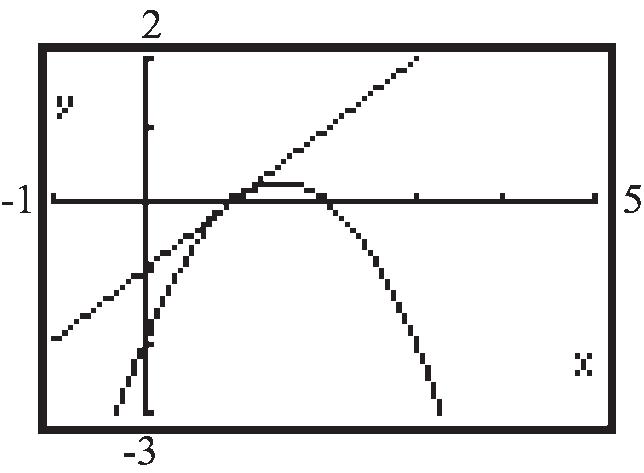
1 ()fx x
a.
d. Graphing:

2 2 2 2 222
b. When x = 1,
c. Using point
c. Using point 1,11,1 f and slope = 1.9704 , we get the secant line:
d. Graphing:
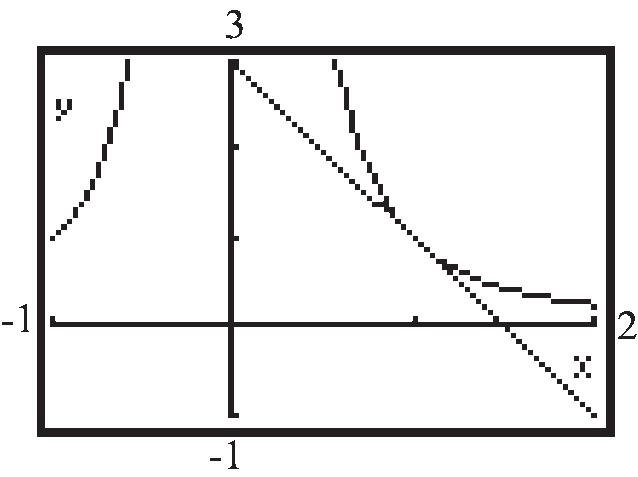
93. 2 2 (2)12 and (1)8, so (2)(1) 12 4 2(1)3 ()4 3414 3450
95. Answers will vary. One possibility follows:
2)
3)
0) (2, 6)
96. Answers will vary. See solution to Problem 89 for one possibility.
97. A function that is increasing on an interval can have at most one x-intercept on the interval. The graph of f could not "turn" and cross it again or it would start to decrease.
98. An increasing function is a function whose graph goes up as you read from left to right.
The only such number is 219 3
A decreasing function is a function whose graph goes down as you read from left to right.
99. To be an even function we need
and to be an odd function we need
. In order for a function be both
Chapter 2: Functions and Their Graphs
even and odd, we would need f xfx
This is only possible if 0 fx .
100. The graph of 5 y is a horizontal line.
xhykr xy xy
The local maximum is 5 y and it occurs at each x-value in the interval.
101. Not necessarily. It just means 52ff
The function could have both increasing and decreasing intervals.
102. 21 2121 ()() 0 (2)(2) 00 0 4 22 fxfx bb xxxx ff
103. 54036(15)615 104. 2 22 22 (4)(4)(4) 1644 168
2553 22311531322 62312531 623151031 62318101
109. 1212 3 5 7 5 , 22 2 1(4) , 22 373 ,, 22102
110. 3735 378 378 or 378 315 31 1 5 3 x x xx xx xx
The solution set is 1 5, 3
xx xx xx xx xx xx
111. 63 63 33 33 33 78 780 (8)(1)0 80 or 10 8 1 2 1
The solution set is 2,1
Section 2.4
1. y x
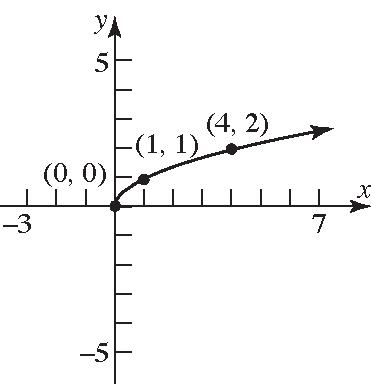
2. y 1 x

3. y x 3 8 y-intercept:
Let 0 x , then 3 088 y x-intercept:
Let 0 y , then 3 3 08 8 2 x x x
The intercepts are 0,8 and 2,0 .
4. ,0
5. piecewise-defined
Section 2.4: Library of Functions; Piecewise-defined Functions
6. True
7. False; the cube root function is odd and increasing on the interval , .
8. False; the domain and range of the reciprocal function are both the set of real numbers except for 0.
9. b
10. a
11. C
12. A 13. E 14. G 15. B 16. D 17. F 18. H 19. f xx 20. 2 f xx
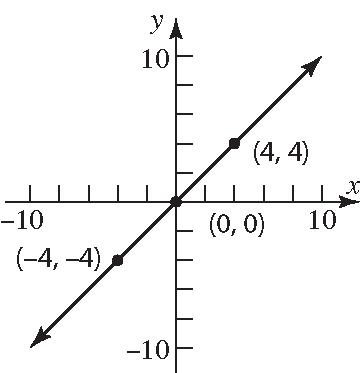
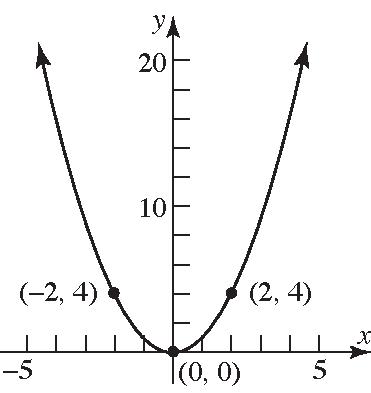
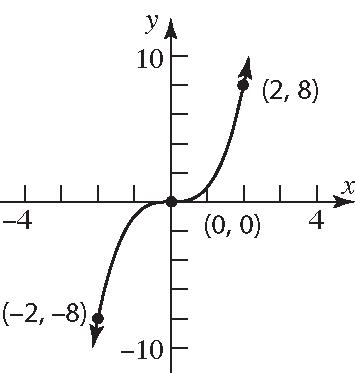


1 fx x 24. f xx 25. 3 () f xx

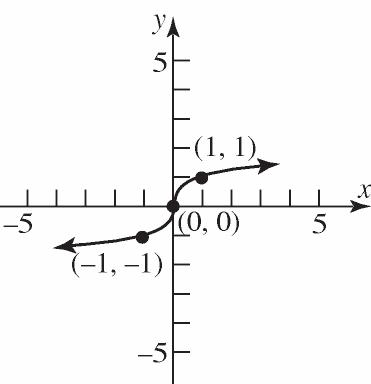
26. 3 fx
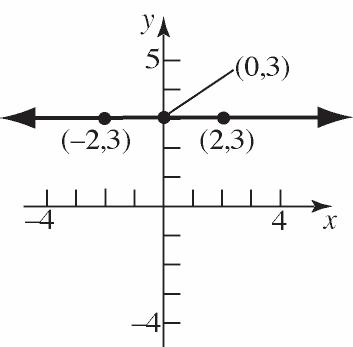
27. a. 2 (3)(3)9 f
b. (0)4 f
c. (2)3(3)27 f
28. a. 2326 f
b. 10 f
c. 2 02011 f
29. a. 22240 f
b. 02044 f
c. 12146 f
d. 3 33126 f
30. a. 3 (1)(1)1 f
b. 3 (0)00 f
c. (1)3(1)25 f
333211 f
31. 2if 0 () 1 if 0 xx fx x
a. Domain: is any real number xx
b. x-intercept: none y-intercept:
The only intercept is 0,1.
c. Graph:

d. Range: 0 yy ; ,00,
32. 3if 0 () 4 if 0 xx fx x
a. Domain: is any real number xx
b. x-intercept: none y-intercept: 04 f
The only intercept is 0,4.
c. Graph:
Range:
Section 2.4: Library of Functions; Piecewise-defined Functions
33. 23if 1 () 32 if 1 x x fx xx
a. Domain: is any real number xx
b. x-intercept: none y-intercept:
02033 f
The only intercept is
c. Graph:
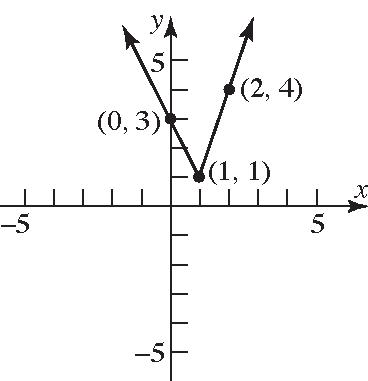
d. Range: 1 yy
34. 3if 2 () 23if 2 xx fx xx
a. Domain: is any real number xx b. 30 3 x
x-intercepts: 3 3, 2
y-intercept:
The intercepts are 3,0 , 3 ,0 2
0,3
c. Graph:
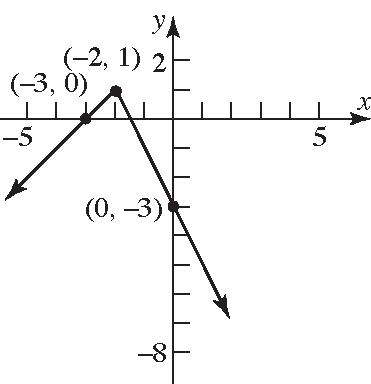
Chapter 2: Functions and Their Graphs
d. Range: 1 yy ; ,1
35. 3if 21 ()5 if 1 2 if 1 x x fxx xx
a. Domain: 2 xx ;
b. 30 3 (not in domain) x x 20 2 2 x x x
x-intercept: 2
y-intercept: 0033 f
The intercepts are 2,0 and
c. Graph:
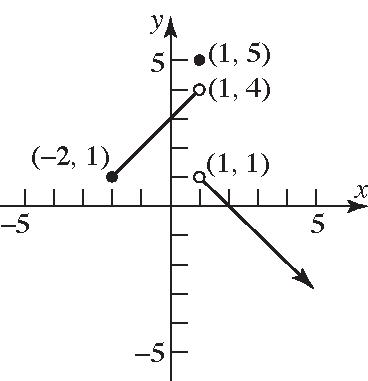
0,3
d. Range: 4, 5 yyy ; ,45
25if 30 ()3 if 0 5 if 0 xx fxx xx
Domain:
b. 250 25 5 2 x x x 50 0 (not in domain of piece) x x
x-intercept: 5 2
y-intercept:
03 f
The intercepts are 5 ,0 2
and
0,3
c. Graph:
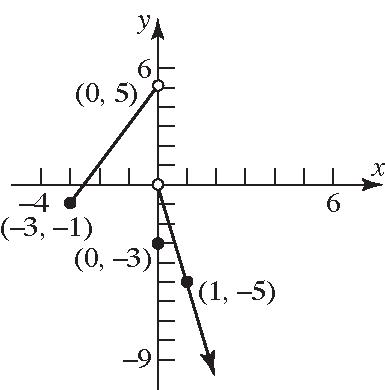
d. Range: 5 yy ; ,5
37. 2 1if 0 () if 0 xx fx xx
a. Domain: is any real number xx
b. 10 1 x x 2 0 0 x x
x-intercepts: 1,0
y-intercept: 2 000 f
The intercepts are 1,0 and 0,0
c. Graph:
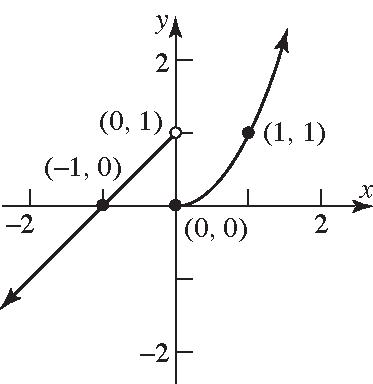
d. Range: is any real number yy 38. 3 1 if 0 () if 0 x x fx xx
a. Domain: is any real number xx
b. 1 0 (no solution) x 3 0 0 x x
x-intercept: 0
y-intercept: 3 000 f
The only intercept is 0,0
Section 2.4: Library of Functions; Piecewise-defined Functions
c. Graph:

d. Range: is any real number yy
39. 3 if 20 () if 0 xx fx xx
a. Domain: 20 and 0 xxx or |2,0xxx ; 2,00,
b. x-intercept: none
There are no x-intercepts since there are no values for x such that 0 fx .
y-intercept: There is no y-intercept since 0 x is not in the domain.
c. Graph:
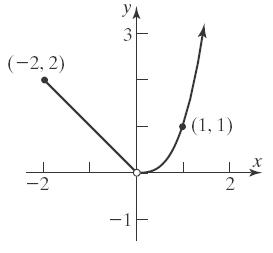
d. Range: 0 yy ; 0,
40. 2if 31 () if 1 x x fx xx
a. Domain: 31 and 1 xxx or |3,1xxx ; 3,11,
b. 20 2 x x 0 0 (not in domain of piece) x x no x-intercepts y-intercept: 0202 f
The intercept is 0,2.
c. Graph: y 5 x 5 5 5 (3, 5) (0, 2) (4, 2)
d. Range: 1 yy ; 1,
41. 2 if 02 ()2 if 25 7 if 5 xx fxxx
a. Domain: 0 xx ; 0,
b. 2 0 0
(not in domain of piece) x x 20 2 (not in domain of piece) x x 70 (not possible) No intercepts.
Chapter 2: Functions and Their Graphs
c. Graph:
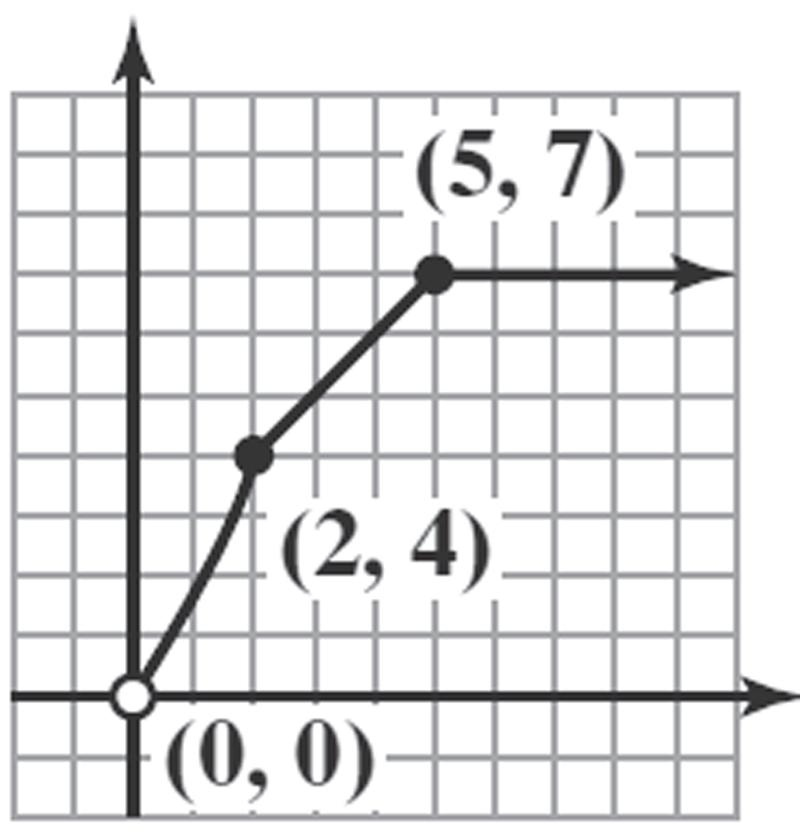
Range:
a. Domain:
c. Graph:
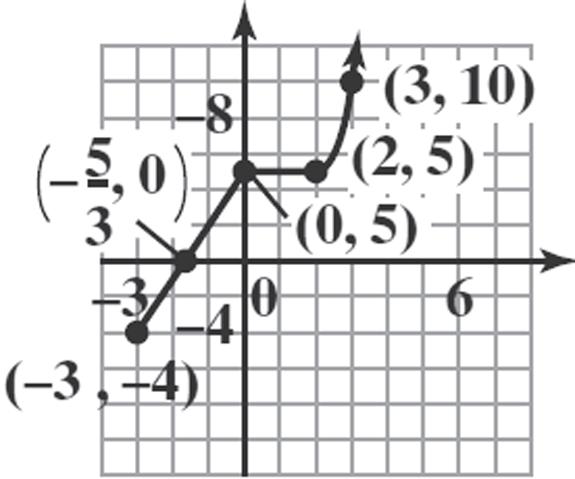
d. Range: 4,
43. Answers may vary. One possibility follows: if 10 () 1 if 02 2 xx fx xx
44. Answers may vary. One possibility follows: if 10 () 1 if 02 xx fx x
45. Answers may vary. One possibility follows: if 0 () 2 if 02 xx fx xx
46. Answers may vary. One possibility follows: 22 if 10 () if 0 xx fx xx
47. a. (1.7)int2(1.7)int(3.4)3 f
(2.8)int2(2.8)int(5.6)5 f
c. (3.6)int2(3.6)int(7.2)8 f
48. a. 1.2 (1.2)intint(0.6)0 2 f
b. 1.6 (1.6)intint(0.8)0 2 f
c. 1.8 (1.8)intint(0.9)1 2 f
49. a.
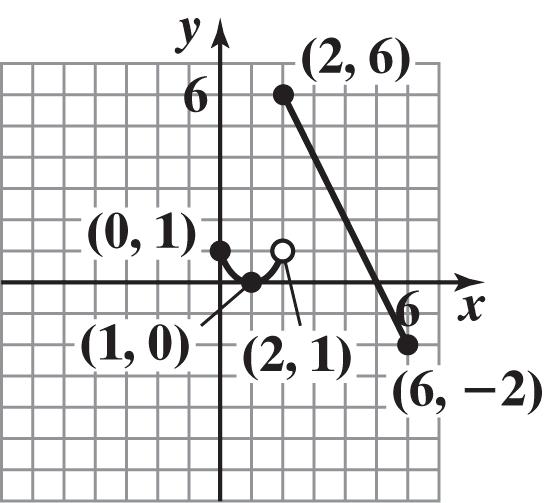
b. The domain is 0,6 .
c. Absolute max: (2)6 f Absolute min: (6)2 f
50. a.
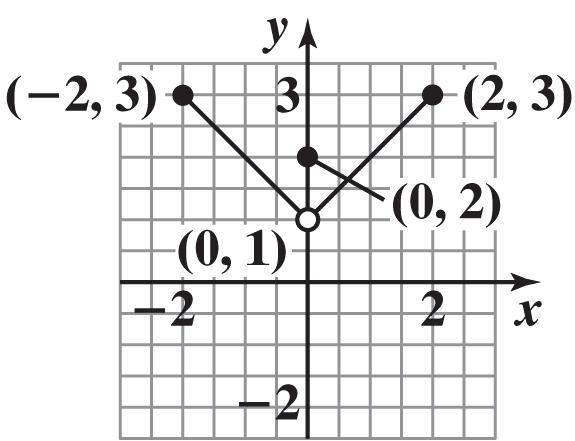
b. The domain is 2,2 .
c. Absolute max: (2)(2)3ff
Absolute min: none
51. 0.1317 if 03 0.423.5 if 150 xx C xx
a. 760.137617$26.88 C
b. 1330.1313317$34.29 C
c. 1890.418923.5$52.10 C
Section 2.4: Library of Functions; Piecewise-defined Functions
For 200 x : 1001.550Cx For 200 x : 1001.51501.15(200) 3251.15(200) Cx x
The cost function: 2 if 050 1001.5(50) if 50200 3251.15(200) if 200 xx Cxx xx
d. Graph:
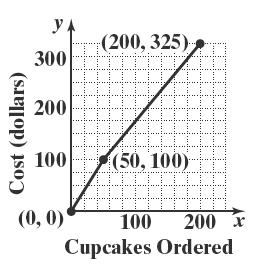
52.
33int102 64int224 3648 77824 xx Fxxx x x
a. 0.533int(10.5)3 F
Parking for 0.5 hours costs $3.
b. 233int126 F
Parking for 2 hours costs $6.
c. 3.2564int23.2514 F
Parking for 3.5 hours costs $14.
d. 836 F
Parking for 8 hours costs $36.
53. a. Charge for 2 dozen: 2.00(24) $48.00 C
b. Charge for 120 cupcakes: 1001.5(50)
1001.5(12050) $205 Cx
c. For 050 x : 2 Cx
54. a. Taxes for $48,000: 0.08(48000)
$3840 T
b. Taxes for $132,000: 0.08(75000)0.16(57000)
$15,120 T
c. Taxes for $231,000: 0.08(75000)0.16(125000)0.22(31000) $32,820 T
d. For 075,000 x : 0.08 Tx
For 75,000200,000 x : 0.08(75,000)0.16(75,000) 60000.16(75,000) Tx x
For 200,000350,000 x : 0.08(75,000)0.16(12,5000) 0.22(200,000) 260000.22(200000)
T x x
For 350000 x : 590000.3(350000)Tx
Chapter 2: Functions and Their Graphs
The tax function:
0.08if075,000
60000.16(75,000)if75,000200,000
26,0000.22(200,000)if200,000350,000
59,0000.3(350,000) if 350,000
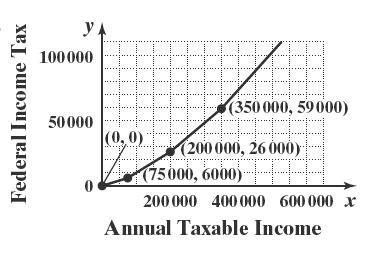
55. For schedule X: 0.10if 011,000
11000.12(11,000)if 11,00044,725 5,1750.22(44,725)if 44,72595,375 () 16,2900.24(95,375)if 95,375182,100
37,1040.32(182,100)if 182,100
52,8320.35(231,250) xx xx
231,250 if 231,250578,126 174,2380.37(578,126)if 578,126
56. For Schedule Y1 : 0.10if 022,000 22000.12(22,000)if 22,00089,450
10,2940.22(89,450)if 89,450190,750 () 32,5800.24(190,750)if 190,750364,200 74,2080.32(364,200)if 364 105,6640.35(462,500) xx xx
186,6010.37(693,750)if 693,750 x x xx
,200462,500 if 462,500693,750
57. a. Let x represent the number of miles and C be the cost of transportation. 0.50 if 0100
0.50(100)0.40(100) if 100400 ()
0.50(100)0.40(300)0.25(400) if 400800
0.50(100)0.40(300)0.25(400)0(800) if 800960
0.50if 0100
Section 2.4: Library of Functions; Piecewise-defined Functions
100.40if 100400 () 700.25if 400800 270 if 800960

b. For hauls between 100 and 400 miles the cost is: ()100.40 Cxx
c. For hauls between 400 and 800 miles the cost is: ()700.25 Cxx .
58. Let x = number of days car is used. The cost of renting is given by
185 if 7
222 if 78
259 if 89
given by
9000 if 659
8250 if 660679
5250 if 680699
3750 if 700719
296 if 910
333 if 1011
370 if 1114 x x x Cx x x

59. a. Let s = the credit score of an individual who wishes to borrow $300,000 with an 80% LTV ratio. The adverse market delivery charge is
2250 if 720739
1500 if 740
b. 725 is between 720 and 739 so the charge would be $2250.
c. 670 is between 660 and 679 so the charge would be $8250.
60. Let x = the amount of the bill in dollars. The minimum payment due is given by
70 if 1500 xx x fxx x x
if 010
10 if 10500
30 if 5001000
50 if 10001500
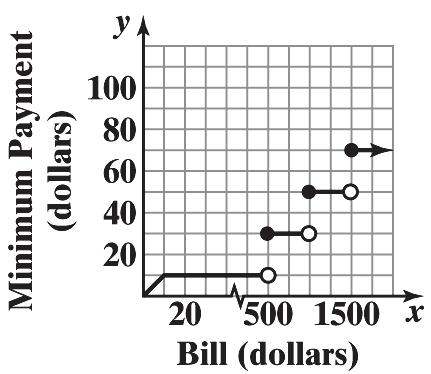
61. a. 10 WC
b. (10.451055)(3310) 334 22.04 WC
c. (10.45101515)(3310) 333 22.04 WC
d. 331.5958(3310)4 WC
e. When 01.79 v , the wind speed is so small that there is no effect on the temperature.
f. When the wind speed exceeds 20, the wind chill depends only on the air temperature.
62. a. 10 WC
b.
d. 331.5958331036 WC
63. Let x = the sales made and Sx = the total salary.
For 0250,000 x : $45,0000.04 Sxx
For 250,000500,000 x :
55,0000.06(250,000)Sxx
For 500,000 x : 70,0000.09(500,000)Sxx
64. Use intervals 0,8,8,16,16,32,32,38 (exclude 0 and 38 since those would be the walls). Depth for the intervals
8,16 and 32,38 are constant (8 ft and 3 ft respectively). The other two are linear functions. On 0,8 the endpoint coordinates can be thought or as 0,3 and 8,8 8355 3 8088 myx
m b b yx
On 16,32 the endpoint coordinates can be thought of as 16,8 and 32,3 . 385 321616 5 8(16) 16 13 5 13 16
Therefore, 5 3 if 08 8 8 if 816 () 5 13 if 1632 16 3 if 3238
xx x dx xx x
65. The function f changes definition at 2 and the function g changes definition at 0. Combining these together, the sum function will change definitions at 0 and 2.
On the interval ,0 : ()()()()(23)(41) 24 fgxfxgxxx x
On the interval 0,2 : ()()()(23)(7) 34 fgxfxgxxx x .
On the interval 2, : 2 2 ()()()()(5)(7) 67 fgxfxgxxxx xx
So, 2 24if0 ()34if02 67if2
xx fgxxx xxx
66. Each graph is that of 2 y x , but shifted vertically.
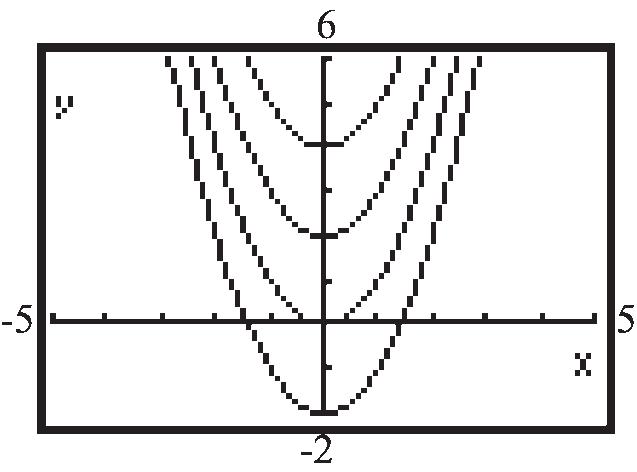
If 2 ,0yxkk , the shift is up k units; if 2 ,0yxkk , the shift is down k units. The graph of 2 4 yx is the same as the graph of 2 y x , but shifted down 4 units. The graph of 2 5 yx is the graph of 2 y x , but shifted up 5 units.
67. Each graph is that of 2 y x , but shifted horizontally.
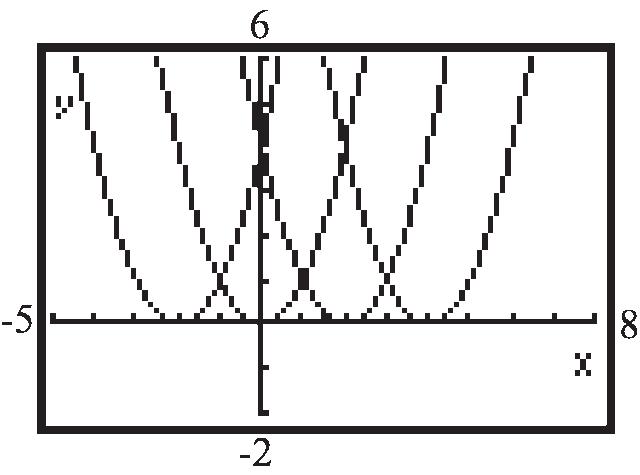
If 2 (),0yxkk , the shift is to the right k units; if 2 (),0yxkk , the shift is to the left k units. The graph of 2 (4)yx is the same as the graph of 2 y x , but shifted to the left 4 units. The graph of 2 (5)yx is the graph of 2 y x , but shifted to the right 5 units.
68. Each graph is that of y x , but either compressed or stretched vertically.
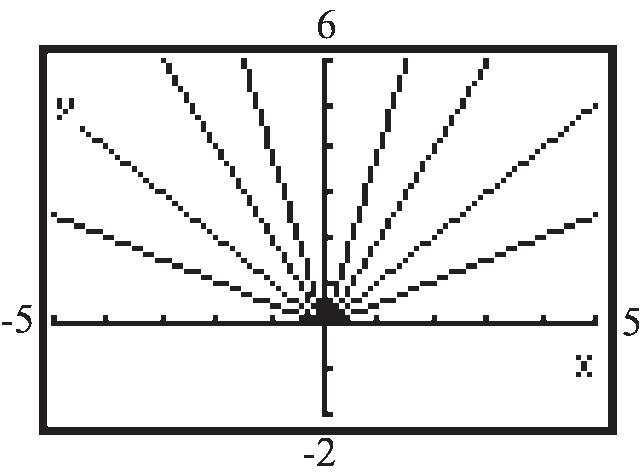
If y kx and 1 k , the graph is stretched vertically; if and 01ykxk , the graph is
compressed vertically. The graph of 1 4 yx is the same as the graph of y x , but compressed vertically. The graph of 5 y x is the same as the graph of y x , but stretched vertically.
69. The graph of 2 y x is the reflection of the graph of 2 y x about the x-axis.
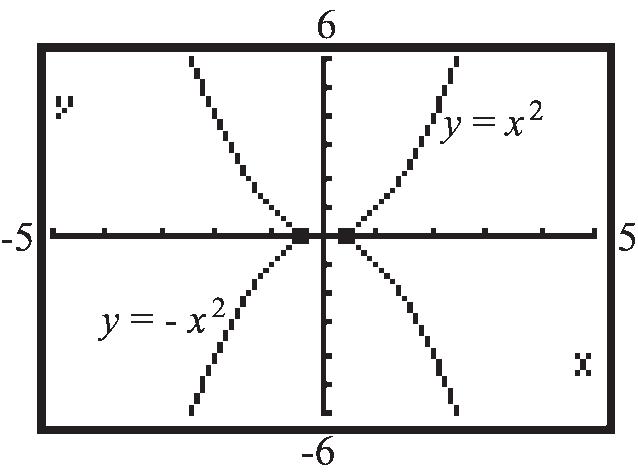
The graph of y x is the reflection of the graph of y x about the x-axis.
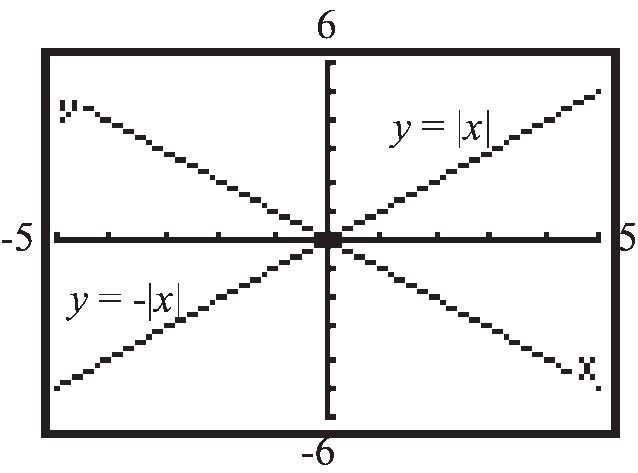
Multiplying a function by –1 causes the graph to be a reflection about the x-axis of the original function's graph.
70. The graph of y x is the reflection about the y-axis of the graph of y x .
5 yx y x

The same type of reflection occurs when graphing 21 and 2()1yxyx
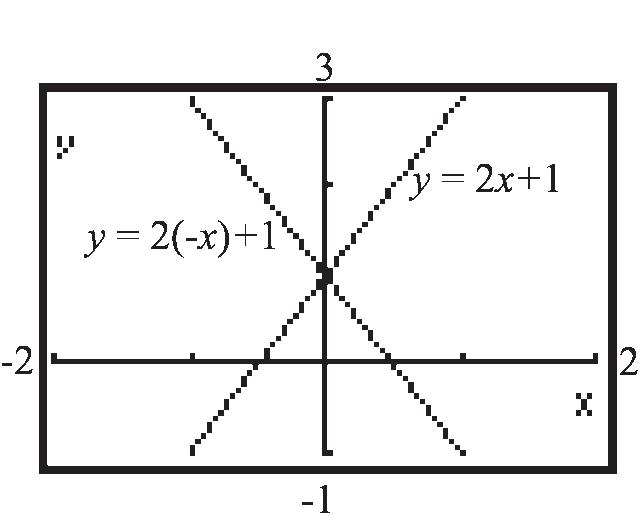
The graph of ()yfx is the reflection about the y-axis of the graph of ()yfx
71. The graph of 3 (1)2yx is a shifting of the graph of 3 y x one unit to the right and two units up. Yes, the result could be predicted.
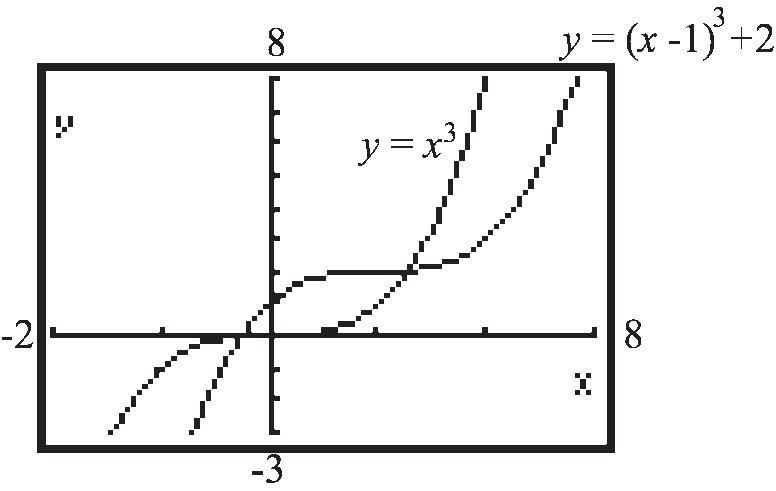
72. The graphs of , n y x n a positive even integer, are all U-shaped and open upward. All go through the points (1,1) , (0,0) , and (1,1) . As n increases, the graph of the function is narrower for 1 x and flatter for 1 x .
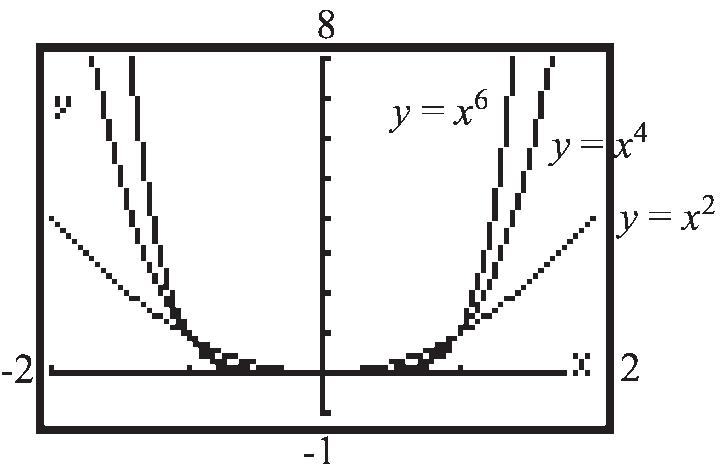
73. The graphs of , n y x n a positive odd integer, all have the same general shape. All go through
the points (1,1) , (0,0) , and (1,1) . As n increases, the graph of the function increases at a greater rate for 1 x and is flatter around 0 for 1 x
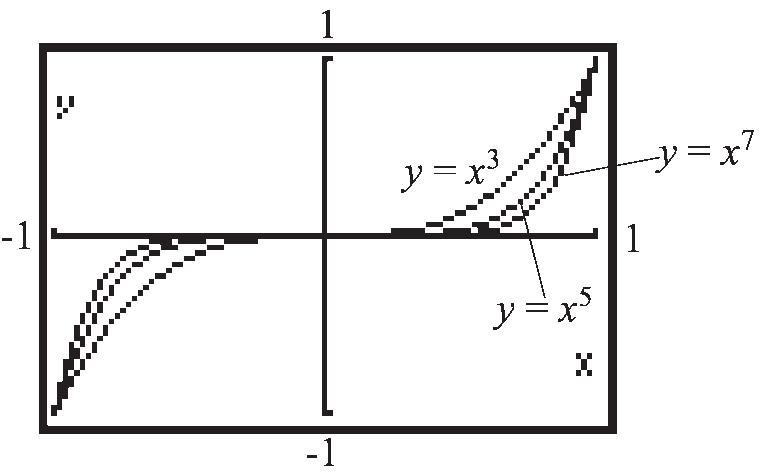
74. 1 if is rational 0 if is irrational x fx x
Yes, it is a function.
Domain = is any real number xx or ,
Range = {0, 1} or |0 or 1 yyy
y-intercept: 0 is rational1xxy
So the y-intercept is 1 y
x-intercept: 0 is irrational yx
So the graph has infinitely many x-intercepts, namely, there is an x-intercept at each irrational value of x
1 f xfx when x is rational; 0 f xfx when x is irrational.
Thus, f is even.
The graph of f consists of 2 infinite clusters of distinct points, extending horizontally in both directions. One cluster is located 1 unit above the x-axis, and the other is located along the x-axis.
75. Answers will vary.
76. 6 352610 10 () x xyxy y
Section 2.5: Graphing Techniques: Transformations
77. 22 22 22 222 616 616 (69)169 (3)5 xyy xyy xyy xy
Center (h,k): (0, 3); Radius = 5
78. 45(21)47(1) 4105477 6573 8
The solution set is: {8}
79. Let x represent the amount of money invested in a mutual fund. Then 60,000 x represents the amount of money invested in CD's. Since the total interest is to be $3700, we have:
0.080.03(60,000)3700
Section 2.5
1. horizontal; right
2. y
3. False
1000.080.03(60,000)3700100
83(60,000)370,000 8180,0003370,000 5180,000370,000 5190,000 38,000 xx xx xx xx x x x
$38,000 should be invested in a mutual fund at 8% and $22,000 should be invested in CD's at 3%.
80. 213 06 224 1 162
Quotient: 2 2 xx Remainder:
84. The radicand cannot be negative so: 70 7
x x The domain is |7 xx .
4. True; the graph of y fx is the reflection about the x-axis of the graph of y fx
5. d 6. b 7. B 8. E 9. H
10. D 11. I 12. A 13. L 14. C 15. F 16. J 17. G 18. K
19. (4)3yx
20. (4)3yx 21. 3 4 yx 22. 3 4 yx
23. 3 3 yxx 24. 3 y x 25. 3 5 y x 26. 3 3 11 464 y xx
3 3 28 yxx 28. 3 1 4 yx 29. (1)2 yx
(2)2 (3)22 yx yxx
30. (1) y x (2)3 (3)32 yx yx
31. (1)3 y x (2)34 (3)354
yx yx
32. (1)2 yx (2)2 (3)(3)232 yx yxx
33. (c); To go from y fx to y fx we reflect about the x-axis. This means we change the sign of the y-coordinate for each point on the graph of ()yfx . Thus, the point (3,6) would become 3,6
34. (d); To go from y fx to y fx , we reflect each point on the graph of y fx about the y-axis. This means we change the sign of the x-coordinate for each point on the graph of y fx . Thus, the point 3,6 would become 3,6 .
35. (c); To go from y fx to 2 y fx , we stretch vertically by a factor of 2. Multiply the y-coordinate of each point on the graph of y fx by 2. Thus, the point 1,3 would become 1,6
36. (c); To go from y fx to 2 y fx , we compress horizontally by a factor of 2. Divide the x-coordinate of each point on the graph of y fx by 2. Thus, the point 4,2 would become 2,2
37. 2 ()1fxx
Using the graph of 2 y x , vertically shift downward 1 unit.
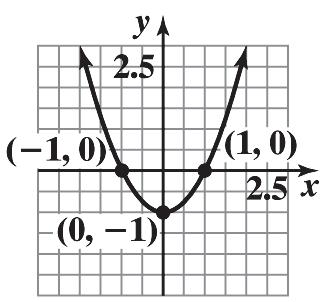
The domain is , and the range is 1,
38. 2 ()4fxx
Using the graph of 2 y x , vertically shift upward 4 units.
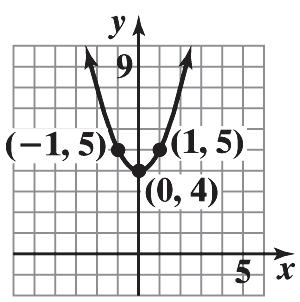
The domain is , and the range is 4,
39. ()3 g xx
Using the graph of y x , horizontally compress by a factor of 3.
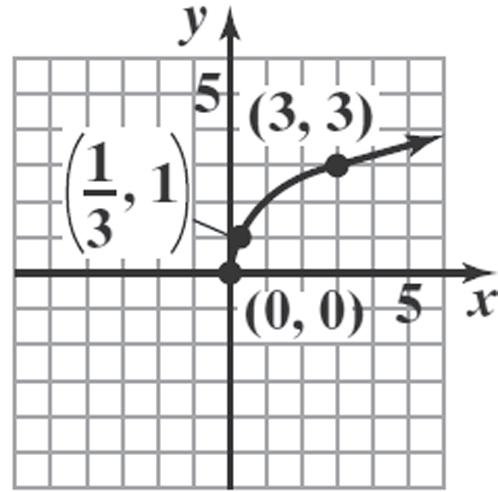
The domain is 0, and the range is 0,
40. 3 1 () 2 g xx
Using the graph of 3 y x , horizontally stretch by a factor of ½.

The domain is , and the range is
,

41. ()2hxx
Using the graph of y x , horizontally shift to the left 2 units.
Section 2.5: Graphing Techniques: Transformations

The domain is 2, and the range is 0,
.
42. ()1hxx
Using the graph of y x , horizontally shift to the left 1 unit.
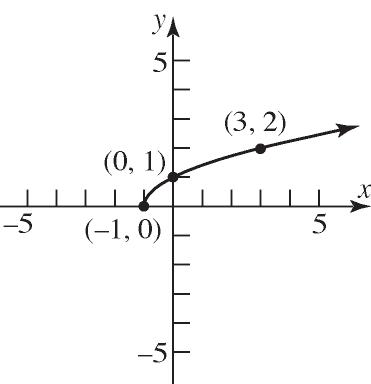
The domain is 1, and the range is
43. 3 ()(1)2fxx
0,
.
Using the graph of 3 y x , horizontally shift to the right 1 unit 3 1 yx , then vertically shift up 2 units
3 12 yx
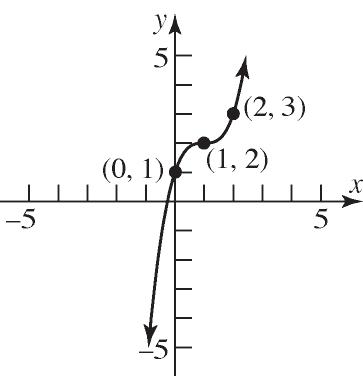
The domain is , and the range is
, .
Chapter 2: Functions and Their Graphs
44. 3 ()(2)3fxx
Using the graph of 3 y x , horizontally shift to the left 2 units 3 2 yx
, then vertically shift down 3 units
3 23 yx
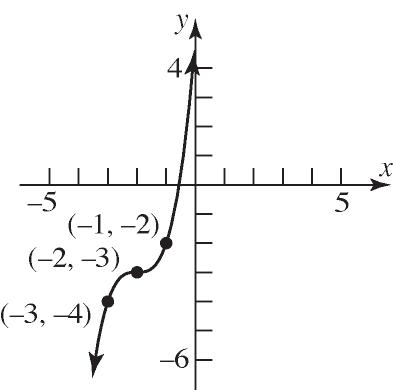
The domain is , and the range is
45. ()4 g xx
Using the graph of y x , vertically stretch by a factor of 4.

The domain is 0,
and the range is
46. 1 () 2 g xx
.
Using the graph of y x , vertically compress by a factor of 1 2
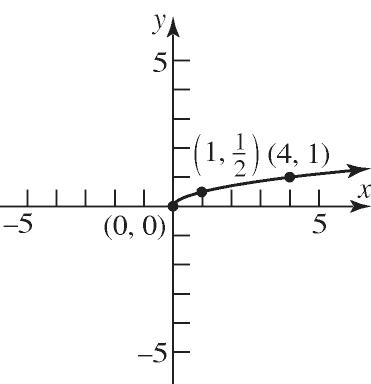
The domain is 0, and the range is 0,
47. 3 () f xx
Using the graph of 3 y x , reflect the graph about the x-axis.

The domain is , and the range is
48. () f xx
Using the graph of y x , reflect the graph about the x-axis.
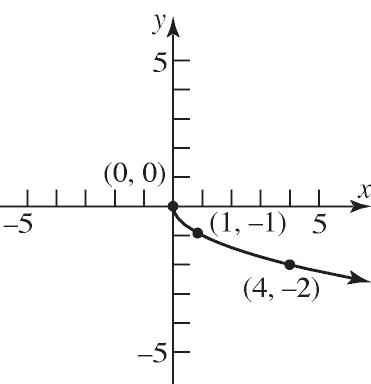
The domain is 0, and the range is ,0
49. 2 ()2(1)3fxx
Using the graph of 2 y x , horizontally shift to the left 1 unit 2 1 yx
, vertically stretch by a factor of 2
2 21yx
, and then vertically shift downward 3 units
2 213yx
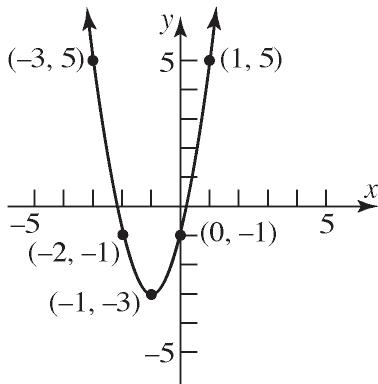
The domain is , and the range is
3,
50. 2 ()3(2)1fxx
Using the graph of 2 y x , horizontally shift to the right 2 units 2 2 yx
, vertically stretch by a factor of 3
2 32yx
, and then vertically shift upward 1 unit
2 321yx
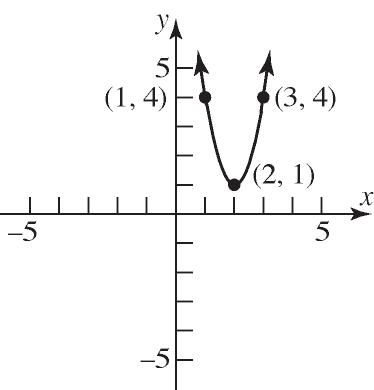
The domain is , and the range is 1,
.
Section 2.5: Graphing Techniques: Transformations
51. ()221gxx
Using the graph of y x , horizontally shift to the right 2 units 2 yx , vertically stretch by a factor of 2 22yx , and vertically shift upward 1 unit 221yx
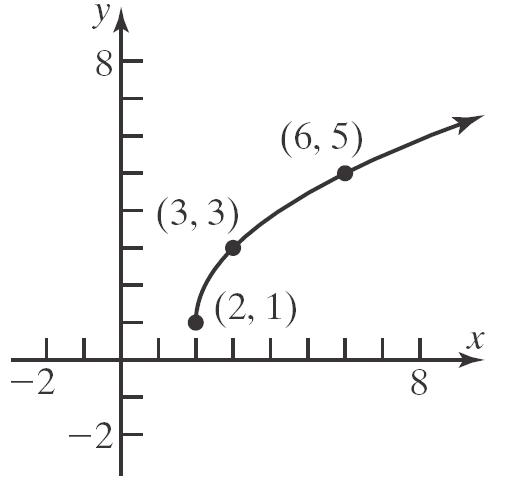
The domain is 2, and the range is 1, .
52. ()313gxx
Using the graph of y x , horizontally shift to the left 1 unit 1 yx , vertically stretch by a factor of 3 31yx , and vertically shift downward 3 units 313yx .

The domain is , and the range is 3,
53. ()2hxx
Using the graph of y x , reflect the graph about the y-axis yx
and vertically shift downward 2 units 2 yx
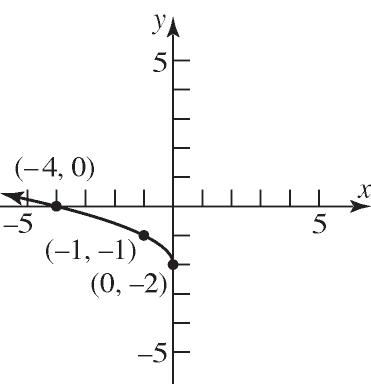
The domain is ,0
and the range is 2,
54. 41 ()242hx xx
Stretch the graph of 1 y x vertically by a factor of 4 14 4 y x x
and vertically shift upward 2 units 4 2 y x

The domain is ,00, and the range is
,22,
55. 3 ()(1)1fxx
Using the graph of 3 y x , horizontally shift to the left 1 unit
3 1 yx
, reflect the graph about the x-axis
3 1 yx
, and vertically shift downward 1 unit
3 11 yx
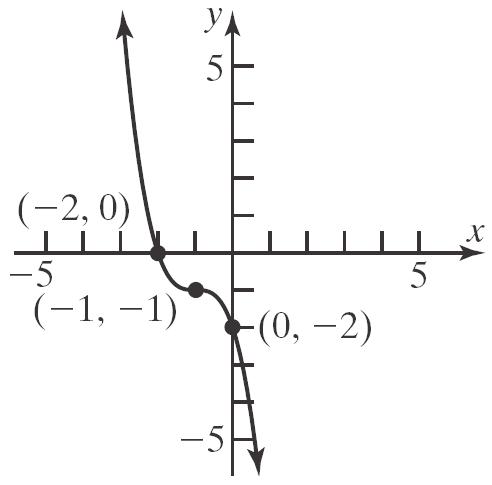
The domain is , and the range is , .
56. ()41 f xx
Using the graph of y x , horizontally shift to the right 1 unit 1 yx
, reflect the graph about the x-axis 1 yx
, and stretch vertically by a factor of 4 41yx .
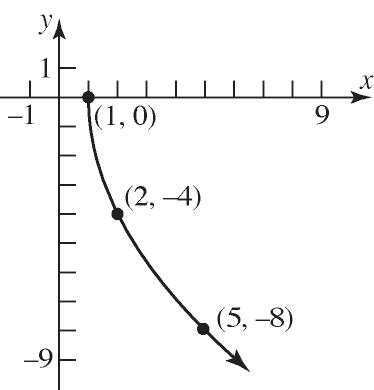
The domain is 1, and the range is ,0 .
57. ()212121 gxxxx
Using the graph of y x , horizontally shift to the right 1 unit 1 yx , and vertically stretch by a factor or 2 21yx .
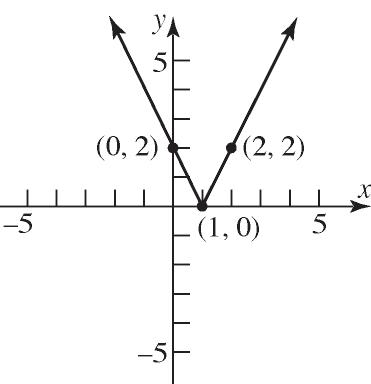
The domain is , and the range is 0, .
58. ()424(2) gxxx
Using the graph of y x , reflect the graph about the y-axis yx , horizontally shift to the right 2 units 2 yx , and vertically stretch by a factor of 4
42yx
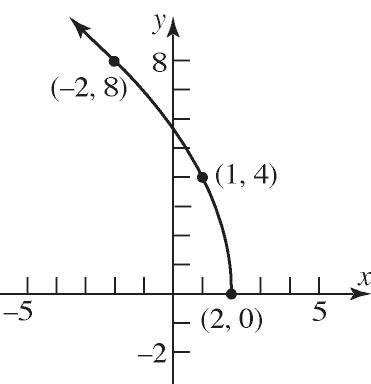
The domain is ,2 and the range is 0,
59. 1 () 2 hx x
Using the graph of 1 y x , vertically compress by a factor of 1 2
Section 2.5: Graphing Techniques: Transformations
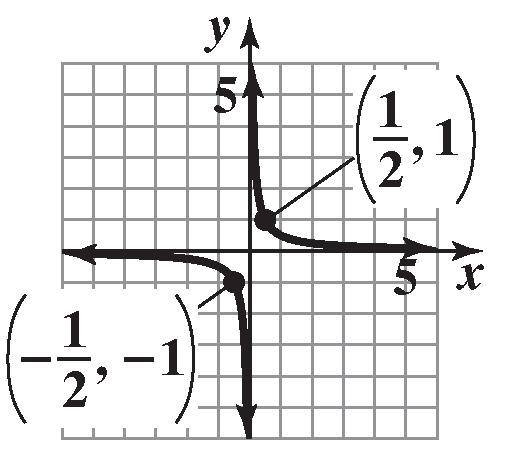
The domain is ,00, and the range is ,00,
60. 3 ()13fxx
Using the graph of 3 () f xx , horizontally shift to the right 1 unit 3 1 yx , then vertically shift up 3 units 3 13 yx .
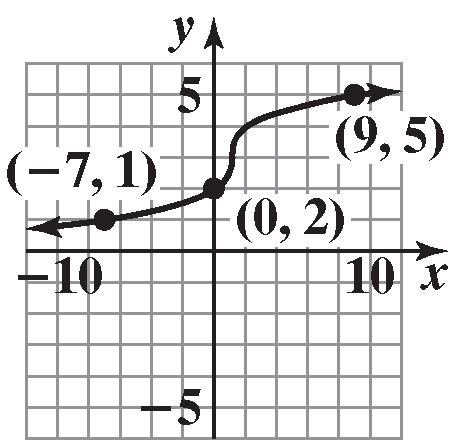
The domain is , and the range is ,
61. a. ()()3Fxfx Shift up 3 units.
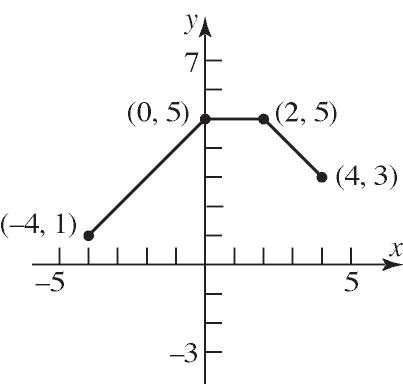
Chapter 2: Functions and Their Graphs
b. ()(2)Gxfx Shift left 2 units.

c. ()() Pxfx Reflect about the x-axis.
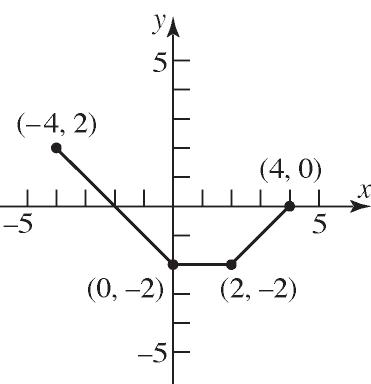
d. ()(1)2Hxfx Shift left 1 unit and shift down 2 units.
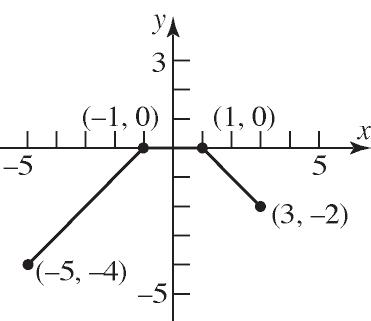
e. 1 ()() 2 Qxfx
Compress vertically by a factor of 1 2 .
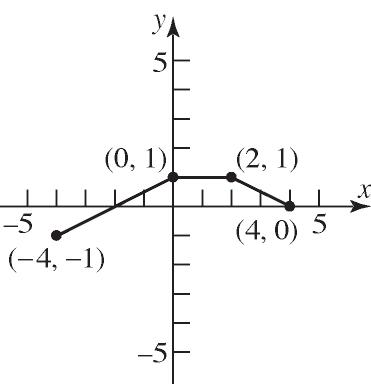
f. ()() g xfx
Reflect about the y-axis.
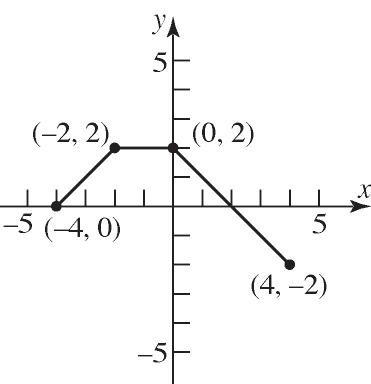
g. ()(2) hxfx
Compress horizontally by a factor of 1 2

62. a. ()()3Fxfx Shift up 3 units.
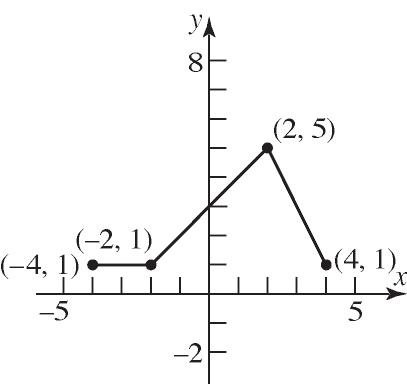
b. ()(2)Gxfx Shift left 2 units.

c. ()() Pxfx
Reflect about the x-axis.

d. ()(1)2Hxfx Shift left 1 unit and shift down 2 units.
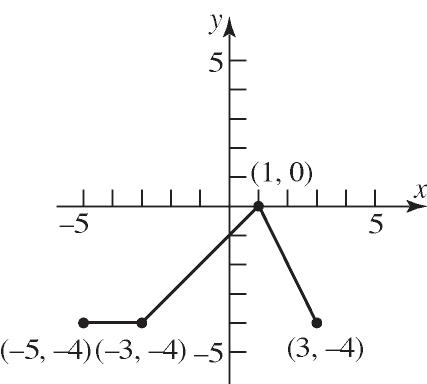
e. 1 ()() 2 Qxfx
Compress vertically by a factor of 1 2 .
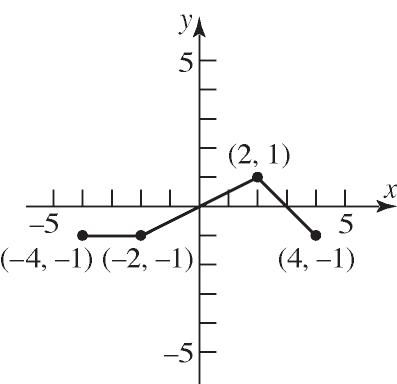
f. ()() g xfx
Reflect about the y-axis.
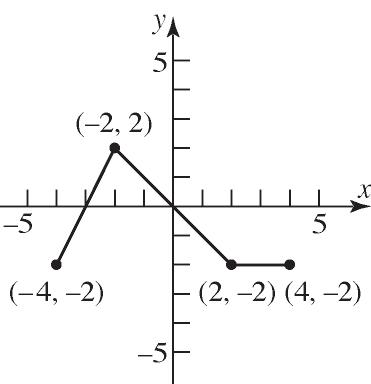
Section 2.5: Graphing Techniques: Transformations
g. ()(2) hxfx
Compress horizontally by a factor of 1 2 .

63. a. ()()3Fxfx Shift up 3 units.
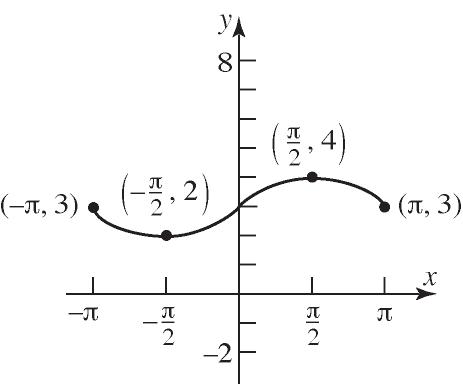
b. ()(2)Gxfx Shift left 2 units.

c. ()() Pxfx Reflect about the x-axis.
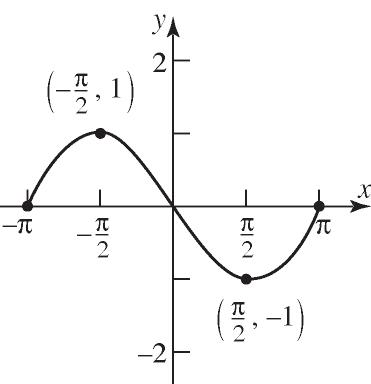
Chapter 2: Functions and Their Graphs
d. ()(1)2Hxfx Shift left 1 unit and shift down 2 units.
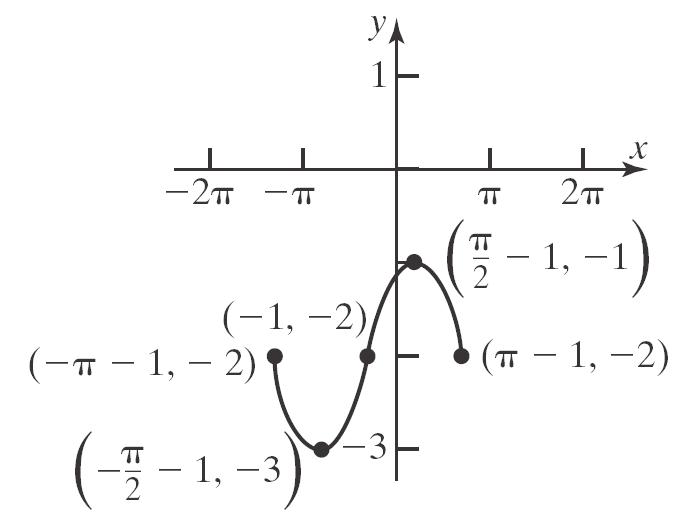
e. 1 ()() 2 Qxfx
Compress vertically by a factor of 1 2
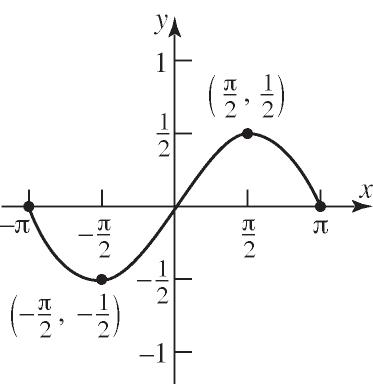
f. ()() g xfx
Reflect about the y-axis.

g. ()(2) hxfx
Compress horizontally by a factor of 1 2
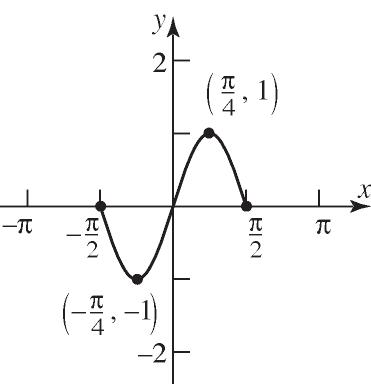
64. a. ()()3Fxfx Shift up 3 units.
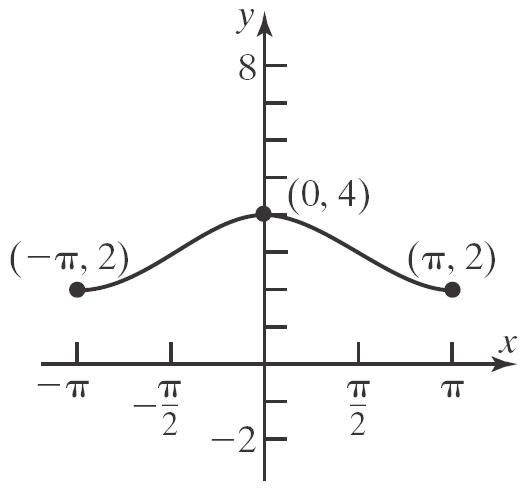
b. ()(2)Gxfx Shift left 2 units.
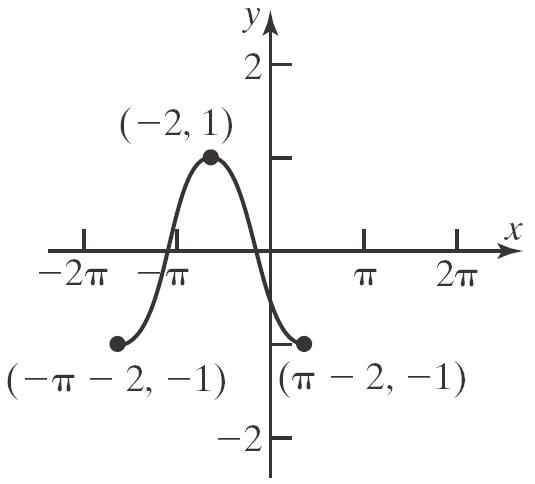
c. ()() Pxfx Reflect about the x-axis.

d. ()(1)2Hxfx Shift left 1 unit and shift down 2 units.

e. 1 ()() 2 Qxfx
Compress vertically by a factor of 1 2 .
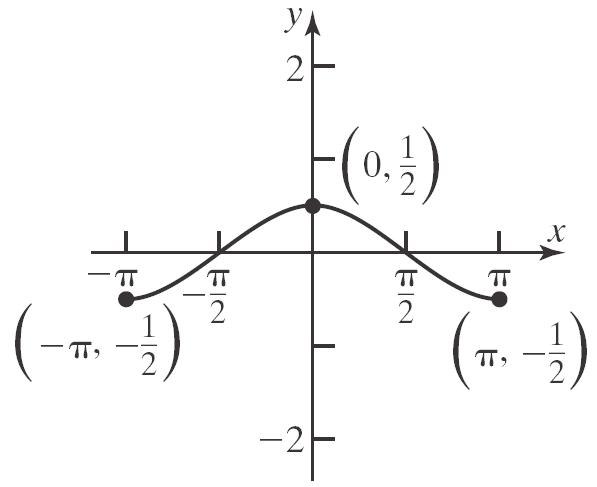
f. ()() g xfx
Reflect about the y-axis.

g. ()(2) hxfx
Compress horizontally by a factor of 1 2 .
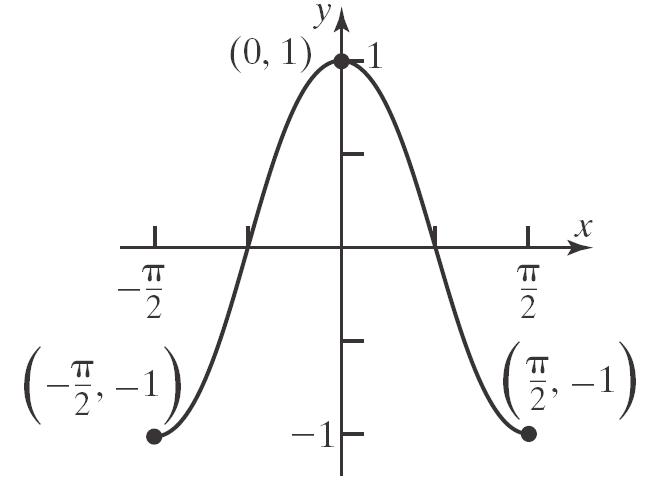
65. 2 ()2 f xxx 2 2 ()(21)1 ()(1)1 fxxx fxx
Using 2 () f xx , shift left 1 unit and shift down
Section 2.5: Graphing Techniques: Transformations
1 unit.
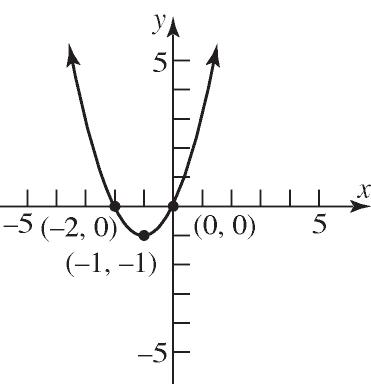
66. 2 ()6 f xxx 2 2 ()(69)9 ()(3)9 fxxx fxx
Using 2 () f xx , shift right 3 units and shift down 9 units.
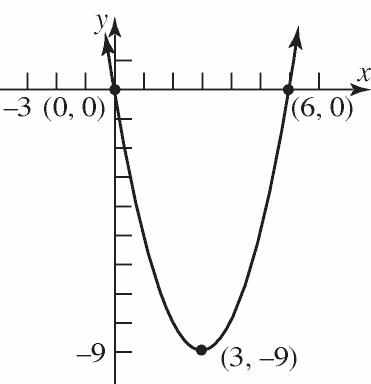
67. 2 ()81 f xxx 2 2 ()816116 ()415 fxxx fxx
Using 2 () f xx , shift right 4 units and shift down 15 units.
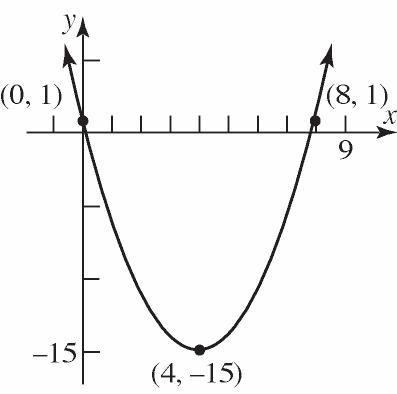
68. 2 ()42 fxxx
2 2 ()4424 ()22 fxxx fxx
Chapter 2: Functions and Their Graphs
Using 2 () f xx , shift left 2 units and shift down 2 units.
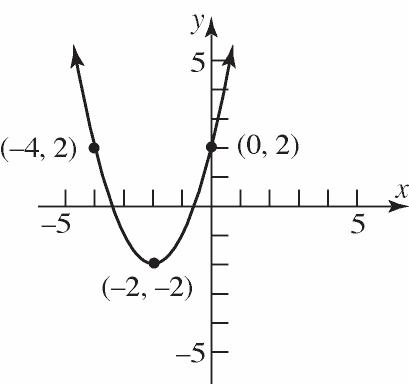
Using 2 f xx , shift right 3 units, vertically stretch by a factor of 2, and then shift up 1 unit.
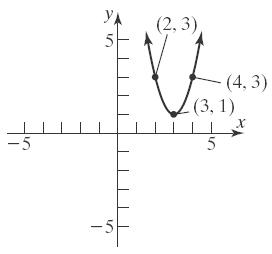
Using 2 f xx , shift left 1 unit, vertically stretch by a factor of 3, and shift down 2 units.
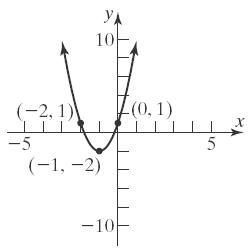
2 2 2 2 31217 3417 3441712 325 fxxx xx xx x
Using 2 f xx , shift left 2 units, stretch vertically by a factor of 3, reflect about the xaxis, and shift down 5 units.
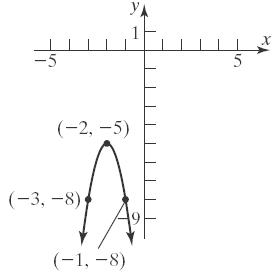
2 2 2 2 21213 2613 2691318 235 fxxx xx xx x
Using 2 f xx , shift left 3 units, stretch vertically by a factor of 2, reflect about the xaxis, and shift up 5 units.
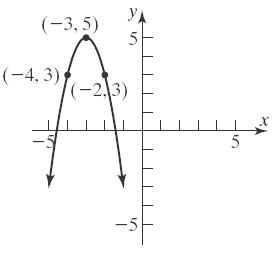
73. a. The graph of 2 yfx is the same as the graph of y fx , but shifted 2 units to the left. Therefore, the x-intercepts are 7 and 1.
b. The graph of 2 yfx is the same as the graph of y fx , but shifted 2 units to
the right. Therefore, the x-intercepts are 3 and 5.
c. The graph of 4 y fx is the same as the graph of y fx , but stretched vertically by a factor of 4. Therefore, the x-intercepts are still 5 and 3 since the y-coordinate of each is 0.
d. The graph of y fx is the same as the graph of y fx , but reflected about the y-axis. Therefore, the x-intercepts are 5 and 3 .
74. a. The graph of 4 yfx is the same as the graph of y fx , but shifted 4 units to the left. Therefore, the x-intercepts are 12 and 3 .
b. The graph of 3 yfx is the same as the graph of y fx , but shifted 3 units to the right. Therefore, the x-intercepts are 5 and 4.
c. The graph of 2 y fx is the same as the graph of y fx , but stretched vertically by a factor of 2. Therefore, the x-intercepts are still 8 and 1 since the y-coordinate of each is 0.
d. The graph of y fx is the same as the graph of y fx , but reflected about the y-axis. Therefore, the x-intercepts are 8 and 1
75. a. The graph of 2 yfx is the same as the graph of y fx , but shifted 2 units to the left. Therefore, the graph of 2 fx is increasing on the interval 3,3 .
b. The graph of 5 yfx is the same as the graph of y fx , but shifted 5 units to the right. Therefore, the graph of 5 fx is increasing on the interval 4,10 .
76.
d. The graph of y fx is the same as the graph of y fx , but reflected about the y-axis. Therefore, we can say that the graph of y fx must be decreasing on the interval 5,1 .
a. The graph of 2 yfx is the same as the graph of y fx , but shifted 2 units to the left. Therefore, the graph of 2 fx is decreasing on the interval 4,5
b. The graph of 5 yfx is the same as the graph of y fx , but shifted 5 units to the right. Therefore, the graph of 5 fx is decreasing on the interval 3,12 .
c. The graph of y fx is the same as the graph of y fx , but reflected about the x-axis. Therefore, we can say that the graph of y fx must be increasing on the interval 2,7
d. The graph of y fx is the same as the graph of y fx , but reflected about the y-axis. Therefore, we can say that the graph of y fx must be increasing on the interval 7,2
77. a. () y fx
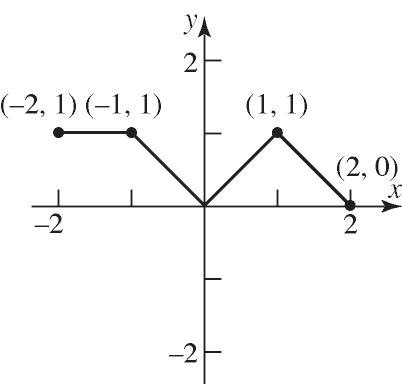
c. The graph of y fx is the same as the graph of y fx , but reflected about the x-axis. Therefore, we can say that the graph of y fx must be decreasing on the interval 1,5
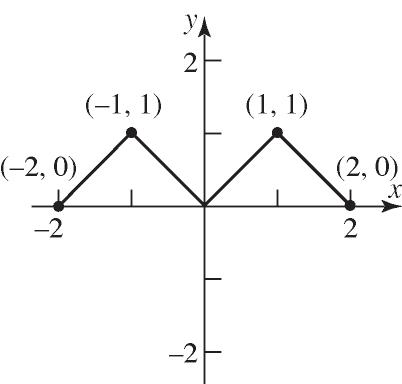
78. a. To graph () y fx , the part of the graph for f that lies in quadrants III or IV is reflected about the x-axis.

b. To graph yfx , the part of the graph for f that lies in quadrants II or III is replaced by the reflection of the part in quadrants I and IV reflected about the yaxis.
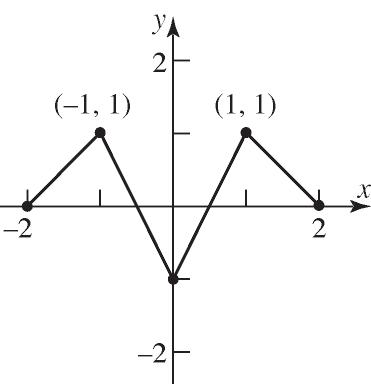
79. a. The graph of 35 yfx is the graph of yfx but shifted left 3 units and down 5 units. Thus, the point 1,3 becomes the point 2,2 .
b. The graph of 221yfx is the graph of yfx but shifted right 2 units, stretched vertically by a factor of 2, reflected about the x-axis, and shifted up 1 unit. Thus, the point 1,3 becomes the point 3,5
c. The graph of 23yfx is the graph of yfx but shifted left 3 units and horizontally compressed by a factor of 2. Thus, the point 1,3 becomes the point
1,3 .
80. a. The graph of 13 ygx is the graph of ygx but shifted left 1 unit and down 3 units. Thus, the point 3,5 becomes the point 4,2
b. The graph of 343ygx is the graph of ygx but shifted right 4 units, stretched vertically by a factor of 3, reflected about the x-axis, and shifted up 3 units. Thus, the point 3,5 becomes the point 1,12
c. The graph of 39ygx is the graph of yfx but shifted left 9 units and horizontally compressed by a factor of 3. Thus, the point 3,5 becomes the point
4,5
81. a. ()int() f xx
Reflect the graph of int()yx about the yaxis.
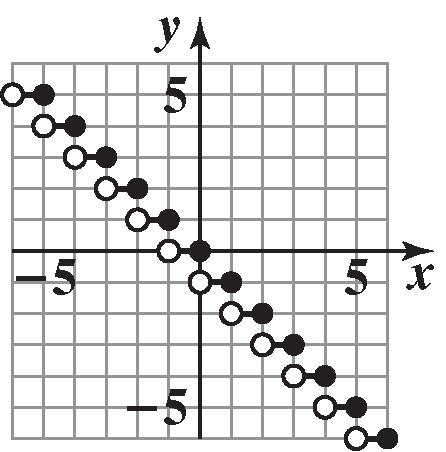
b ()int() g xx
Reflect the graph of int()yx about the xaxis.

82. a. ()int(1)fxx
Shift the graph of int()yx right 1 unit.
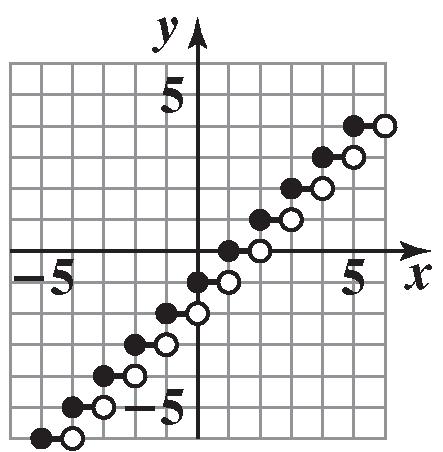
b. ()int(1)int((1)) gxxx
Using the graph of int()yx , reflect the graph about the y-axis int()yx , horizontally shift to the right 1 unit int((1))yx .
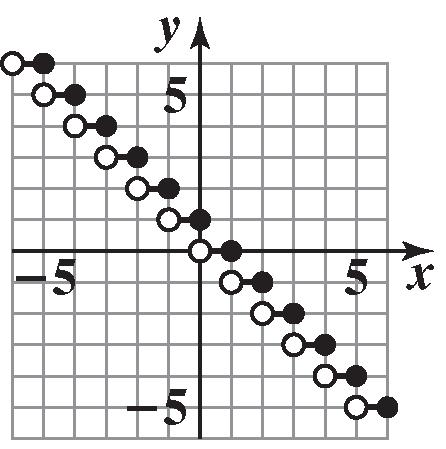
Section 2.5: Graphing Techniques: Transformations
83. a. ()33fxx
Using the graph of y x , horizontally shift to the right 3 units 3 yx and vertically shift downward 3 units 33 yx
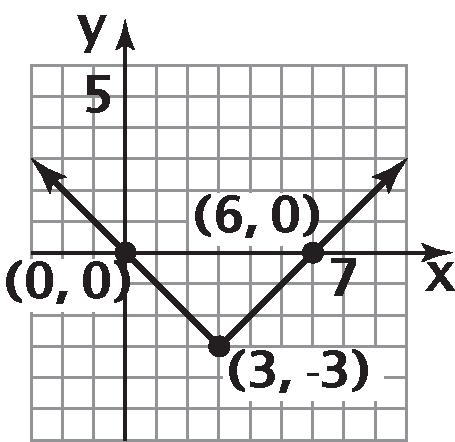
b. 1 2 1 (6)(3)9 2 Abh
The area is 9 square units.
84. a. ()244fxx
Using the graph of y x , horizontally shift to the right 4 units 4 yx , vertically stretch by a factor of 2 and flip on the x-axis 24yx , and vertically shift upward 4 units 244yx .
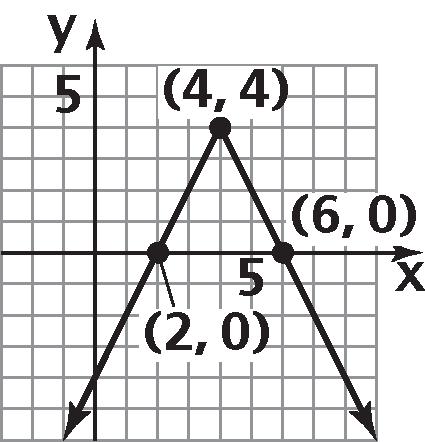
b. 1 2 1 (4)(4)8 2 Abh
The area is 8 square units.
85. a. From the graph, the thermostat is set at 72F during the daytime hours. The thermostat appears to be set at 65F overnight.
b. To graph 2 yTt , the graph of Tt is shifted down 2 units. This change will lower the temperature in the house by 2 degrees.
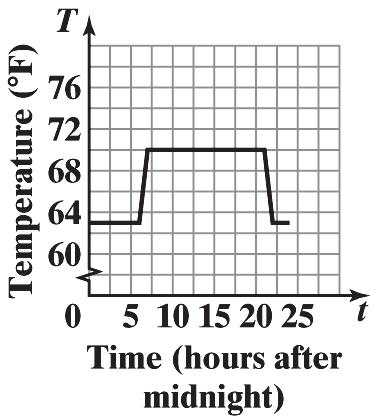
c. To graph 1 yTt , the graph of Tt should be shifted left one unit. This change will cause the program to switch between the daytime temperature and overnight temperature one hour sooner. The home will begin warming up at 5 a.m. instead of 6 a.m. and will begin cooling down at 8 p.m. instead of 9 p.m. 86.
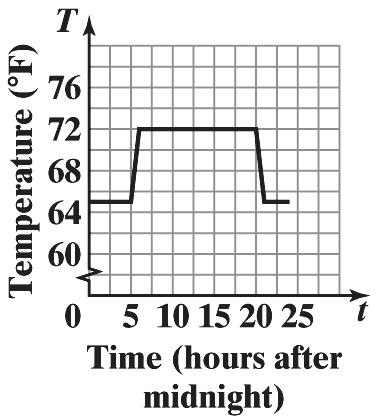
The estimated hours of daylight in
is
The estimated hours of daylight in July is 13.38.
The estimated hours of daylight in December is 13.38.
b. x represents the number of months after July.
c. January corresponds to:
(6)66(0) (0)9.96 F ff f
d. Orlando is in the Northern Hemisphere and Alice Springs is in the Southern Hemisphere; therefore, they have “opposite” seasons in each month. For example, it is winder in Orlando in January while it is summer in Alice Spring.
87. 9 32 5 FC 9 (273)32 5 FK
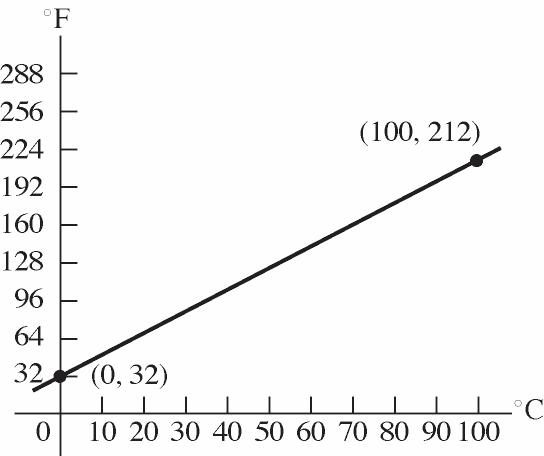
Shift the graph 273 units to the right.
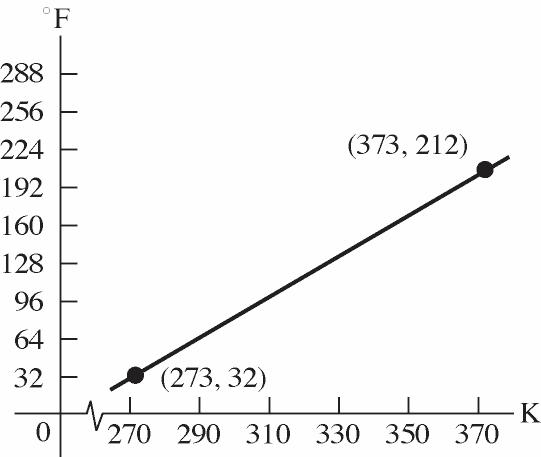
88. a. 2 l T g
b. 1 1 2 l T g ; 2 2 2 l T g ; 3 3 2 l T g
c. As the length of the pendulum increases, the period increases.
d. 1 2 2 l T g ; 2 3 2 l T g ; 3 4 2 l T g
e. If the length of the pendulum is multiplied by k , the period is multiplied by k
89. 2 () y xc 2 2 2 If 0,. If 3,(3); shift right 3 units. If 2,(2); shift left 2 units. cyx cyx cyx

Section 2.5: Graphing Techniques: Transformations
90. 2 y xc 2 2 2 If 0,. If 3,3; shift up 3 units. If 2,2; shift down 2 units. cyx cyx cyx

91. (5)fx is a shift right 5 units; increasing on
2,8 and 16,24 ; decreasing of 8,16 . (25)fx compresses horizontally by a factor of ½; increasing on 1,4 and 8,12 ; decreasing on 4,8 . (25)fx reflects about the x-axis; increasing on 4,8 ; decreasing on 1,4 and 8,12 . 3(25) fx stretches vertically by a factor or 3 but does not affect increasing/decreasing. Therefore 3(25) fx is increasing on 4,8
92. Write the general normal density as 2 11 ()exp 2 2
x fx . Starting with the standard normal density, 2 1 ()exp 2 2
x fx , stretch/compress horizontally by a factor of to get 2 1 ()exp 2 2
x fx 1 multiply all the -coordinates by x , then shift the graph horizontally units (left if 0 and right if 0 ) to get
Chapter 2: Functions and Their Graphs
fx . Then
stretch/compress vertically by a factor of 1 to get
x fx 1 multiply all the -coordinates by
y .
1. Stretch/compress horizontally by a factor or (stretch if 1 )
2. Shift horizontally units (left if 0 and right if 0 ).
3.Stretch/compress vertically by a factor of 1 (compress if 1 )
93. The graph of 4()yfx is a vertical stretch of the graph of f by a factor of 4, while the graph of (4)yfx is a horizontal compression of the graph of f by a factor of 1 4
94. The graph of ()2yfx will shift the graph of ()yfx down by 2 units. The graph of (2)yfx will shift the graph of ()yfx to the right by 2 units.
95. The graph of y x is the graph of y x but reflected about the y-axis. Therefore, our region is simply rotated about the y-axis and does not change shape. Instead of the region being bounded on the right by 4 x , it is bounded on the left by 4 x . Thus, the area of
the second region would also be 16 3 square units.
96. The range of 2 () f xx is 0, . The graph of ()() g xfxk is the graph of f shifted up k units if k > 0 and shifted down k units if k < 0, so the range of g is , k
97. The domain of () g xx is 0, . The graph of () g xk is the graph of g shifted k units to the right, so the domaine of g is , k
98. 3530 5330 3 6 5 xy yx yx
The slope is 3 5 and the y-intercept is -6.
99. The total time run is 13.113.1 8.4214 72 . The total distance is 26.2 mile. Thus the average speed is 26.2 3.11 mph 8.4214 .
100. 74 7 4 77 (9)15.75 gal 44 WkT k
101. 2 4 yx
x-intercepts: y-intercepts: 2 (0)4 04 4 x x x
2 2 04 4 2 y y y
The intercepts are 4,0 , 0,2 and 0,2
Test x-axis symmetry: Let yy
2 2 4 4 same yx yx
Test y-axis symmetry: Let x x 2 4 yx different
Test origin symmetry: Let x x and yy .
2 2 4 4 different yx yx
Therefore, the graph will have x-axis symmetry.
102. The denominator must not be zero. 2 5140 (7)(2)0
So the domain is: |7,2 xxx
103.
Since t represents time the only answer that is reasonable is 7 seconds.
104. 3 335632622 168222 x yzxxyzxyxz
105. 22 222 222 2 ()() 3()2()1(321) 3(2)221321 363221321 62(62) 62
106.
zz zzz
33 3 2 2166 (6)(636)
Section 2.6
1. a. The distance from dP to the origin is 22dxy . Since P is a point on the graph of 2 8 yx , we have: 22242 ()(8)1564 dxxxxx
b. 42 (0)015(0)64648 d
c. 42 (1)(1)15(1)64 1156450527.07 d
d.

e. d is smallest when 2.74 x or when 2.74 x
2. a. The distance from dP to (0, –1) is 22 (1)dxy . Since P is a point on the graph of 2 8 yx , we have:
222 2 2242 ()(81) 71349 dxxx xxxx
b. 42 (0)013(0)49497 d
c. 42 (1)(1)13(1)49376.08 d
4 –4 10 0
e. d is smallest when 2.55 x or when 2.55 x .
5 –5 8 0
c. d is smallest when 1 x or 1 x
3. a. The distance from dP to the point (1, 0) is 22 (1) dxy . Since P is a point on the graph of y x , we have:
2 22 ()(1)1 dxxxxx where 0 x . b. 2 2 0 0
c. d is smallest when 1 2 x d. 2 ()1113 222 dx
4. a. The distance from dP to the origin is 22dxy . Since P is a point on the graph of 1 y x , we have: 2 22 2 11
dd
2 2 11 11 (1)2;(1)2 11
5. By definition, a triangle has area 1 ,base, height. 2 Abhbh From the figure, we know that and .bxhy Expressing the area of the triangle as a function of x , we have:
11134 () 222 A xxyxxx
6. By definition, a triangle has area 1 ,=base, height. 2 Abhbh Because one vertex of the triangle is at the origin and the other is on the x-axis, we know that and .bxhy Expressing the area of the triangle as a function of x , we have:
()9119123 2222 A xxyxxxx
7. a. 2 ()16A xxyxx
b. Domain: 04xx
c. The area is largest when 2.31 x 4 30 0 0

d. The largest area is 2 (2.31)2.31162.3124.63 A square units.
8. a. 2 ()224A xxyxx
b. 2 ()2(2)2()424 pxxyxx
c. Graphing the area equation:
The area is largest when 1.41 x .
d. Graphing the perimeter equation:

The perimeter is largest when 1.79 x .
e. The largest area is 2 (1.41)21.4141.414 A square units. The largest perimeter is
Section 2.6: Mathematical Models: Building Functions
9. a. In Quadrant I, 222 4 4 x yyx 2 ()(2)(2)44A xxyxx
b. 2 ()2(2)2(2)444 pxxyxx
c. Graphing the area equation: 2 10 0 0
The area is largest when 1.41 x
d. Graphing the perimeter equation: 2 12 0 0
The perimeter is largest when 1.41 x .
10. a. 2 ()(2)(2)4A rrrr b. ()4(2)8 prrr
11. a. circumference, total area, radius, side of square CA rx 52 2104 x Crxr 22 squarecircle Total Areaarea+ area x r 2 2 22 52 25204 () x x x Axxx
Chapter 2: Functions and Their Graphs
b. Since the lengths must be positive, we have: 1040 and 0 410 and 0 2.5 and 0
c. The total area is smallest when 1.40 x meters.
12. a. circumference, total area, radius, side of equilateral triangle CA
The height of the equilateral triangle is 3 2 x
b. Since the lengths must be positive, we have: 1030 and 0 310 and 0 10 and 0 3 xx xx xx
c. The area is smallest when 2.08 x meters. 3.33
13. a. Since the wire of length x is bent into a circle, the circumference is x . Therefore, () Cxx
b. Since 2, 2 x Cxrr 2 2 2 () 24 x x Axr
14. a. Since the wire of length x is bent into a square, the perimeter is x . Therefore, () pxx .
b. Since 1 4, 4 Pxssx , we have 2 22 11 () 416 A xsxx
15. a. area, radius; diameter2 A rr 2 ()(2)()2A rrrr
b. perimeter p ()2(2)26 prrrr
16. circumference, radius; length of a side of the triangle Cr x
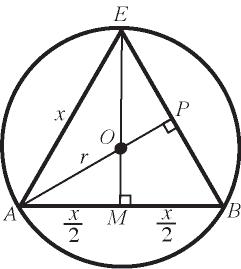
Since ABC is equilateral, 3 2 x EM .
17.
Therefore,
20. radius of cylinder, height of cylinder, volume of cylinder rh
21. radius of cylinder, height of cylinder, volume of cylinder rh V
By similar triangles: HHh Rr HrRHh HrRHRh
22. a. The total cost of installing the cable along the road is 500 x . If cable is installed x miles along the road, there are 5 x miles between the road to the house and where the cable ends along the road.
Chapter 2: Functions and Their Graphs
2 d 5 x x 22 22 (5)2 251041029 dx xxxx
The total cost of installing the cable is: 2 ()5007001029 Cxxxx
Domain: 05xx
b. 2 (1)5001700110129
50070020$3630.50
c. 2 (3)5003700310329
15007008$3479.90
d.

e. Using MINIMUM, the graph indicates that 2.96 x miles results in the least cost.
23. a. The time on the boat is given by 1 3 d . The time on land is given by 12 5 x
The total time for the trip is:
b. Domain:
c. 2 12444 (4) 53 820 3.09 hours 53 T
24. a. Let amount of material A , length of the base x , height h , and volume V . 2 2 10 10
25.
d. 2 1 40 yx x

The amount of material is least when 2.71 x
e. The largest area is
a. length = 242 x ; width = 242 x ; height = x
()(242)(242)(242) Vxxxxxx
b. 22 3 (3)3(242(3))3(18) 3(324)972 in.
c. 22 3 (10)10(242(10))10(4) 10(16)160 in.
d.

The volume is largest when 4 x inches.
e. The largest volume is (4)4(242(4))102423 in
Section 2.6: Mathematical Models: Building Functions
26. Consider the diagrams shown below.
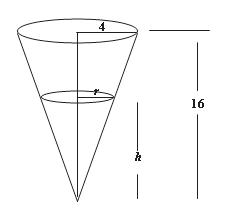
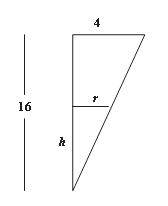
There is a pair of similar triangles in the diagram. This allows us to write 411 1644
Substituting into the volume formula for the conical portion of water gives
27. a. The total cost is the sum of the shipment cost, storage cost, and product cost. Since each shipment will contain x units, there are 600/x shipments per year, each costing $15.
So the shipment cost is 6009000 15 =.
The storage cost for the year is given as 1.60. x The product costs is 600(4.85)2910. So, the total cost is 9000 ()1.602910.
Cxx x
28.
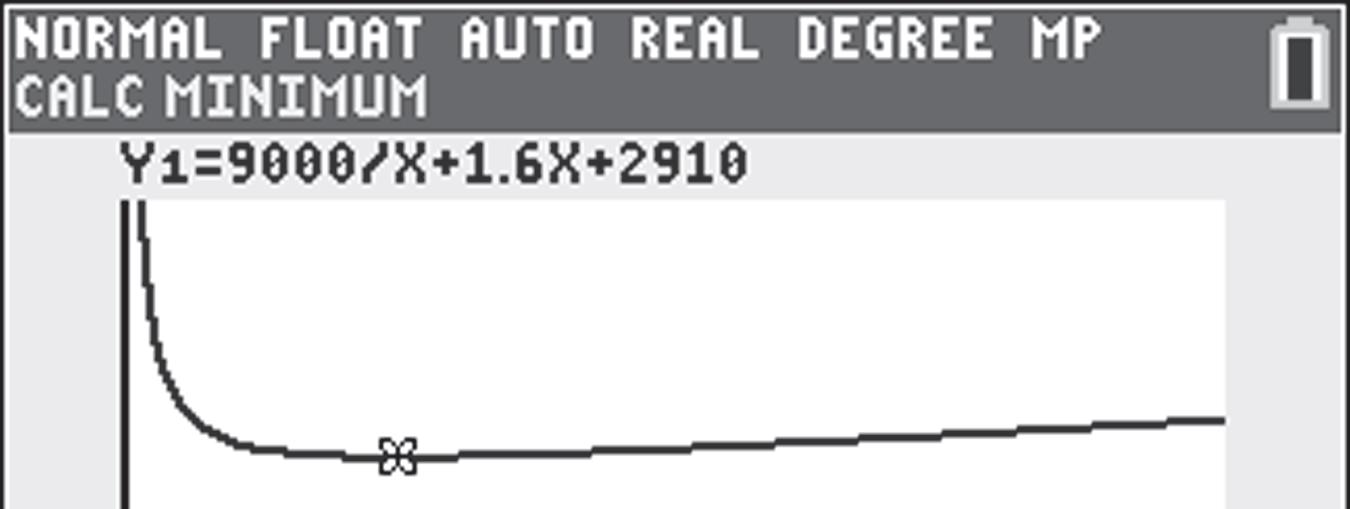
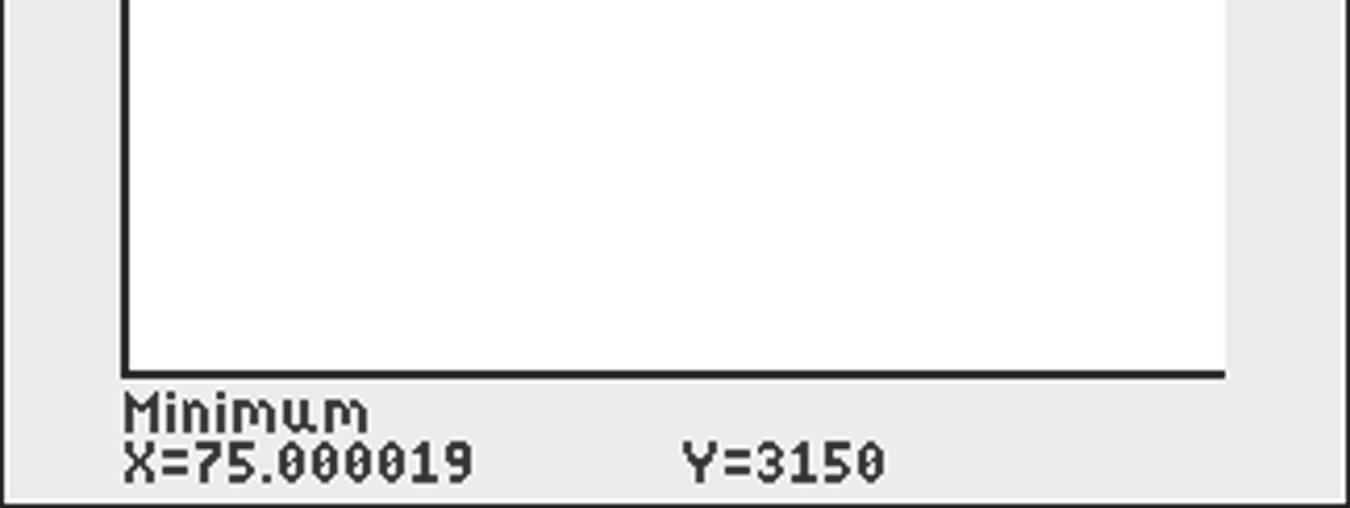
The retailer should order 75 drives per order for a minimum yearly cost of $3150.
The solution set is
0,3
29. In order for the 16-foot long Ford Fusion to pass the 50-foot truck, the Ford Fusion must travel the length of the truck and the length of itself in the time frame of 5 seconds. Thus the Fusion must travel an additional 66 feet in 5 seconds.
Convert this to miles-per-hour. 551 5 sec min hr hr.
Since the truck is traveling 55 mph, the Fusion must travel 55 + 9 = 64 mph.
No solution since a square root cannot be negative.
35. Since the graph is symmetric is symmetric about the origin then (3, -2) is symmetric to (-3, 2).
xxx xx bac
37. 2 2 22 3742 31120 4(11)4(3)(2) 1212497
Chapter 2 Review Exercises
1. a. Domain {8, 16, 20, 24} Range {$6.30, $12.32, $13.99}
b. {(8,$6.30), (16,$13.99), (20,$12.32), (24,$13.99)}
c.


d.
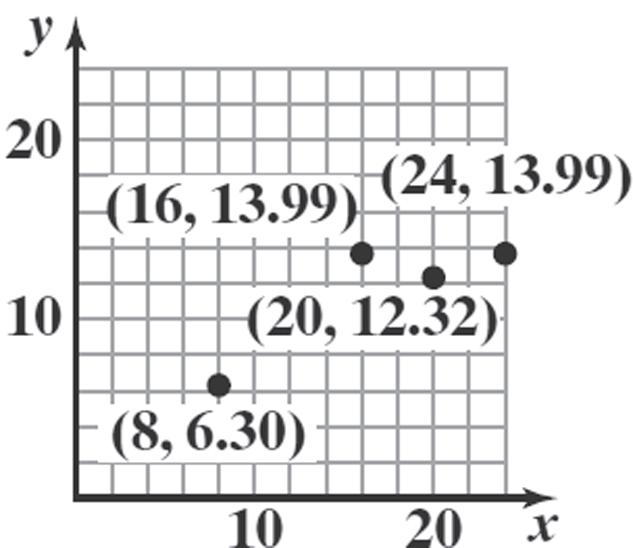
2. This relation represents a function. Domain = {–1, 2, 4}; Range = {0, 3}.
3. Domain {2,4}; Range {-1,1,2} Not a function
4. not a function; domain [-1, 3]; range [-2, 2]
5. function; domain: all real numbers; range
3,
6. 2 3 () 1 x fx x
a. 2 3(2) 66 (2)2 413 (2)1 f
b. 2 3(2) 66 (2)2 413 (2)1 f
c. 22 3() 3 () ()11 x x fx xx
Chapter 2 Review Exercises
d. 22 33 () 11 x x fx xx
e. 2 22 3(2) (2) (2)1 32 36 44143 x fx x x x xxxx
f. 22 3(2) 6 (2) (2)141 x x fx xx
7. 2 ()4fxx
a. 2 (2)244400 f
b. 2 (2)244400 f
c. 22 ()()44 fxxx
d. 2 ()4fxx
e. 2 2 2 (2)(2)4 444 4 fxx xx xx f. 22 22 (2)(2)444 4121 fxxx xx
8. 2 2 4 () x fx x
a. 2 2 24440 (2)0 44 2 f
b. 2 2 24 440 (2)0 44 2 f
c. 2 2 22 ()4 4 () () x x fx x x
d. 222 222 444 () xxx fx x xx
e. 2 2 22 2 22 (2)4 444 (2) (2)(2) 4 4 (2)(2) x xx fx xx xx xx xx
Chapter 2: Functions and Their Graphs
f. 2 2 22 2 2 22 (2)4 44 (2) (2)4 41 1 4 x x fx x x x x xx
9. 2 () 9 x fx x
The denominator cannot be zero: 2 90 (3)(3)0 3 or 3 x xx x
Domain: 3,3xxx
10. ()2 f xx
The radicand must be non-negative: 20 2 x x
Domain: 2 or ,2 xx
11. () x gx x
The denominator cannot be zero: 0 x
Domain: 0 xx
12. 2 () 23 x fx xx
The denominator cannot be zero:
Domain:3, 1 xx xx x xxx
2 230 310 3 or 1
13. 2 1 () 4 x fx x
The denominator cannot be zero: 2 40 220 2 or 2 x xx x
14. () 8 x fx x
The radicand must be non-negative and not zero: 80 8 x x
Domain: 8 xx
15. ()2()31 f xxgxx
()()() 23123 fgxfxgx x xx
Domain: is any real number xx ()()() 231 231 41 f gxfxgx xx xx x
Domain: is any real number xx
2 2 ()()() 231 623 352 fgxfxgx xx x xx xx
Domain: is any real number xx
2 () 31 fx f x x g x gx
310 1 31 3 x xx 1
Domain: 3 xx
16. 2 ()31()3 f xxxgxx 2 2 ()()() 313 341 fgxfxgx x xx xx
Domain: is any real number xx 2 2 ()()() 313 321 fgxfxgx x xx xx
Domain: is any real number xx
Domain: 1,22,
Also, the radicand must be non-negative: 10 1 x x
18. 2 ()21 f xxx
19. a. Domain: 43xx ;
b. Intercept: 0,0
Domain:
Domain: 0,1xxx
1 (1) 1 1 () 1 111 x fx fxx xx x x gxx gx x
Domain: 0,1xxx
3,3
c. 21 f
d. 3 fx when x = –4
e. ()0fx when 03 x |03xx
f. To graph 3 yfx , shift the graph of f horizontally 3 units to the right.
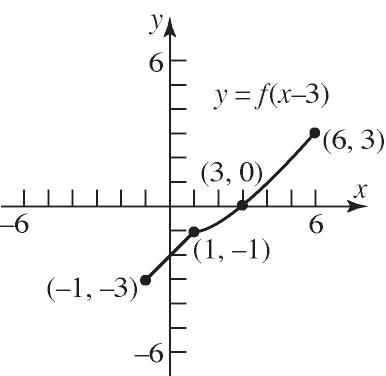
Chapter 2: Functions and Their Graphs
g. To graph 1 2 yfx , stretch the graph of f horizontally by a factor of 2.

h. To graph y fx , reflect the graph of f vertically about the y-axis.
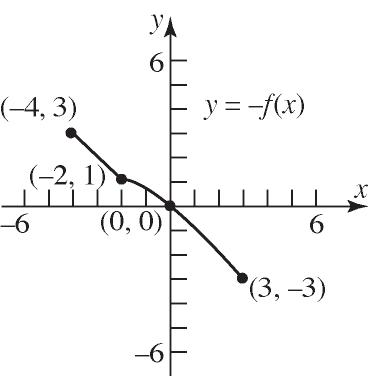
20. a. Domain: ,4 Range: ,3
b. Increasing: ,2 and 2,4 ; Decreasing: 2,2
c. Local minimum is 1 at 2 x ; Local maximum is 1 at 2 x
d. No absolute minimum; Absolute maximum is 3 at 4 x
e. The graph has no symmetry.
f. The function is neither.
g. x-intercepts: 3,0,0,0,3,0 ; y-intercept: (0,0)
21. 3 ()4 f xxx 33 3 ()()4()4 4() f xxxxx xxfx
f is odd.
22. 2 4 4 () 1 x gx x 2 2 44 4() 4 ()() 1()1 x x g xgx xx g is even.
23. 3 ()1 Gxxx 3 3 ()1()() 1() or () Gxxx x xGxGx G is neither even nor odd.
24. 2 () 1 x fx x 22 ()() 1()1 xx f xfx xx f is odd.
25. 3 251fxxx on the interval 3,3
Use MAXIMUM and MINIMUM on the graph of 3 1 251 y xx 20 33 20 20 33 20 local maximum value: 4.04 when 0.91 x local minimum value: 2.04 when 0.91 x f is increasing on: 3,0.91 and 0.91,3 ; f is decreasing on: 0.91,0.91 .


26. 43 2521fxxxx on the interval 2,3
Use MAXIMUM and MINIMUM on the graph of 43 1 2521 y xxx . 2 20 3



local maximum: 1.53 when 0.41 x
